Gold, Guns and God, Vol. 8: The City of God
A Biography of Swami Bhaktipada and a History of the West Virginia New Vrindaban Hare Krishna Community in Ten Volumes, by Henry Doktorski
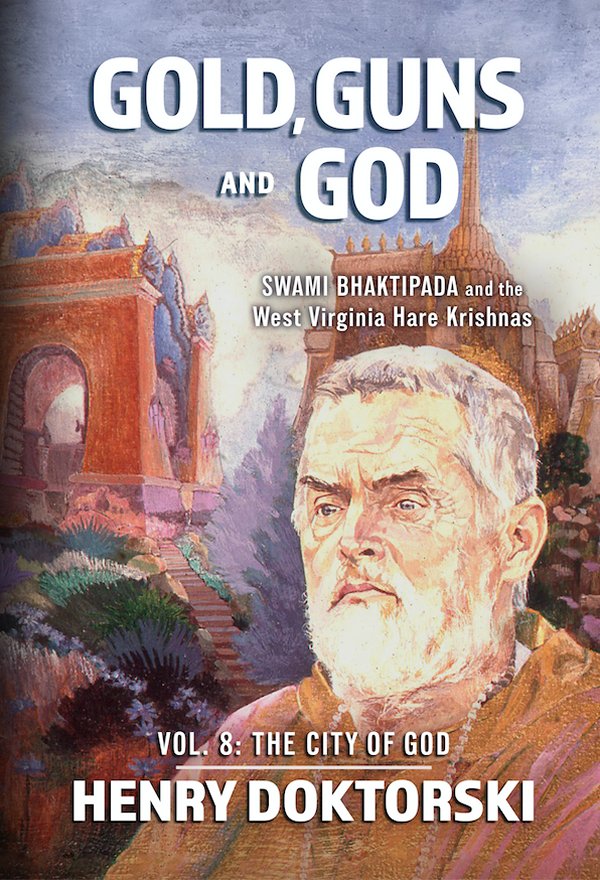
Gold, Guns and God, Vol. 8 front cover

Gold, Guns and God, Vol. 8 front and back cover
Henry Doktorski’s landmark 529-page non-fiction book about Swami Bhaktipada and the West Virginia Hare Krishna commune called New Vrindaban, can be purchased in several ways:
(1) Save money and purchase directly from the author: Send a check or money order (or use PayPal or Venmo) for $19.99 (includes shipping to anywhere in the United States). Send an email to the author and request address. Credit card payments must go through PayPal or Venmo. Send PayPal payment to the author at the e-mail address listed below. Canadian and overseas customers can pay with Western Union and must inquire directly from the author regarding shipping prices.

(2) Purchase from eBay here.
(3) In USA, purchase from Amazon.com.
(4) In Canada, purchase from Amazon.ca.
(5) In Mexico, purchase from Amazon.com.mx.
(6) In Brazil, purchase from Amazon.com.br.
(7) In Great Britain, purchase from Amazon.co.uk.
(8) In France, purchase from Amazon.fr.
(9) In The Netherlands, purchase from Amazon.nl.
(10) In Spain, purchase from Amazon.es.
(11) In Germany, purchase from Amazon.de.
(12) In Italy, purchase from Amazon.it.
(13) In Japan, purchase from Amazon.jp.
(14) In Australia, purchase from Amazon.com.au.
(15) In India, purchase from Amazon.in.
(16) Kindle readers, purchase from Amazon Kindle.
In addition, please “Like” Books by Hare Krishna Historian Henry Doktorski on Facebook!
SUMMARY: Volume 8—THE CITY OF GOD
Volume eight of Gold, Guns and God tells the story of Swami Bhaktipada and his vision to de-Indianize, or Westernize, Krishna consciousness in an effort to make it more palatable to westerners. He incorporated various aspects of western and Christian culture into the temple liturgies and daily life of New Vrindaban residents, such as translating the Sanskrit and Bengali prayers into English for temple services, and asking disciples and followers to wear unisex orange-colored garments, something like Franciscan monks’ robes, not shaving the head nor beard for men. He also commissioned new tunes in a Western classical style for the English Vaishnava prayers, which were sung daily at temple services. A pipe organ was purchased, and a choir and temple orchestra was created, as well as a children’s choir, Gospel band, folk music ensembles, and even a rock band.
Bhaktipada advocated chanting the mahamantra in English and chanting silently in the dark. Women were initiated into the renounced order of sannyasa, an honor and responsibility previously only accorded to men. A life-size statue of Jesus Christ sitting in a lotus posture was commissioned and installed next to the murti of Bhaktivedanta Swami Prabhupada in the temple on Christmas Day 1988.
Bhaktipada also envisioned an interfaith City of God at New Vrindaban, and at eleven other locations around the world, in which all religions would be recognized and respected. For a few years New Vrindaban included about a dozen interfaith residents: Marion Catholics, a Unitarian minister, and others, who wanted to help build a City of God in West Virginia. The design of the Temple of Understanding also changed from a traditional South-Indian Dravidian style (1985) to a modernistic edifice with Native American influences (1990). In November 1990, a giant forty-foot tall statue of Bhaktivedanta Swami Prabhupada wearing a turban and sitting in the lotus position was constructed in the proposed “Garden of the Spiritual Masters” behind the Palace.
Bhaktipada’s liturgical reforms and emphasis on interfaith preaching attracted some people to come and live at New Vrindaban, but they also alienated some residents and visitors who were attached to the Bengali-style which Bhaktivedanta Swami Prabhupada advocated. The Interfaith Era at New Vrindaban lasted about eight years, from 1986 to 1994. The reasons for its dissolution will be described in detail in Gold, Guns and God, Vol. 9.
Preface to Gold, Guns and God, Vol. 8
Foreword to Gold, Guns and God, Vol. 8
Passion on the Edge: Love and Marriage Amongst the Hare Krishnas—A Case Study
Recordings of music at New Vrindaban
Yamini’s Krishna Book Suite (1980)
Vaiyasaki dasa and the New Vrindaban Gurukula Boys (1981)
Ragamathani devi dasi Sings Bhajans (c. early 1980s)
Hrishikesh dasa chants Jaya Jagad Guru Srila Bhaktipada at New Vrindaban (November 6, 1985)
Bhaktipada’s Vyasa Puja (September 1, 1986)
The First Krishna Chorale Concert (January 5, 1987)
Ragamathani’s Voice Recital (November 17, 1987)
New Vrindaban Bhajans: Hrishikesh Das and Shyama Dasi (1988)
The cassette Jagad Guru by the Krishna Chorale (1988)
The cassette Blessed Assurance by the Krishna Chorale (1988)
Morning Program at New Vrindaban (c. October/November 1988)
All Creatures: Noon Service at New Vrindaban (c. October/November 1988)
Evening Service at New Vrindaban (c. October/November 1988)
Hare Krishna Über Alles, a hymn by Hayagriva dasa (c. 1989)
70 Krishna-ized Christian Hymns (c. 1989)
Holy Father, Holy Mother, a hymn by Hayagriva and Swami Bhaktipada (January 1990)
Interfaith Festival at New Vrindaban (May 1990)
Cello/Accordion recital at Music at the Palace (August 4, 1990)
Music at the Palace Accordion Recital (August 28, 1990)
Journey to the City of God, a musical (October 1990)
Accordion/Organ Concert at St. Matthew Episcopal Church, Wheeling (October 1990)
Prabhupada’s Journey to America, a musical (November 1990)
Two Buddhist Chants to Goddess Quan Yin (June 19, 1991)
Flute/Cello/Harpsichord-Accordion Trio Performs at Prabhupada’s Palace (October 13, 1991)
The New Vrindaban Hymnal (1992)
The First Performance of New Vrindaban’s Ideational Choir (February 1992)
Ideational Music: Gaur Aroti and Prayers to Lord Nrsimhadeva (1992)
Radhanath Swami: Transcendental Meditation cassette (1992)
Pushers of Love, cassette by New Vrindaban’s Rock Band (1992)
Simply Wonderful Bhajans, a cassette by the students of New Vrindaban (c. 1996)
Within Vrindaban’s Woods and Groves (2005 concert version)
TABLE OF CONTENTS—VOLUME 8: The City of God
Chapter 77: The Great Experiment
Indian culture reigned supreme at New Vrindaban from 1968-1985
Uniting East and West
A 19-point plan for uniting East and West
Precedents for Bhaktipada’s reforms
Early attempts to Christian-ize Krishna consciousness
The Love Feast
Interfaith preaching
Prabhupada’s crown
Christ and Krishna
Krishna-izing the classics
Shakespeare Krishna-ized
Conversation with Tamal-Krishna Goswami about Krishna-izing the classics
Vyasa-puja Gloria
Chapter 78: Uniting East and West
Cultural conquest
Music “must be related to God”
Music in ISKCON
Apple Record’s Govindam Prayers
Chapter 79: Krishna-izing the Classics
(1) Bhaktipada was an expert preacher of Vaishnava philosophy
(2) Bhaktipada was well-versed in Christianity
(3) Bhaktipada appreciated music and the fine arts
(4) Bhaktipada had an army of workers to help manifest his vision
Krishna-izing the classics: Bach, Beethoven, Brahms
Chapter 80: The Krishna Chorale
Vaishnava instrumental music: an oxymoron
Bhaktipada speaks to me about starting a New Vrindaban choir and orchestra
Birth of the New Vrindaban choir
Jagad Guru
Bhaktipada’s crown
Choir rehearsals begin
Handel’s Krishna-ized Messiah
The choir’s first public performance
Merry Christmas From Krishna
First full-length concert
“I can see your future, all bright and full of hope”
Bhaktipada’s 50th Birthday Party
Krishna-ized hymns
Vyasa-puja celebration, September 1987
“I want a chamber music concert at my house every Sunday!”
The Krishna Chorale cassettes
Moundsville Daily Echo review
Chapter 81: The Advent of Jesus Christ in the Temple
Bhakti common to many religions
The Aquarian Gospel
Prabhupada said Christ could be worshiped in an ISKCON temple
Jesus Christ appears at New Vrindaban
New initiates receive English names
New Vrindaban singers debut with Wheeling Symphony and Chorus
Hayagriva’s hymn: “Holy Father, Holy Mother”
Chapter 82: Accordions, Organs and Music at the Palace
Accordions debut at the Wheeling City of Lights parade
Accordions on tour
The organs
The organ and ISKCON
“I’m going to build the largest pipe organ in the world!”
The first organ: electronic “home” model
The second organ: Möller pipe organ
The third organ: Allen electronic church organ
The Möller organ is finally installed properly
Organ specifications
Placement of Möller organ made it sound sluggish and muddy
The first Music at the Palace season
The second Music at the Palace season
Dasanudas Babaji, flutist
Baroque trip plays Bach “Polka”
Chapter 83: The Temple Orchestra and Music Theater
Timpani
Accordions
Strings
Brass, woodwinds, percussion
Harps
Appreciations
Bhaktipada’s 53rd birthday party
Music Theater
Devotee's Journey to the City of God
The Journey to America
Chapter 84: The Liturgies
Bhaktipada preferred vernacular languages
Bhaktivinoda Thakur recommended modifying forms of worship
Vaishnavas historically preferred vernacular languages
Bhaktivedanta Swami Prabhupada approved of prayers in English
Chanting the mahamantra in English
Using clickers instead of beads to count mantras
“The teacher has to consider time, candidate, and country”
The morning service is translated into English
Mudakari devi dasi revises translation
Hayagriva and Umapati Swami: master poets
Hayagriva’s Gurudev Song
Cathedral hymnals
The morning service
The noon service
Bhoga-aroti: Krishna’s lunchtime pastimes
All Creatures of Our God and King
Siksastaka Prayers
Krishna-ized hymns
I Surrender All
The evening service
The Aroti of Sri Gaur Hari
Blest Be the Tie that Binds
English prayers chanted in all Bhaktipada’s temples
English liturgies: “celestial and uplifting”
The passing of Hayagriva Swami
Chapter 85: Ideational Music
Three cyclical ages of humankind
Bhagavad-gita: the three modes
Ideational music darshan
Ideational music choir commissioned
Chapter 86: Christian-Style Robes and Women sannyasis
1987 Freedom Tour impresses on Bhaktipada the need for more acceptable garb
“The garments we wear is a detail”
The first Christian-style robe
“Women’s day” at the temple
Women can become gurus
Bhaktipada’s first female sannyasa disciple
Sannyasa for women
First women’s sannyasi initiations
ISKCON criticizes women sannyasa initiations
Sannyasinis inspired
Chapter 87: Silent Meditation
Three types of japa: oral, whispered and mental
Silent japa difficult for beginners
Vrindaban babajis chant silently
Bhaktipada defends silent chanting
Guided meditation
Japatation
Spiritual ecology
Chapter 88: Interfaith Preaching
Rabbi Gelberman
Brother Daniel
Bhaktipada preaches interfaith
Darshan on interfaith
Interfaith in India
Tapahpunja preaches interfaith in prison
Native American influence at New Vrindaban
Native American sacred rock lodge
Marathon monks
Seven principles of interfaith
Prabhupada and interfaith
Interfaith living
New Vrindaban interfaith residents
Chapter 89: The Proposed Cathedral of the Holy Name
Granite out, bronze in
New design: “An unbelievable out-of-this-world temple”
Cathedral of Healing: temple, hospital and health spa—all under one roof
Cathedral of the Holy Name: Native American influence prominent
Chapter 90: The Interfaith Cities of God
Bhaktipada’s dream of the City of God
Millenarianism at New Vrindaban
Official announcement sent to media
County officials skeptical
New Vrindaban holds sacrifice to stop alleged forthcoming earthquake
New Vrindaban announces wall construction
The “de-motorization” of New Vrindaban
Three stages of purification
Prabhupada instilled the millenarianism spirit in his disciples
The twelve proposed Cities of God
Chapter 91: The City of God Media Circus
The proposed Palace of God in Atlantic City
The proposed City of God near Trenton, New Jersey
Donald Trump invited
The proposed City of God in the Poconos
Press conference
Overflow crowd attends town meeting
Members of Cult Awareness Network speak
Ku Klux Klansmen rally against the Krishnas
Proposed Jim Thorpe City of God abandoned
Bhaktipada’s real reason for coming to Jim Thorpe
ISKCON leaders saw through Bhaktipada’s ruse
Proposed Cities of God in Minnesota, Scranton Pennsylvania, Wisconsin and Arizona
Scranton amusement park
Proposed West Virginia State Penitentiary purchase
Proposed Golden Gate Bridge purchase
Promoting the City of God
The City of God hardly peaceful
New York City Sanctuary
Brooklyn League of Devotees
The Interfaith Sanctuary
Chapter 92: Bhaktipada’s Rule and the Giant Prabhupada Statue
Concept of the Rule
Devotees’ daily schedule
40-foot-tall giant Prabhupada statue erected behind the Palace
Monumental Jesus Christ statue planned
Marriages of State
Gay marriage?
Bhaktipada’s reforms inspire New Vrindaban residents
Bhaktipada’s reforms inspire Western guests
Bhaktipada’s reforms inspire some Indian guests
Bhaktipada’s reforms inspire at least one ISKCON devotee
Bhaktipada’s reforms inspire interfaith visitors
Uniting East and West
READERS’ LETTERS
October 7, 2022
Dear Henry,
After reading your proof copy of Gold, Guns and God, Vol. 8, all I can say is, that’s a lot of music! I’m fascinated by the musical ambitions and the installation of the pipe organs. It’s insane to read all this went on Henry. Actually, baffling.
What I mean is: I had no idea how elaborate the music program became in New Vrindaban during your tenure there, and especially after New Vrindaban was expelled from ISKCON in 1987-1988. Between getting those pipe organs, the chorale, the orchestra, the music theater, and how much you were performing, I’m amazed.
Honestly, this volume is the first time that Keith Ham is becoming human again, from my perspective. I’ve been too quick to take the easy road and just call him a sick man, a child molester or a master manipulator; this in spite of the fact he was proven to be all the aforementioned. However, these musical endeavors, his attempt to blend religious traditions, and his work in creating an interfaith City of God suddenly makes sense. His intentions were clearly more noble than I originally thought.
It feels like you’ve opened my mind. Keith, from the beginning, was a proven deviant who disobeyed Srila Prabhupada, so I have always dismissed him as such. His ideas about Christian-izing Krishna consciousness and making it more accessible to westerners is not as crazy as I originally thought. Especially after reading the Foreword to Volume 8 by Patrick Garrison.
Clearly Keith’s ideas were endearing to many, and for good reason. One of your greatest contributions to this monumental biography/history is that you present multiple perspectives. Hats off to you. The result is that you’ve opened my (sometimes) closed mind. It’s been too easy to discard Keith as a “crazy man.” But you’ve mentioned over and over in your works that humans are way more complex than a simple label.
I reflect on the fact that the more evil any one person is perceived to be, the easier it is to lazily discard and label said person as evil or crazy and be done, instead of developing a curiosity and asking why, or looking into the complexity of a person’s character. It took eight volumes, but you finally did it!
Pedro Ramos
Atlanta, Georgia
January 18, 2023
Subject: New Vrindaban Recordings
Hello Henry,
Thank you for uploading the vintage New Vrindaban interfaith musical recordings on YouTube. I have been listening to them for many days now. I have to say they are a real eye opener. I had no idea what this experimental era of New Vrindaban sounded like. I saw the photos and read the stories of this time era, but hearing what you were actually doing really changes things. For some reason I never thought the Western classical music at the City of God would be so technically proficient and, well. . . musically convincing.
I think you were really on to something with this musical approach to presenting the Vaishnava philosophy within the framework of Western tonality. I hate to say this, as it seems to reflect well on Kirtanananda, but maybe on this idea he was correct.
I also purchased your book, Gold, Guns and God, Vol. 8. Looking forward to reading more about this era of New Vrindaban.
Best Regards,
JJD
Jersey City, New Jersey
P.S. The Ragamathani devi dasi recordings are extremely beautiful and sincere. The reworking of the classic themes are quite successful and many moments of her recital are very moving. The children’s bhajans are wonderful, but knowing the history: sad and tragic.
February 22, 2023
I bought GGG8. Very Interesting book Henry. I learned a lot about those times and your contributions. So many misunderstandings from this era.
Thanks for describing the circumstances about that crown and scepter made for Kirtanananda Swami. I always got the impression KS wore that around New Vrindaban, not only for that photograph.
I also had no idea Govinda Maharaja from the Chaitanya Sarawat Math met KS during the time you mentioned. Find that very strange.
They should have left the giant Prabhupada sculpture/murti. That was kind of novel!
Best Regards,
JJD
Jersey City, New Jersey
August 26, 2023
Haribol! I am a kind of a self taught aspiring musician who wants to sing and play spiritual music. And I also want to become a pure devotee. I just discovered your webpage about music in ISKCON, Music of the Gaudiya Vaishnavas. And I just listened to your recording of Within Vrindaban's Woods and Groves.
OH WOW!!!! MY GOD that must have been such wicked times at New Vrindaban! Vrindaban's Woods and Grooves. My GOD so wicked!!!! Whole damn spiritual orchestra!!!! and so amazingly orchestrated and arranged to the Jai Radha Madhava tune.
How much I envy you. All of this spiritual taste you had there, at least that's how it looks and sounds to me. It's just beyound all possible understanding how such an amazing pure and wicked spiritual ecstatic surroundings (New Vrindaban) could produce so many disturbances as history has shown.
But my goodness, tell me please, you must have been flowing in an amazing spiritual atmosphere for so long all of you there. It must have been impossible to build and create all of this out of nothing, surely there was Godly Angelic interventions as well. The demons had to take a part in that scene to destroy all of what had been created. So many intelligent and creative souls that has been attracted to the movement. My God, Prabhu!!!
Tell me, still within the depths of your heart you must feel that this Vedic message of bhakti, the ecstasy coming from the congregational devotion is the utmost and superior thing in this universe.
Ha ha! After reading more from your page, now I realise that you were performing this music every "god damn" morning during aratis!!!
You were a bunch of quite crazy and outstanding folks trying to combine the western musical culture with bhakti. I just wonder, since as I think you must have been quite different from all the other ISKCON temples, as I understand where all the aratis were conducted to the ragas and Vedic style of playing and singing that was introduced by Prabhupada.
PS. Those must have been really wicked days at New Vrindaban!
Haribolsky!!!
Robert Blaszczk
Warsaw, Poland
Photo Gallery
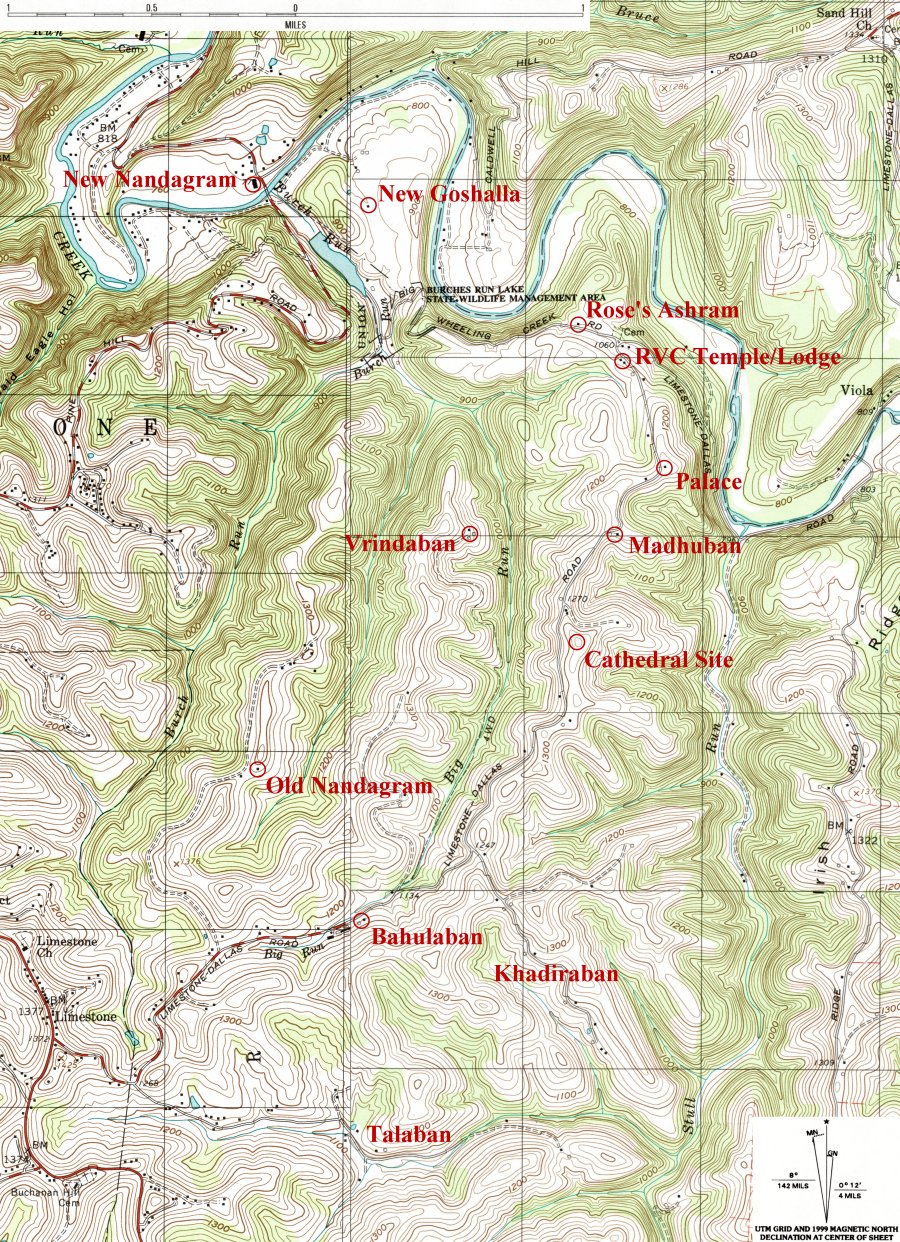
U. S. Geological Survey topographic map of McCreary Ridge showing location of principle sites of New Vrindaban.

His Divine Grace A. C. Bhaktivedanta Swami Prabhupada in the pavilion on the hill behind Bahulaban (September 1972).
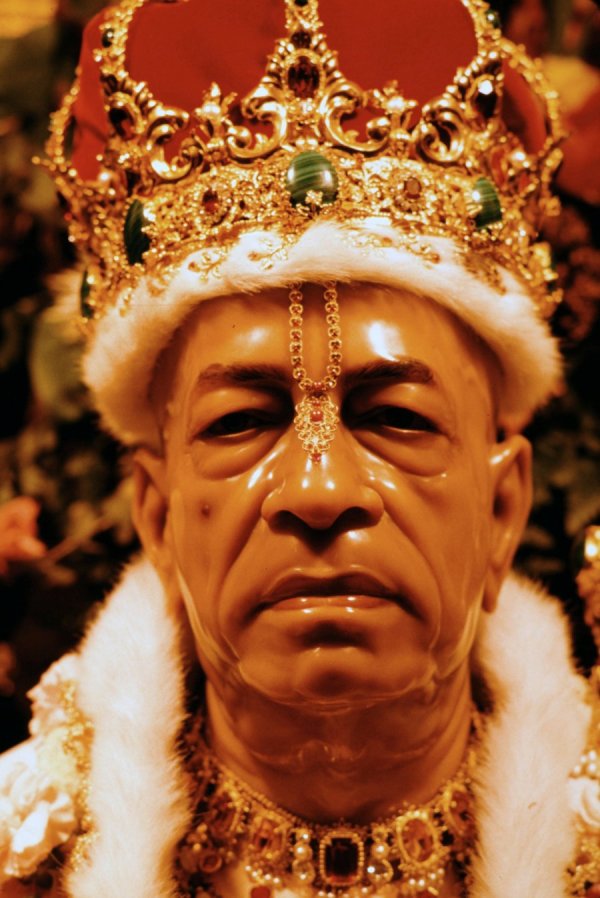
One of Bhaktipada’s first attempts to “Christianize” Krishna consciousness was giving the statue of Bhaktivedanta Swami Prabhupada at the Palace a crown and mace (December 1980). Crowns are sometimes placed on the heads of statues of Christian saints.
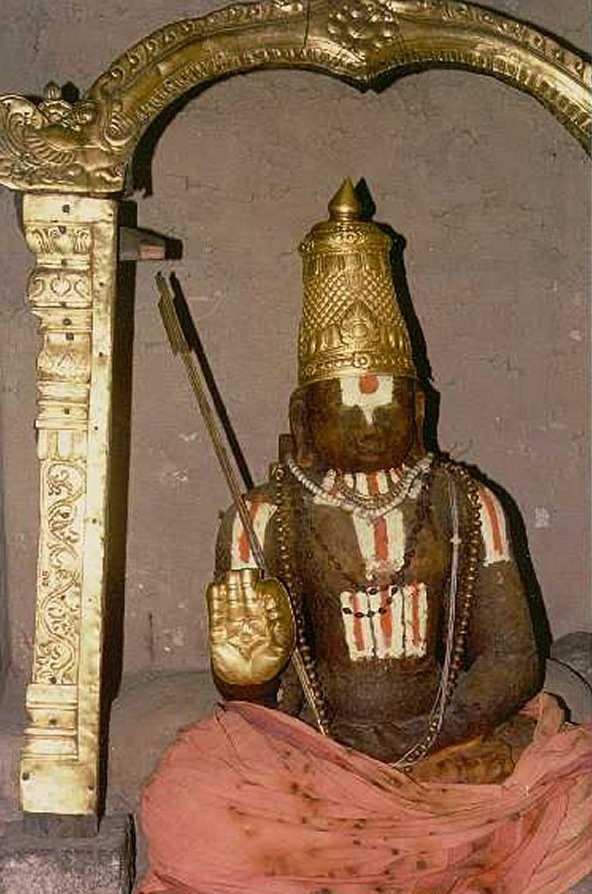
Offering a crown to a deceased spiritual master is not unheard of in the Vaishnava tradition. The deity of Ramanujacharya (1017-1137), a famous Hindu philosopher, guru, social reformer, and great pandit of the Sri Vaishnava Sampradaya, wears a crown. The deity is located in the temple of Sri Ranganathswamy, in Srirangam, Tiruchirappali, Tamil Nadu, India. Ramanujacharya’s actual mummified body is preserved in a sitting posture in the temple.
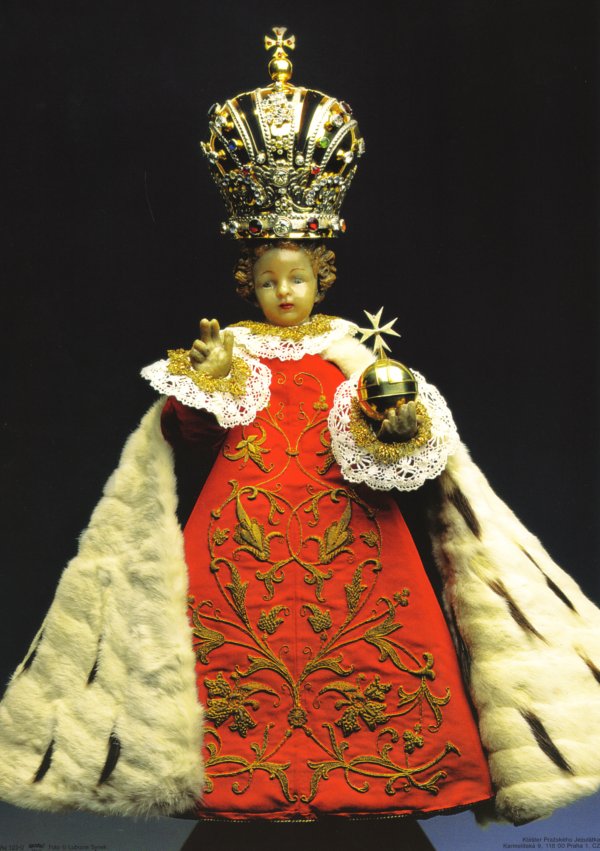
Offering a crown to a deity is common in the Roman Catholic tradition. This is the Infant of Prague.
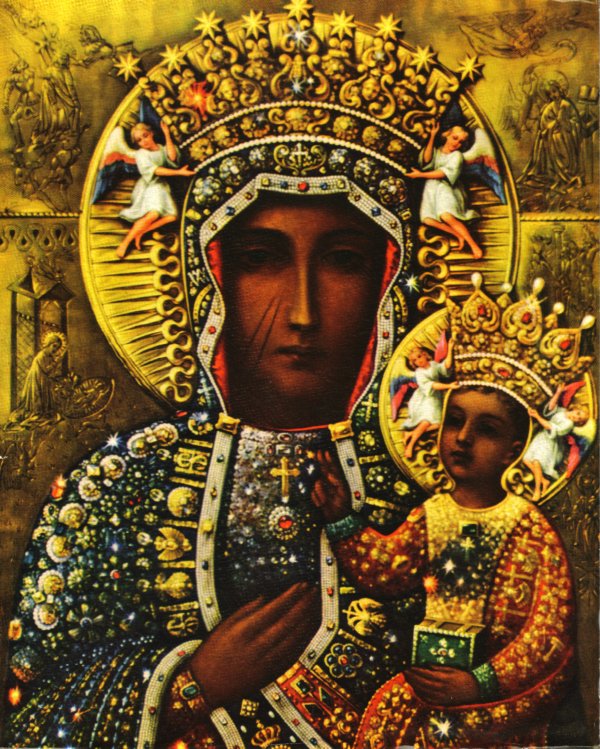
Crowns are also offered to paintings of saints, such as the Black Madonna of Czestochowa.

Cover of Bhaktipada’s first book, Song of God: A Summary Study of Bhagavad-gita As It Is (1984).
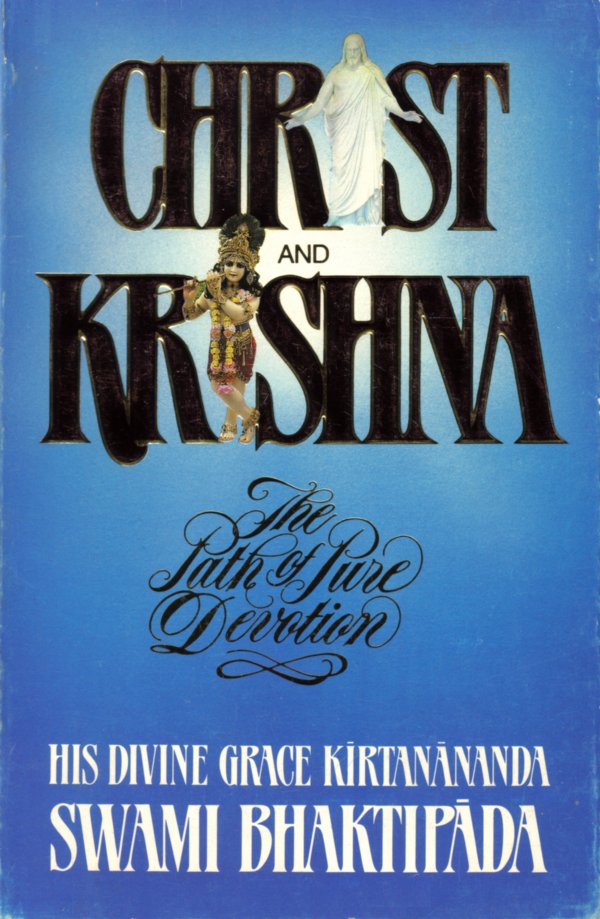
Cover of Bhaktipada’s book Christ and Krishna (1985), which helped reveal the similarities between Gaudiya Vaishnavism and Christianity.
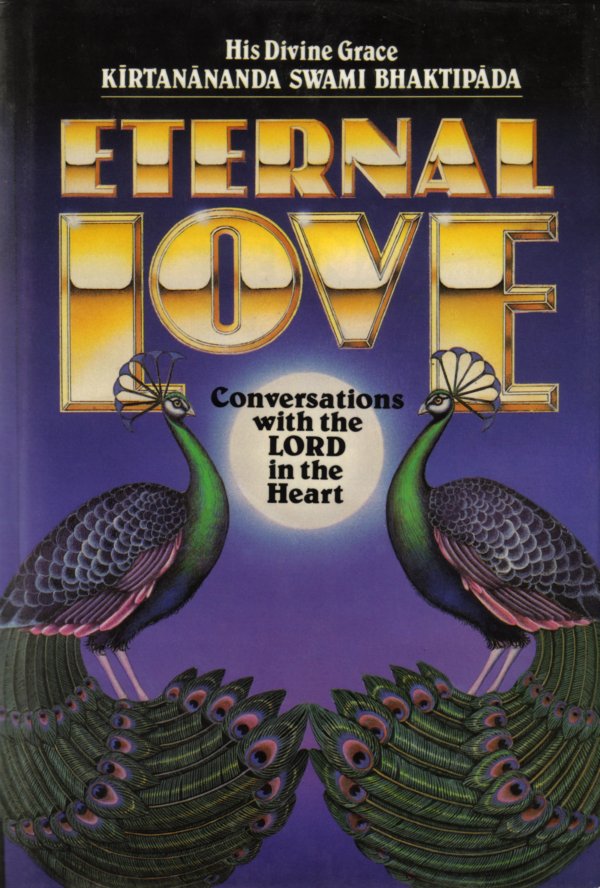
Cover of Bhaktipada’s book, Eternal Love (1986), a Krishna-ization of Imitation of Christ by Thomas à Kempis (1380-1471).
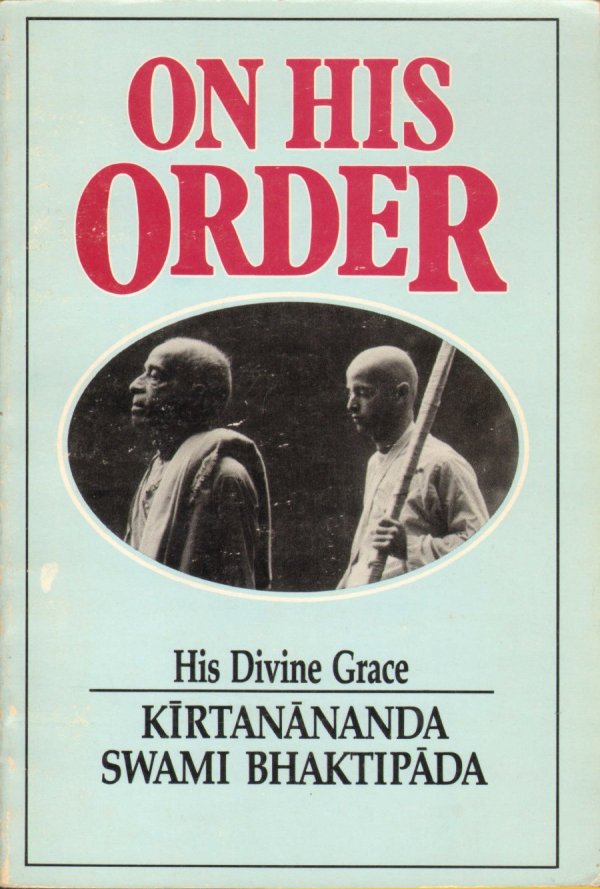
Cover of Bhaktipada’s book, On His Order: What Is A Bona Fide Guru? (1987)
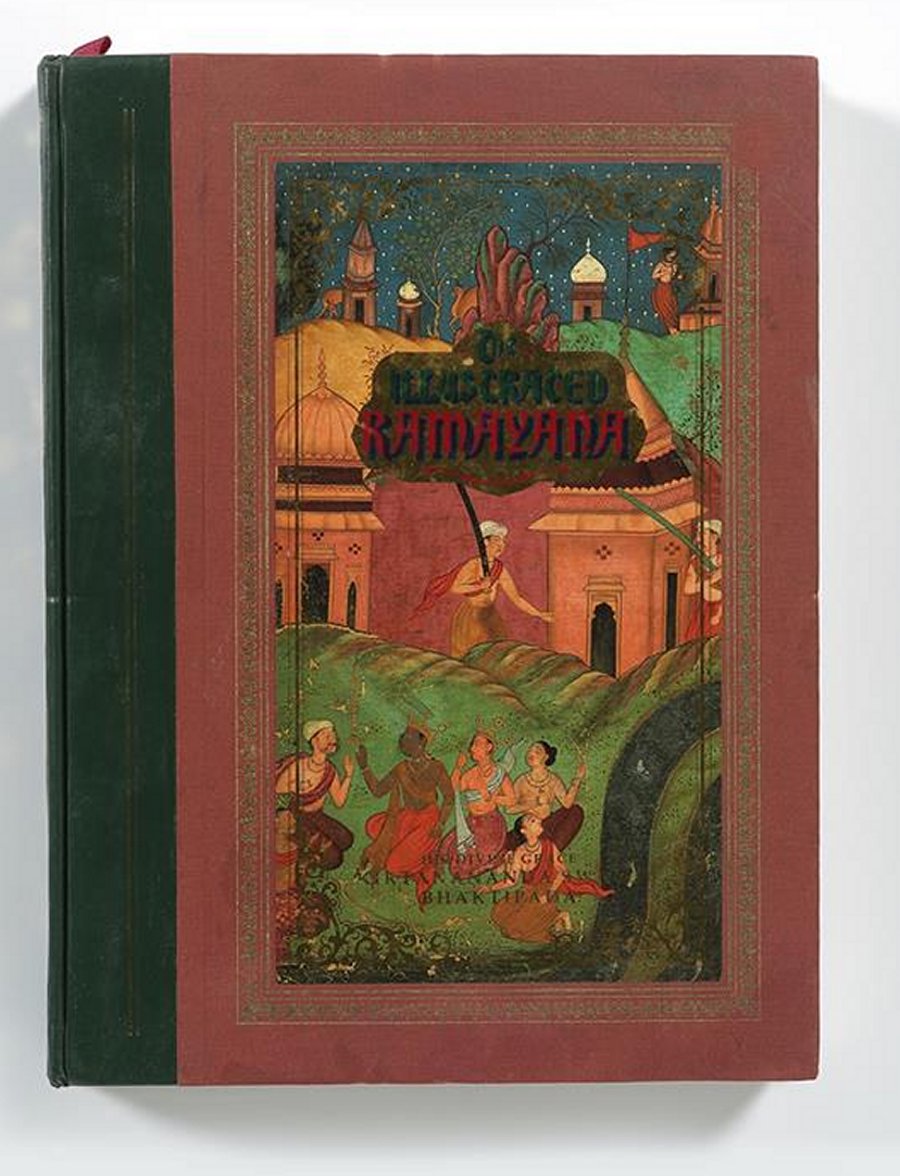
Cover of Bhaktipada’s book, The Illustrated Ramayana (1987).

Cover of Bhaktipada’s book, Lila in the Land of Illusion: A Retelling of Lewis Carroll’s Alice in Wonderland (1987)
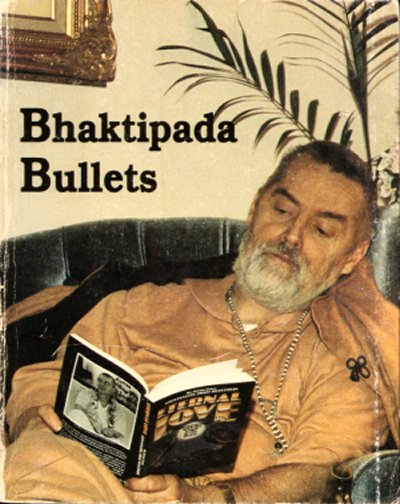
Cover of Bhaktipada’s book, Bhaktipada Bullets compiled by Devamrita Swami (1988).
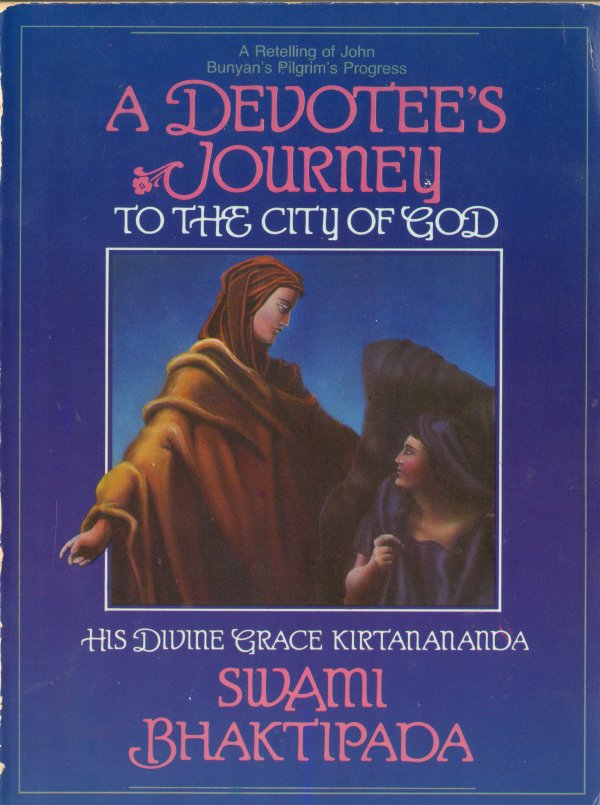
Cover of Bhaktipada’s book, Devotee’s Journey to the City of God: A Retelling of John Bunyan’s Pilgrim’s Progress (1988).
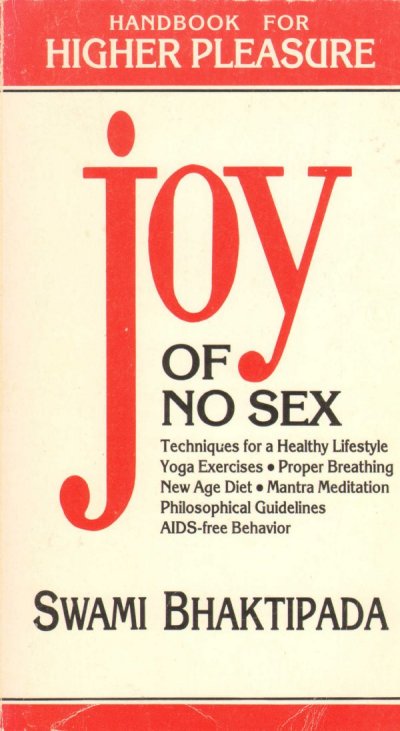
Cover of Bhaktipada’s book, Joy of No Sex: Handbook For Higher Pleasure (1988).
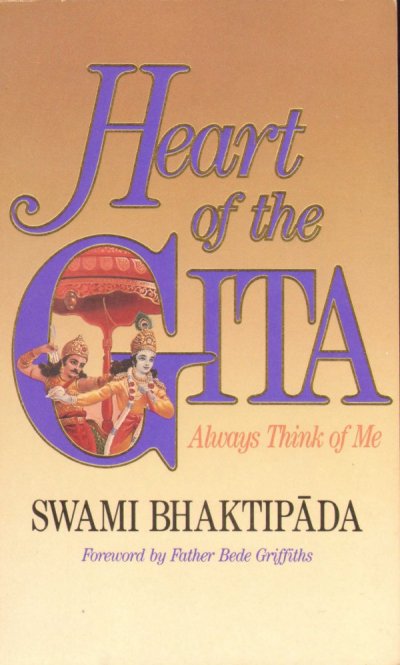
Cover of Bhaktipada’s book, Heart of the Gita: Always Think of Me (1990).
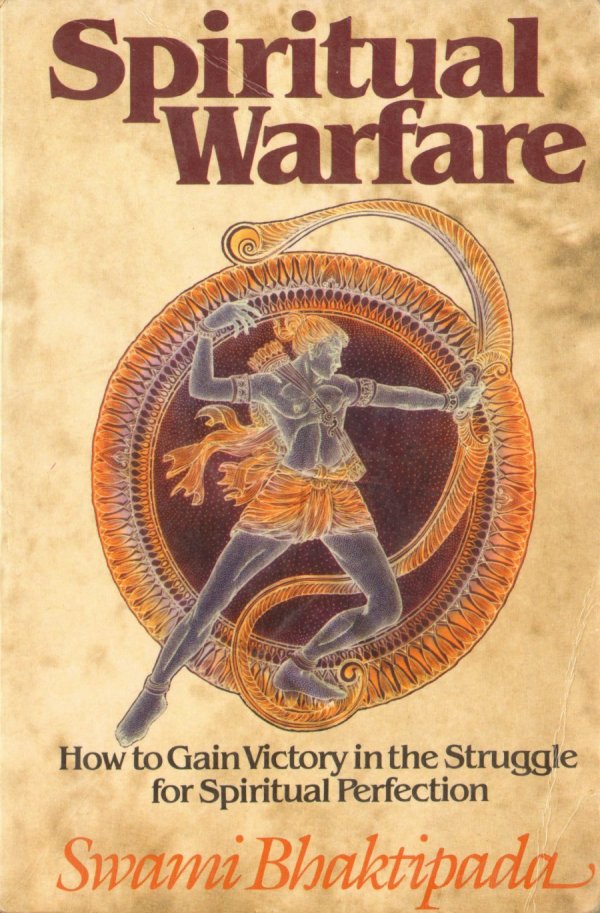
Cover of Bhaktipada’s book, Spiritual Warfare: How to Gain Victory in the Struggle for Spiritual Perfection (1990).
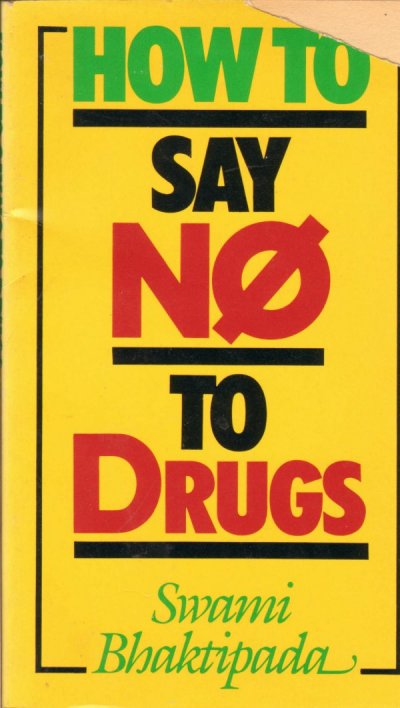
Cover of Bhaktipada’s book, How To Say No To Drugs (1990).
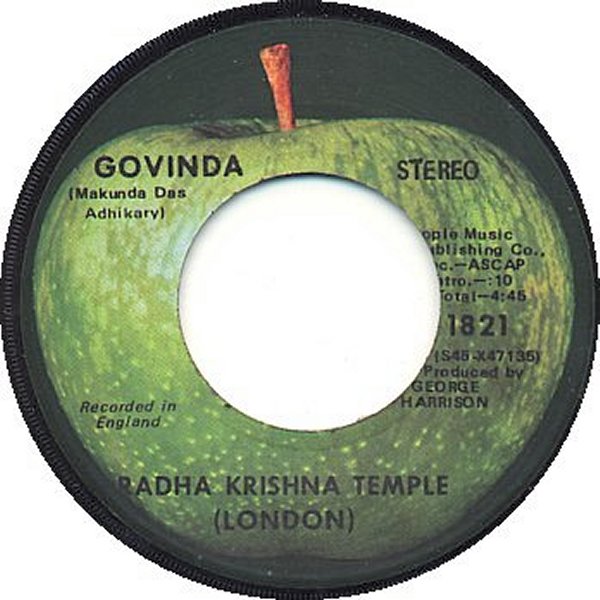
Bhaktivedanta Swami Prabhupada loved Apple Records’ 45-RPM record: “Govinda” from the Radha Krishna Temple album, although it was arranged in a western rock style, with only hints of traditional Indian instruments. The song is soft rock, not Indian by any means, yet it brought tears to Prabhupada’s eyes. Prabhupada ordered that this record be played in ISKCON temples during Greeting of the Deities. This suggests that Prabhupada did not mind if Western music was played during temple services.
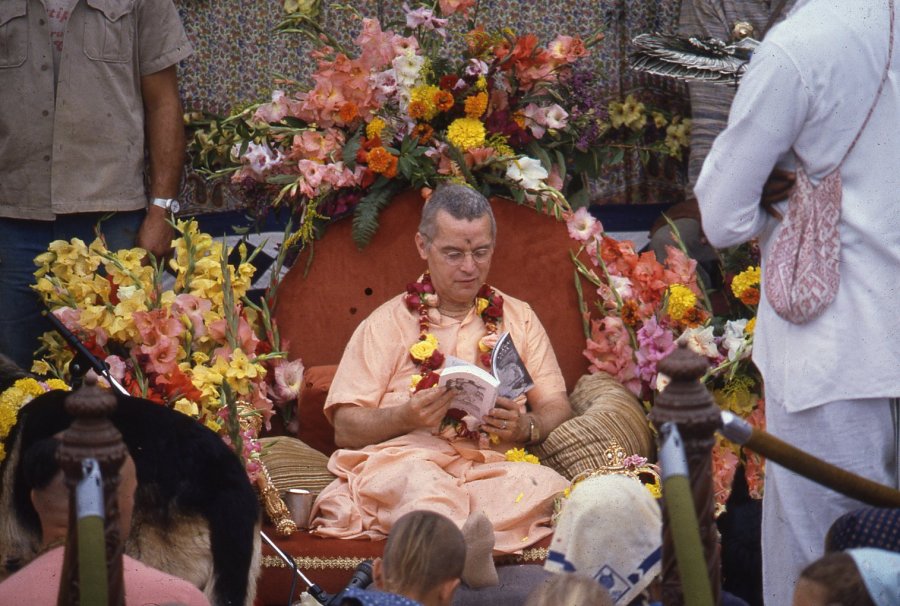
Bhaktipada reads from his Vyasa-Puja book at his 49th birthday celebration held behind his new house on the hill between McCreary Ridge Road and the Old Vrindaban Farm (September 1, 1986).
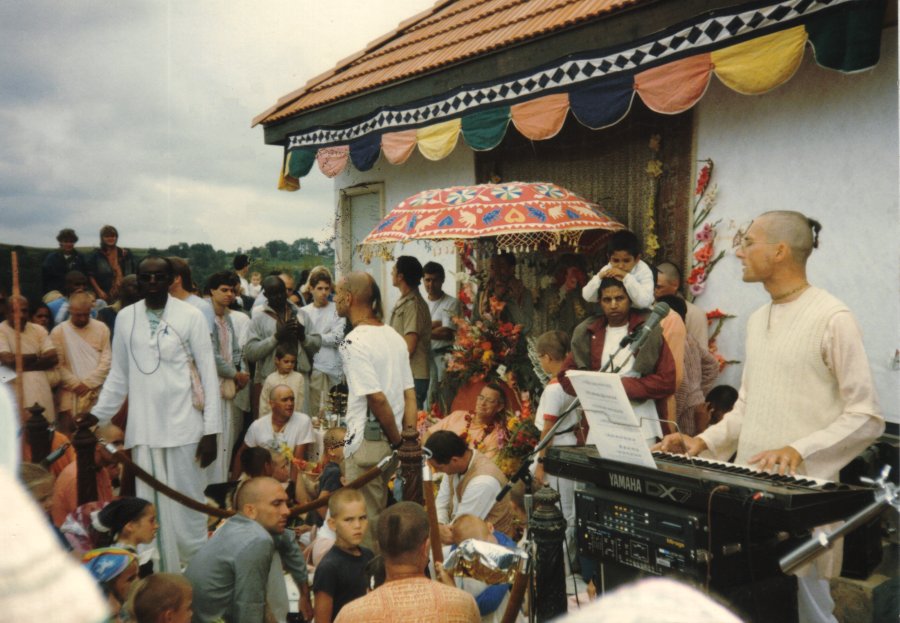
In 1986, western-style classical music began to become more prominent in the community. Here Hrishikesh leads, from the electronic keyboard, a handful of newly-recruited singers during Bhaktipada’s 49th birthday celebration (September 1, 1986).

Hrishikesh speaks through the microphone at Bhaktipada’s 49th birthday celebration (September 1, 1986).
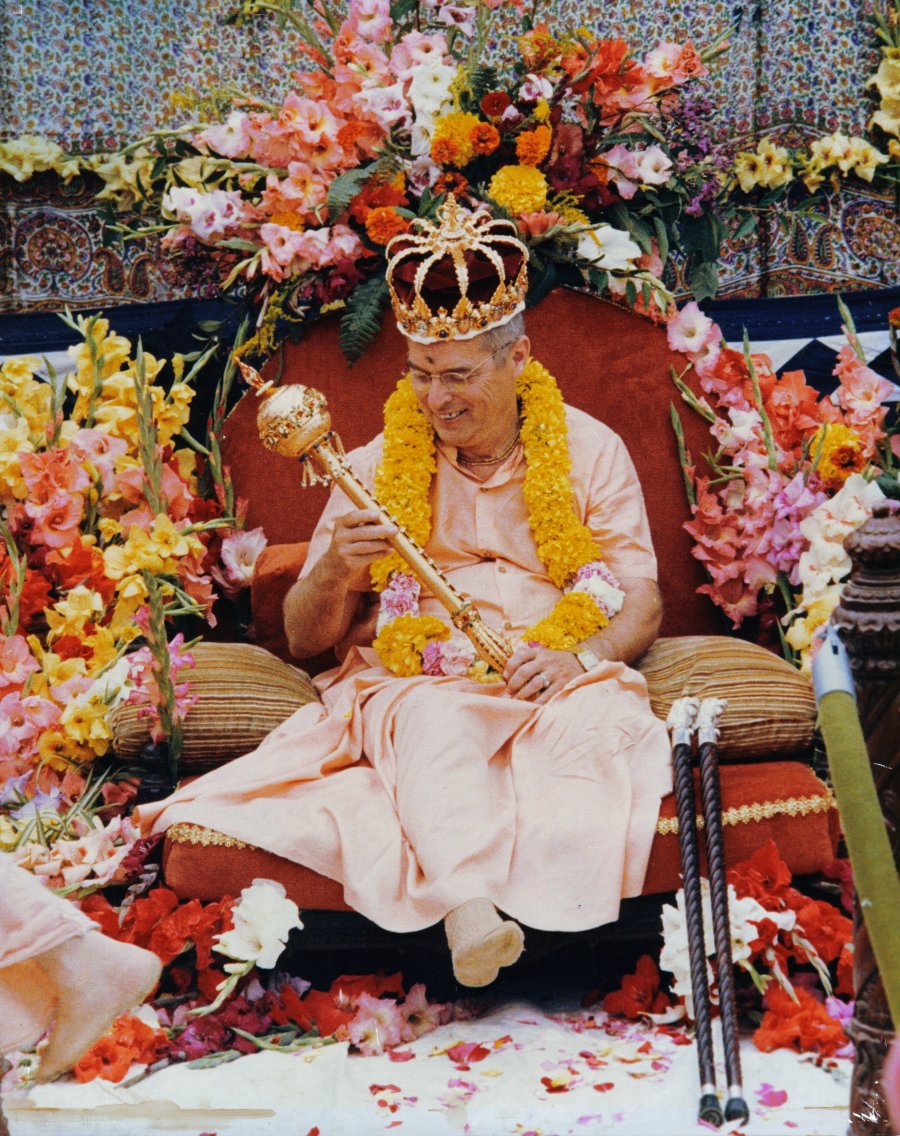
Bhaktipada received a beautiful crown and scepter crafted by Ishani devi dasi on his 49th birthday celebration (September 1, 1986).
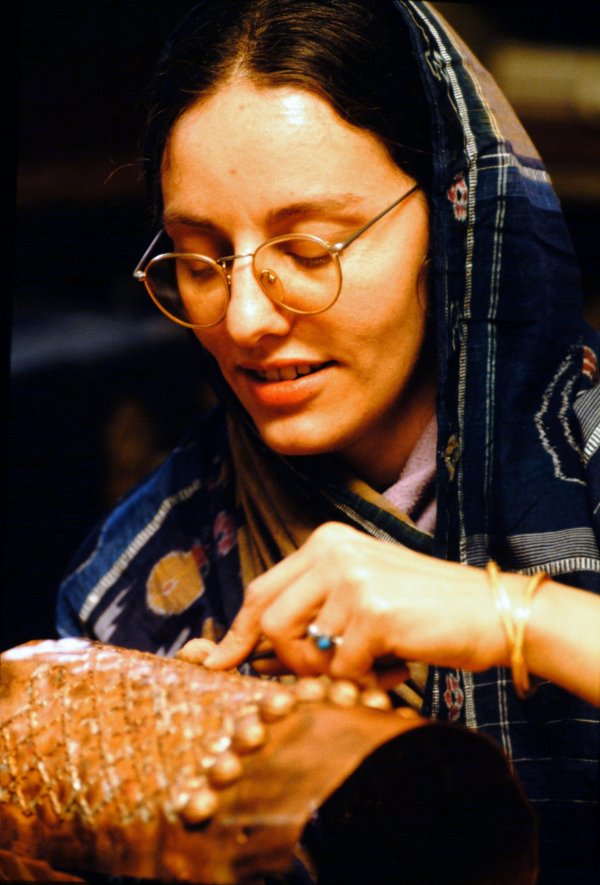
Mother Ishani (Ellen Schramm) working in the Jewelry Room (undated).
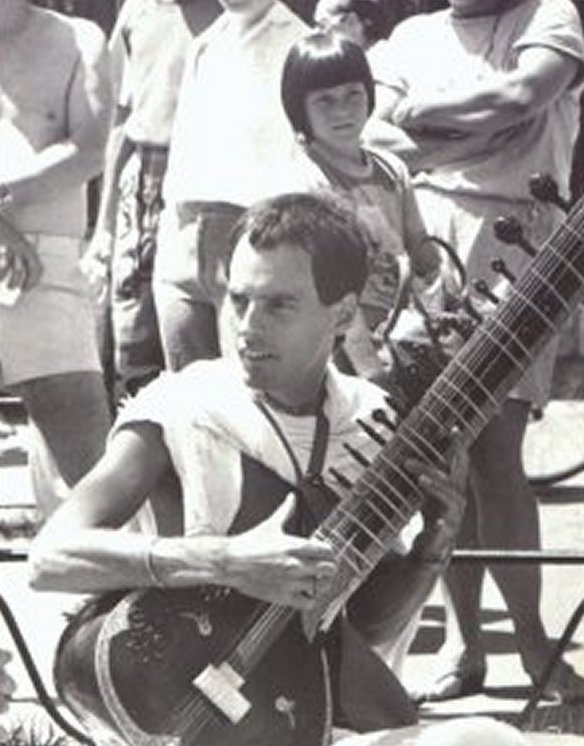
In the summer of 1986, Bhaktipada’s siksa musician disciple from Montreal, Mahavirya dasa (Robert Lafond), came with his family to live at New Vrindaban to start a gurukula choir and a western music program, although his endeavor was short lived.
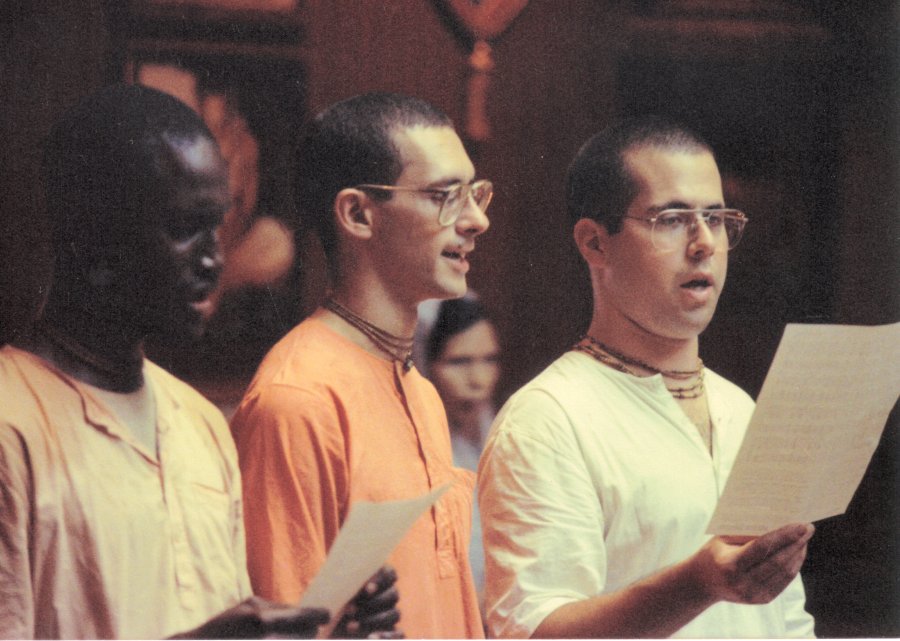
Members of the New Vrindaban choir: Dhananjaya, Japa Ananda, Dhruva.

The first full-length New Vrindaban choir concert. Front row: Ragamathani, Giri Suta, Madhurya Lila, Sumati. Back row: Dhananjay, Rukmini, Saraswati, Dhirodatta, Krishna Truthful. Choirmaster Hrishikesh directs from the electronic keyboard (January 5, 1987).
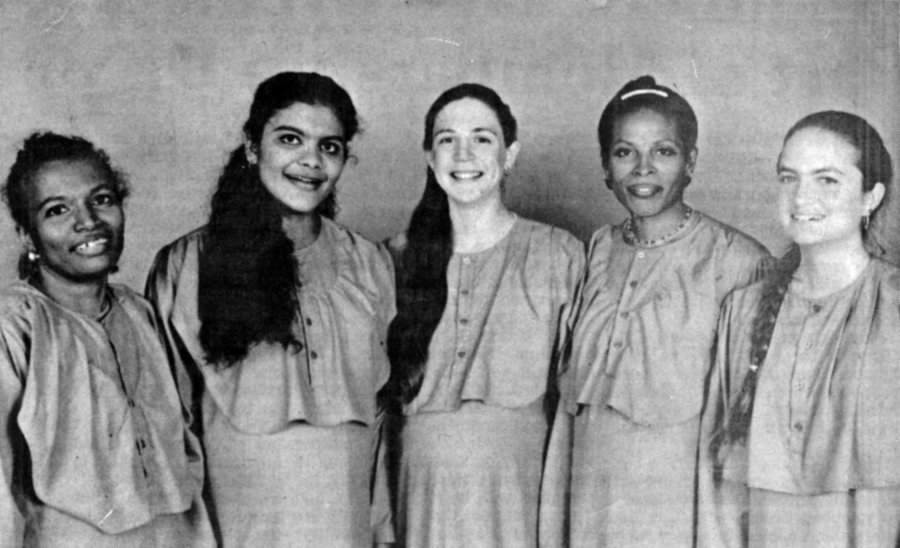
Principal altos and sopranos of the New Vrindaban choir: Janesvari, Shyama, Janaki, Bhavisya, Ragamathani.
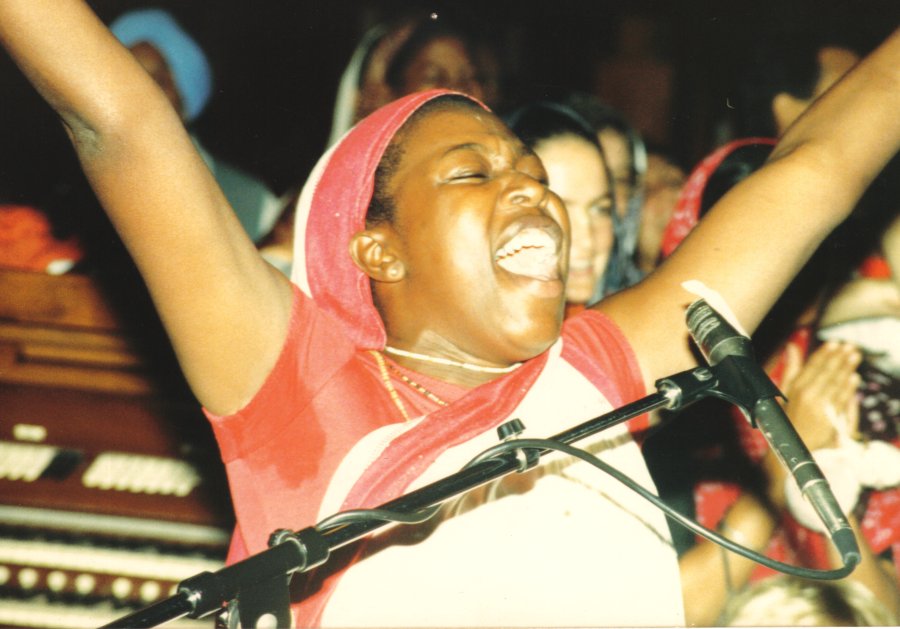
Brihat Mrdanga dasi enthusiastically sings He’s Got the Whole World in His Hands at Bhaktipada’s 50th birthday party (September 7, 1987).
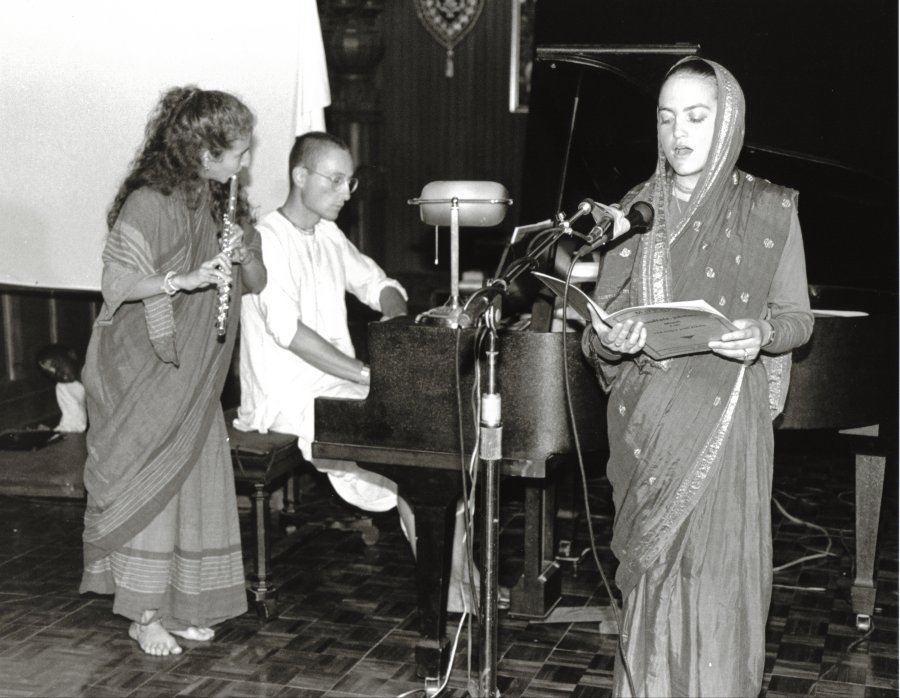
Visiting flutist Miranda Krenzer, Hrishikesh on piano, and soprano Ragamathani perform a Krishna-ized version of Mozart’s motet Exsultate, jubilate at Bhaktipada’s 50th birthday party (September 7, 1987).
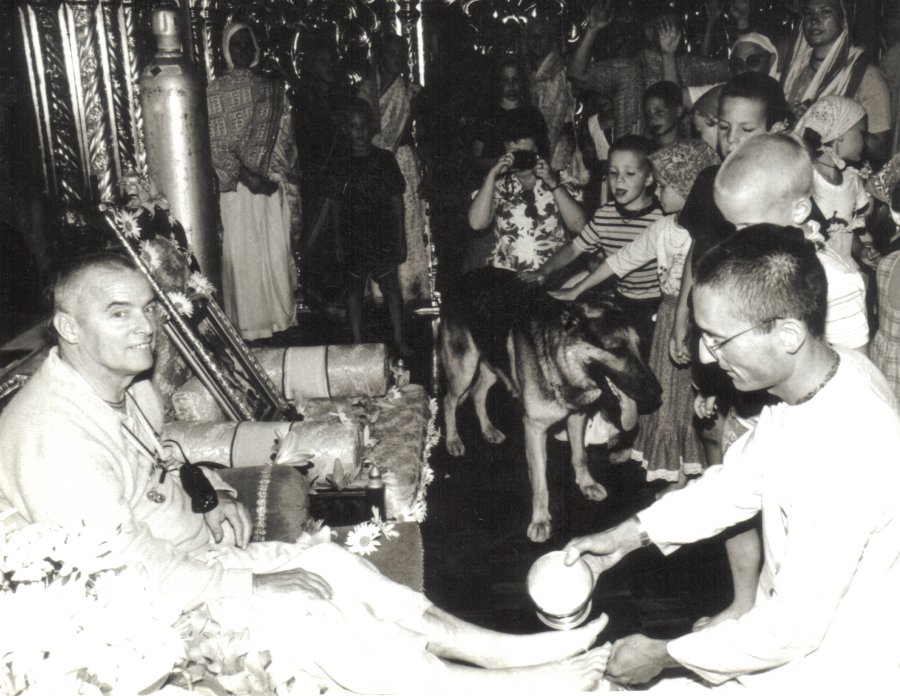
Hrishikesh performs pada-puja and bathes his spiritual master’s feet with yogurt, while Bhaktipada’s German shepherd guard dog Gudakesh enjoys affectionate petting from gurukula boys during Bhaktipada’s 50th birthday party (September 7, 1987).

Choir concert in the temple. Professor Alfred R. DeJagger directs; Hrishikesh accompanies on the piano (c. 1987).

The cover of the cassette tape Jagad Guru by the Krishna Chorale (1988). For more about, and to listen to Jagad Guru, go to Jagad Guru.
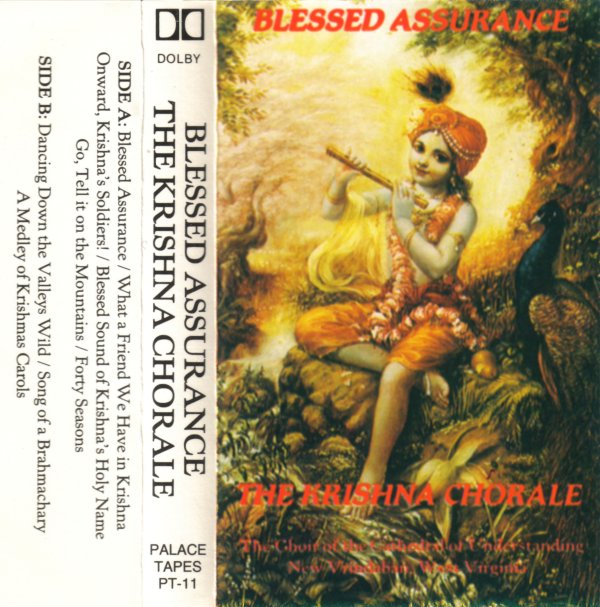
The cover of the cassette tape Blessed Assurance by the Krishna Chorale (1988). For more about, and to listen to Blessed Assurance, go to Blessed Assurance.
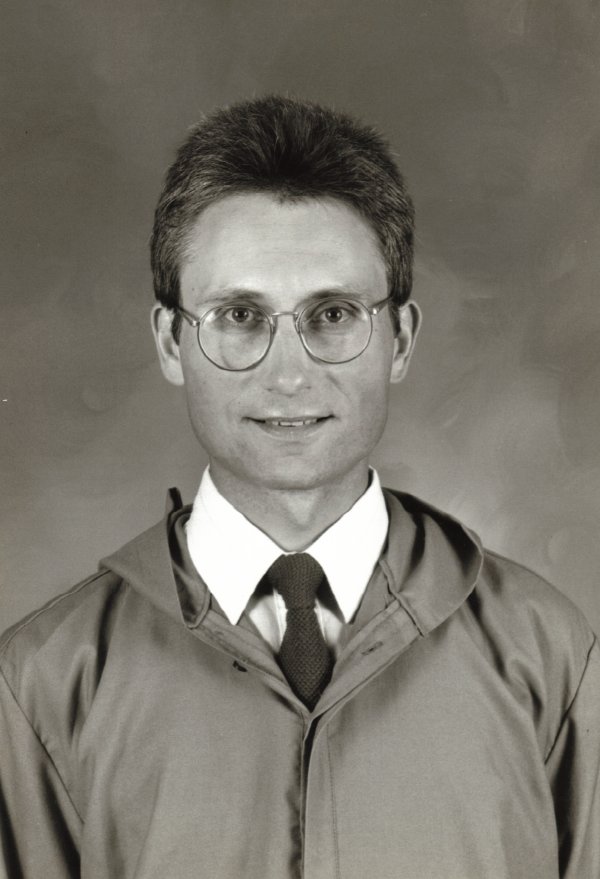
New Vrindaban’s Minister of Music from 1986 to 1993, Hrishikesh dasa (1988).

The City of God Children’s Choir—with director Hrishikesh—visits Washington D. C. and sings on the front steps of the Capitol (1988).
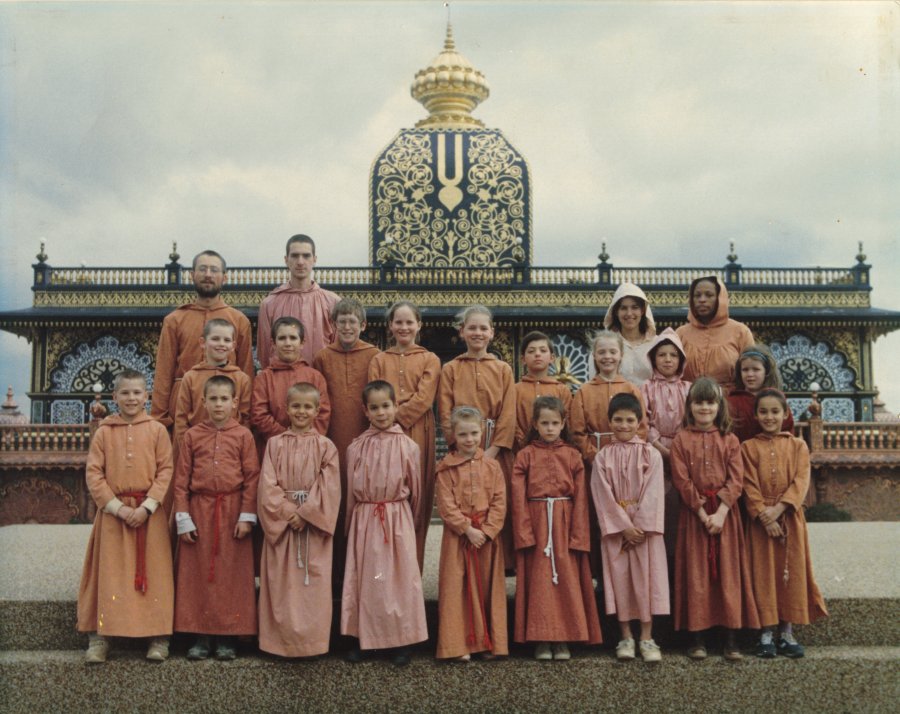
The City of God Children’s Choir, formal portrait behind Prabhupada’s Palace of Gold (1989). Adults include Hrishikesh (director) and assistants: Dhirodatta, unknown Bhaktin, and Bhavisya.
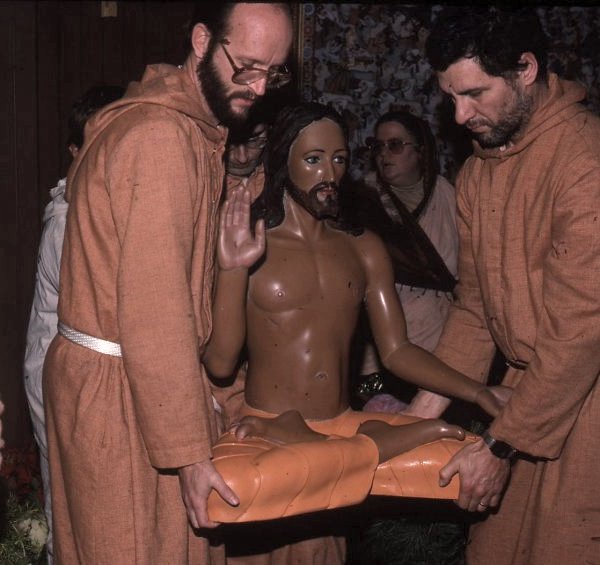
Gaura Shakti and Mahaprasad carry the murti of Jesus Christ to his vyasasana in the New Vrindaban temple (Christmas Day, 1988).
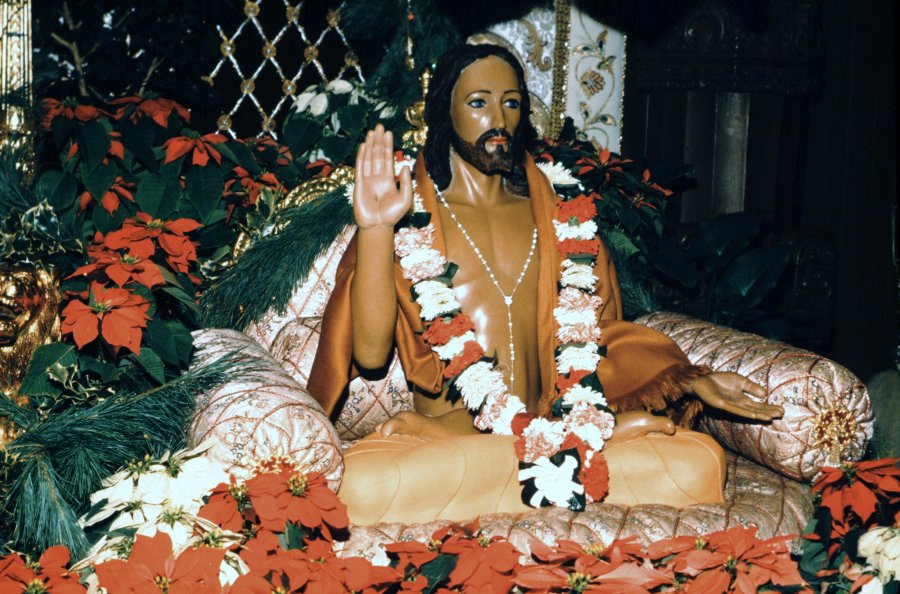
The advent of the murti of Jesus Christ in the New Vrindaban temple (Christmas Day, 1988).
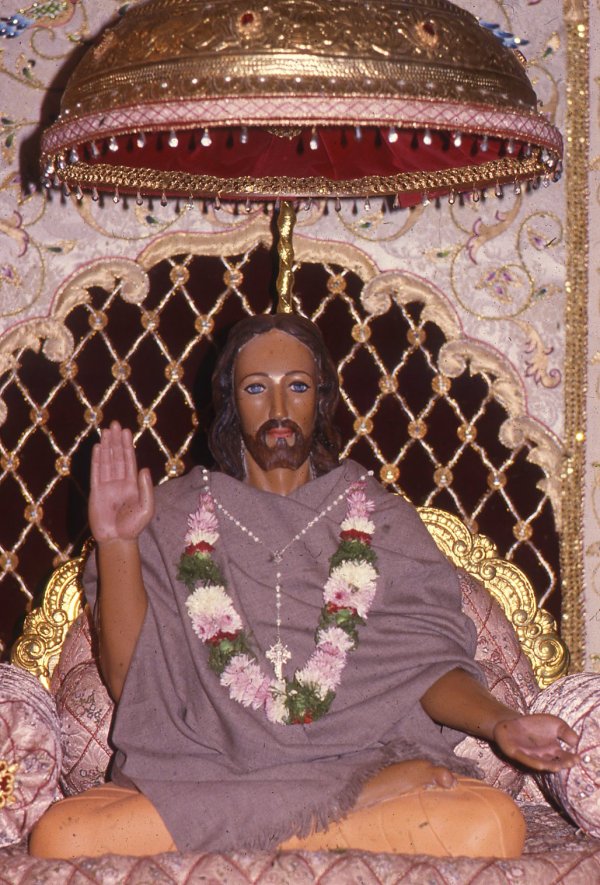
Jesus Christ in the New Vrindaban temple (undated).
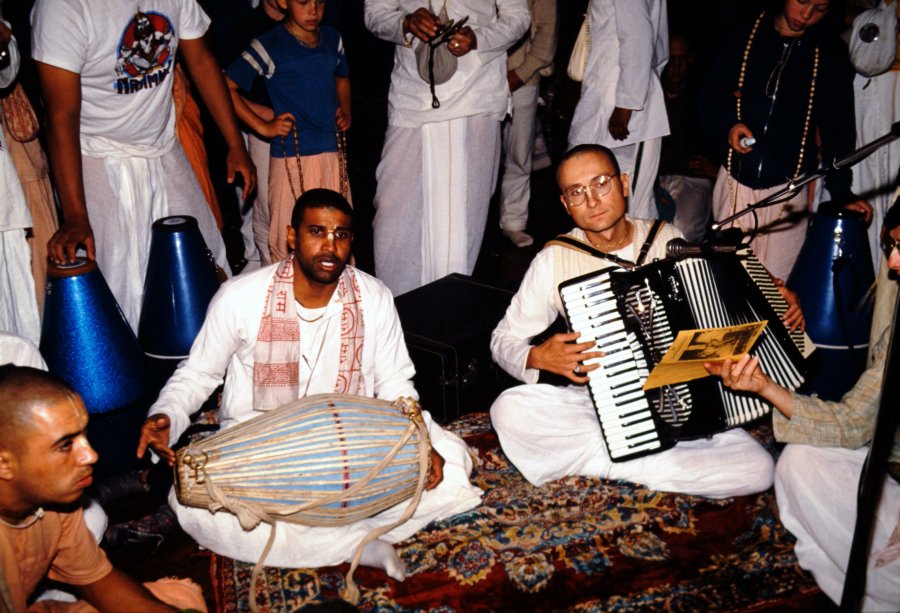
For New Vrindaban’s first twenty years, traditional Bengali-style music was the norm. Here Hrishikesh sings the Damodarastakam prayers and plays accordion while a visiting Indian devotee plays a clay mrdanga at New Vrindaban (c. Kartik 1986).
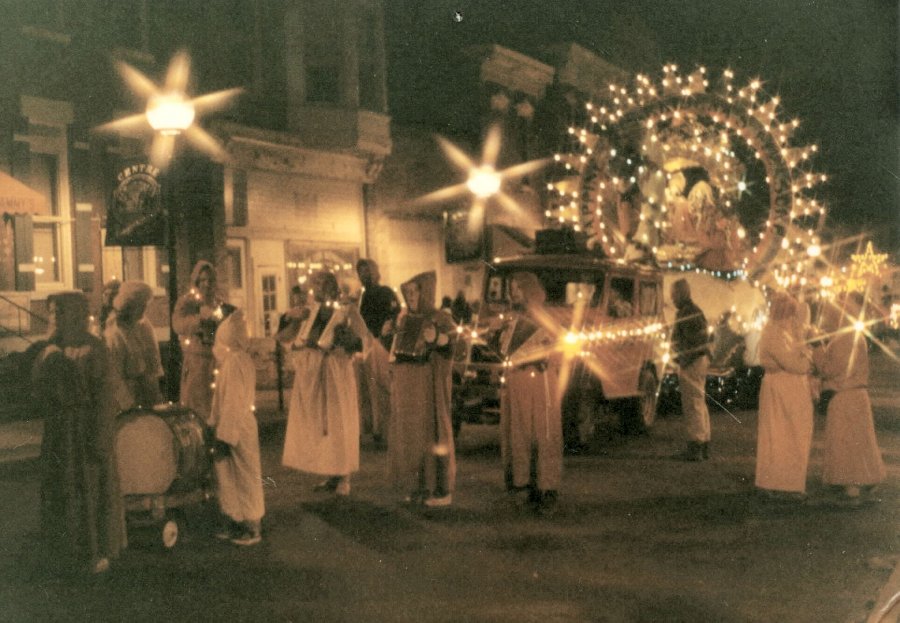
The first performance of the City of God Accordion Ensemble, at the Wheeling City of Lights Parade (November 17, 1989). The accordionists and bass drum player led, followed by a Jeep pulling a float with the Swan Boat. The temperature was cold and it began drizzling. Our fingers grew cold and stiff and we could barely move our fingers on the keys, but we plodded on to the end of the parade route.
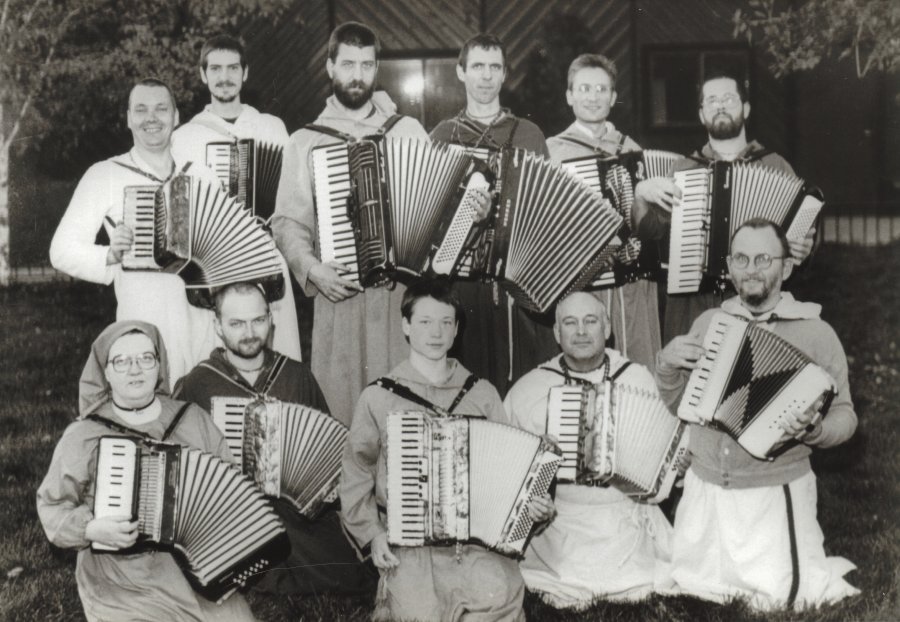
The City of God Accordion Ensemble—back row: Purity Swami, Dhirodatta, Thakur, Kripamaya, Hrishikesh, Dhruva; first row: Jamini, Dutiful Rama, Sanat Kumar, Vishvareta, True Peace (c. 1989).
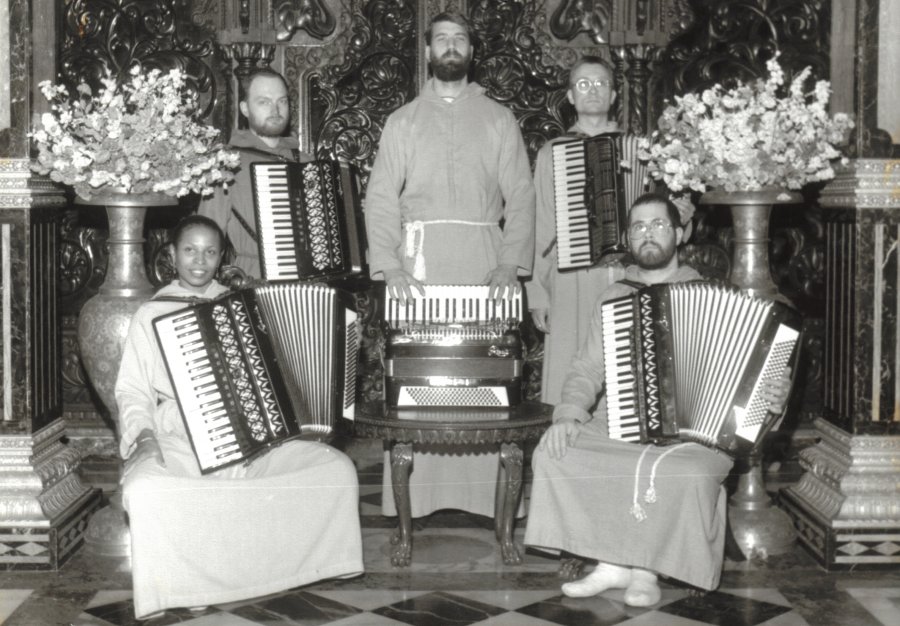
The City of God Accordion Quintet in Prabhupada’s Palace: Bhavisya, Dutiful Rama, Thakur, Hrishikesh and Dhruva (c. 1990).
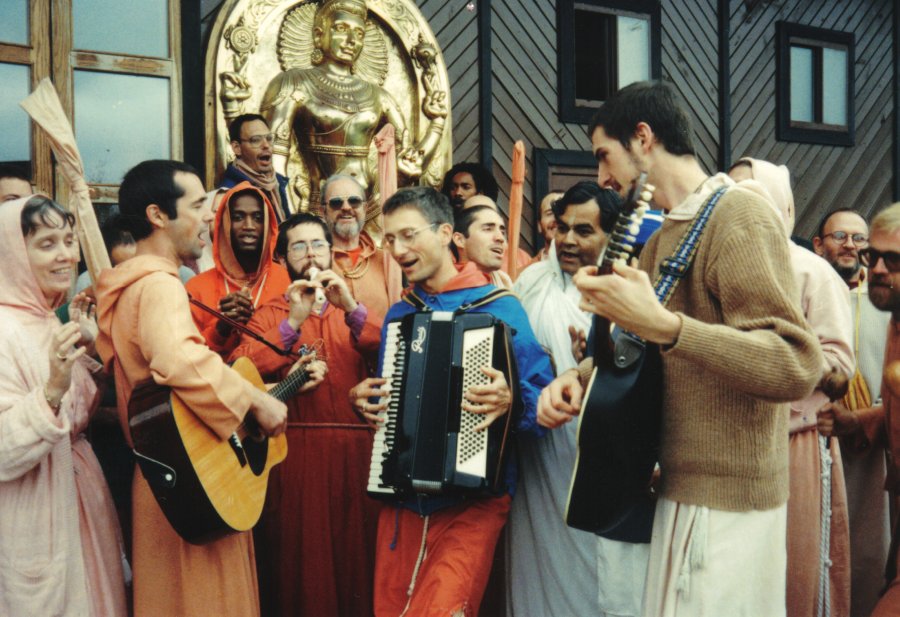
Spontaneous kirtan in front of the RVC temple (c. late 1980s). From left to right: Krishna Truthful, Mahati dasi, Adi Purusha Swami (with danda), Devananda Pandit (playing guitar), Dhananjaya, Vishnumurti, Dhruva (playing recorder), Murti Swami (with danda), Hrishikesh (playing accordion), Steve (black caretaker for Hayagriva), probably Chandramauli Swami (with danda), Buddhi Yoga, Bhaktisiddanta, unknown Indian householder man, Dhirodatta (playing guitar), unknown devotee, True Peace, Madhava Ghosh.

Hrishikesh, Krishna Katha (Carl Carlson) and Bhaktipada observe Bhaktipada’s college organ professor, Dr. James A. Bloy demonstrate the Walter Holtkemp organ at Maryville College, Maryville, Tennessee (May 27, 1987).
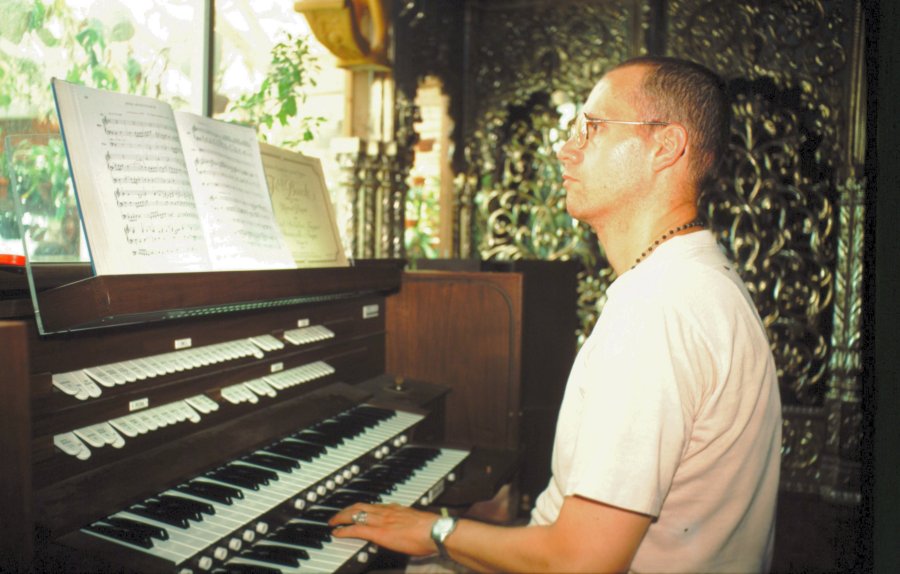
Radha Vrindaban Chandra Swami practices on the Allen electronic organ, Bhaktipada’s house (Spring 1988).
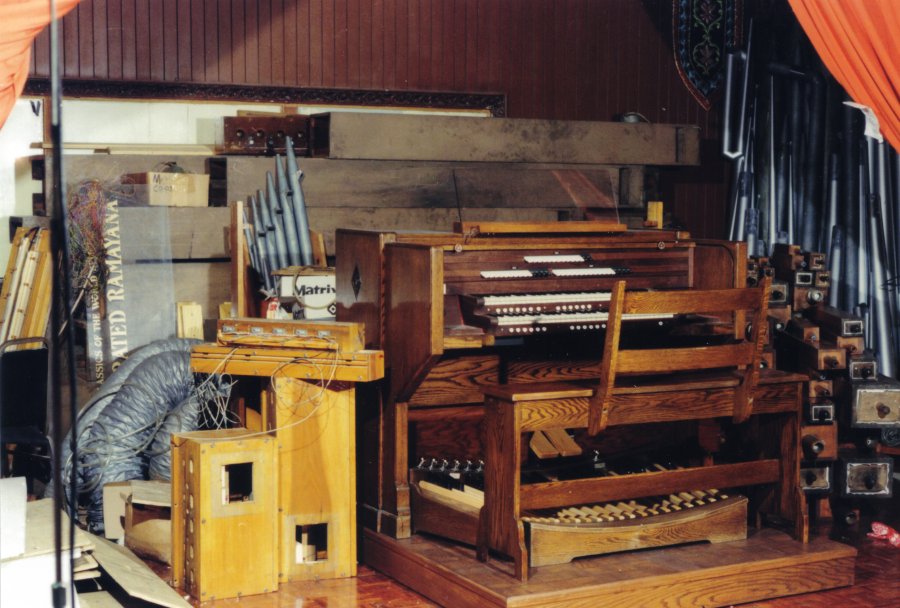
The Möller organ console, various pipes, windchests and blowers lie helter-skelter in the RVC temple room (c. November 1990).
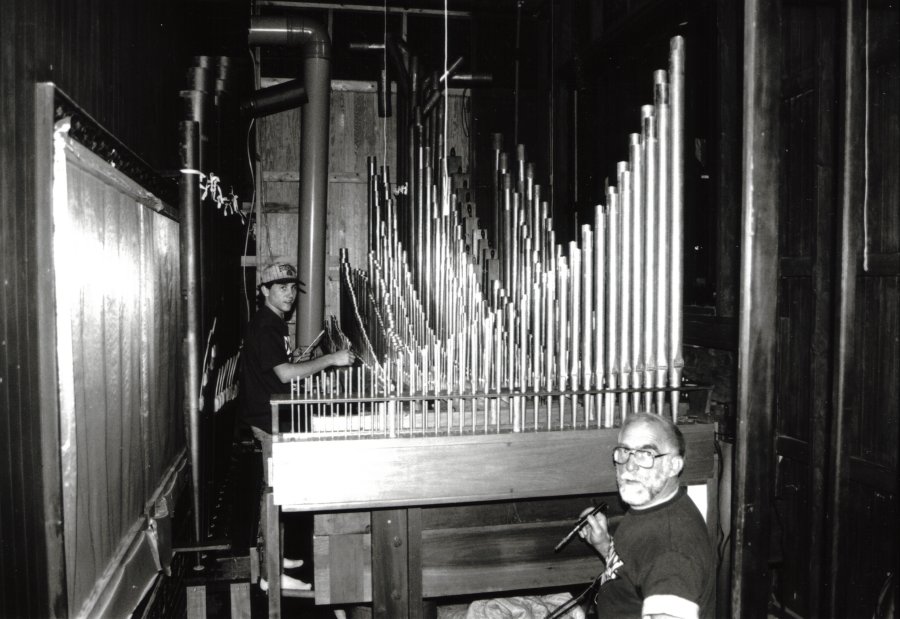
Organ builder Joseph Humpe and his assistant assemble the Möller organ in the RVC temple room (c. November 1990).
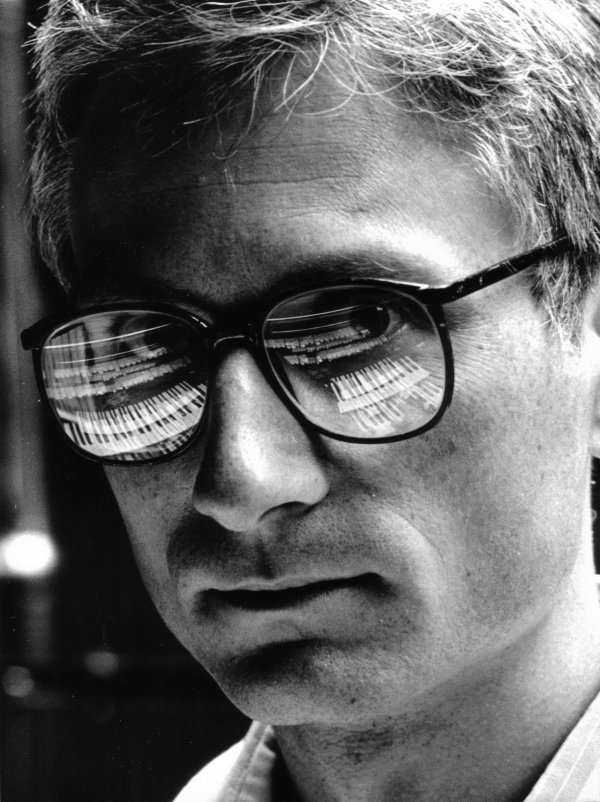
Hrishikesh at the Allen organ console with reflection of the two keyboard manuals in his eyeglasses (1990). Photo by Kumar (Craig Thompson).
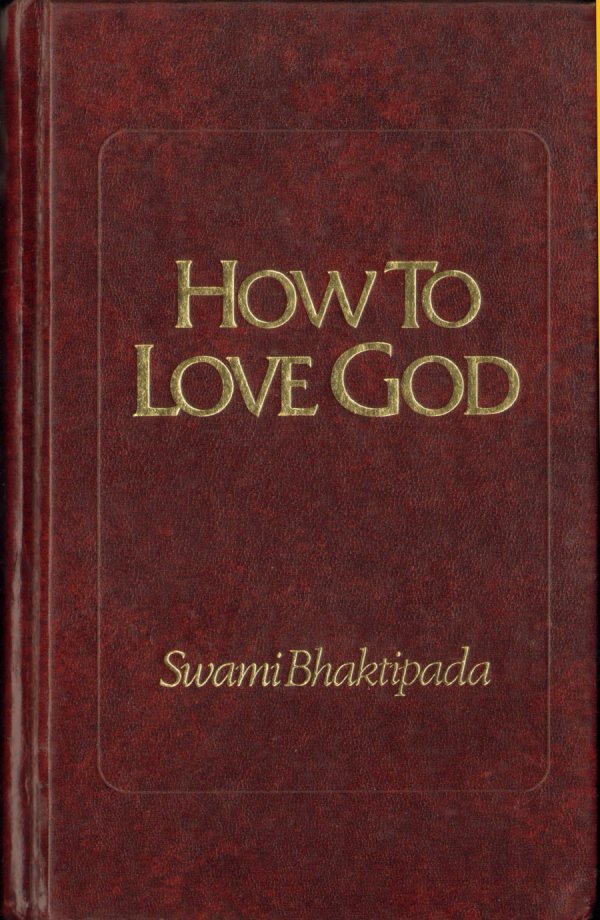
Music was a very important part of Bhaktipada’s vision for preaching Krishna consciousness and Hrishikesh became an important part of his mission. On page 115 of How To Love God, Bhaktipada writes, “Krishna clearly says in the Gita that one with a vision for preaching is most dear to him, and I think that the vision he has given me in regard to preaching with music is best understood by Hrishikesh. So please, just follow his direction and be united in love for one another, because that is what pleases Krishna and Guru.” Image: cover of Bhaktipada’s book: How To Love God, hardcover (1992).

Hrishikesh with cantor and harpist Bhavisya, and accordionist and timpanist Dutiful Rama at the console of the Allen electronic organ. Photo from New Vrindaban World, Vol. 1, No. 1 (February 1990).
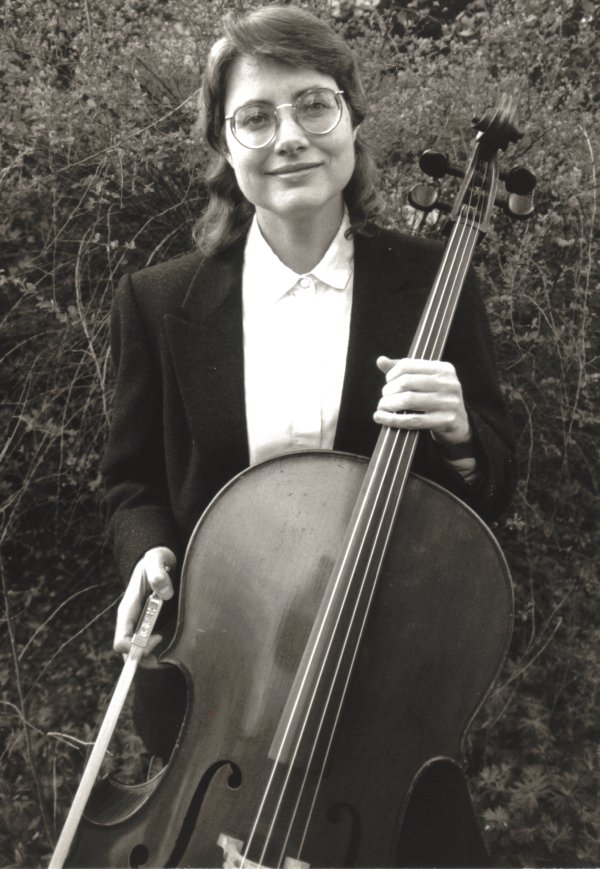
Cellist Susan Kemper performed several times for Music at the Palace.
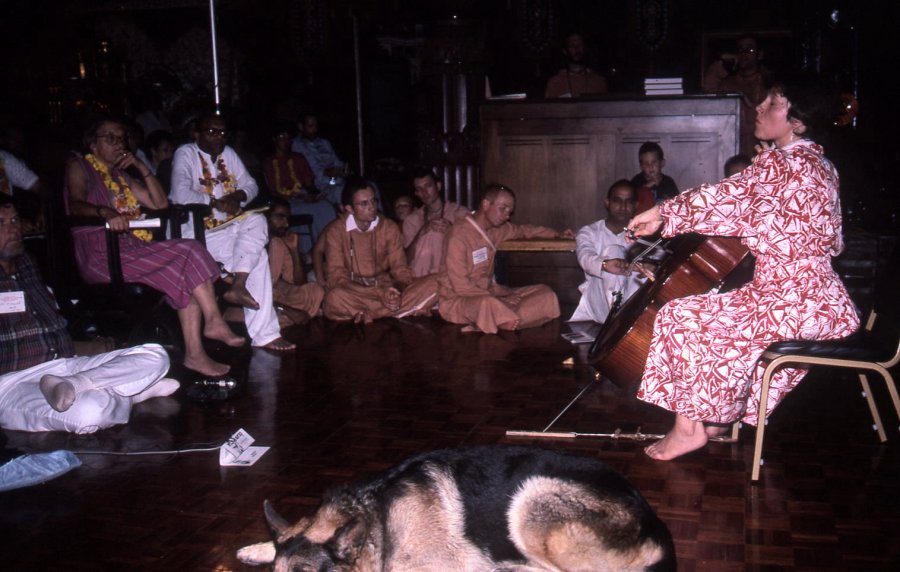
World-famous cellist Cecylia Barczyk performs at New Vrindaban (June 9, 1991).
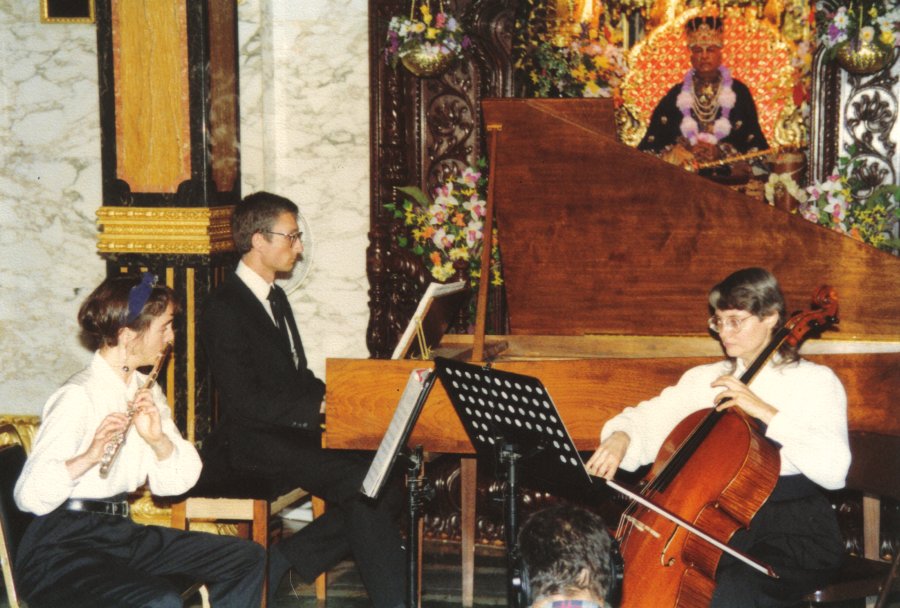
Flutist Tessa Brinckman, harpsichordist Henry Doktorski, and cellist Susan Kemper perform at Music at the Palace (October 13, 1991).
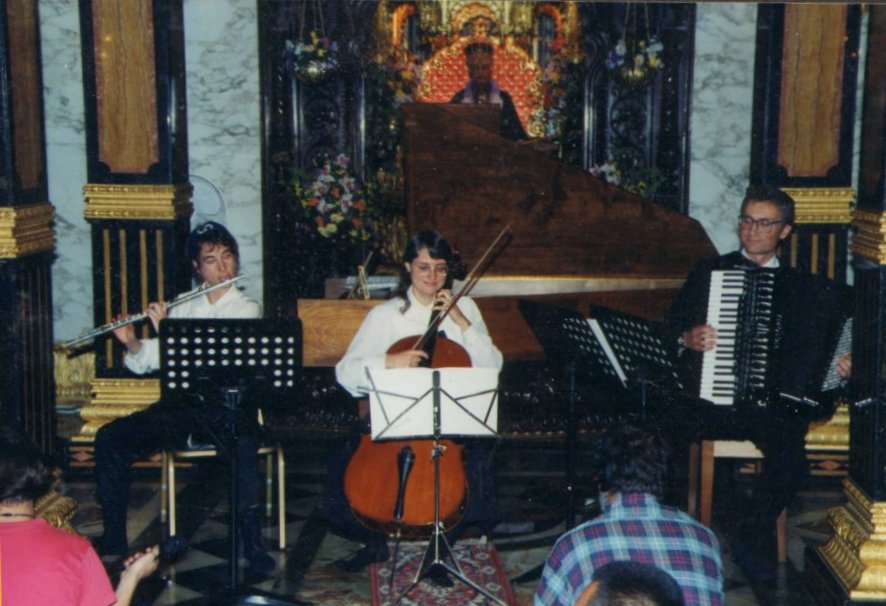
Flutist Tessa Brinckman, cellist Susan Kemper, and accordionist Henry Doktorski perform at Music at the Palace (October 13, 1991).
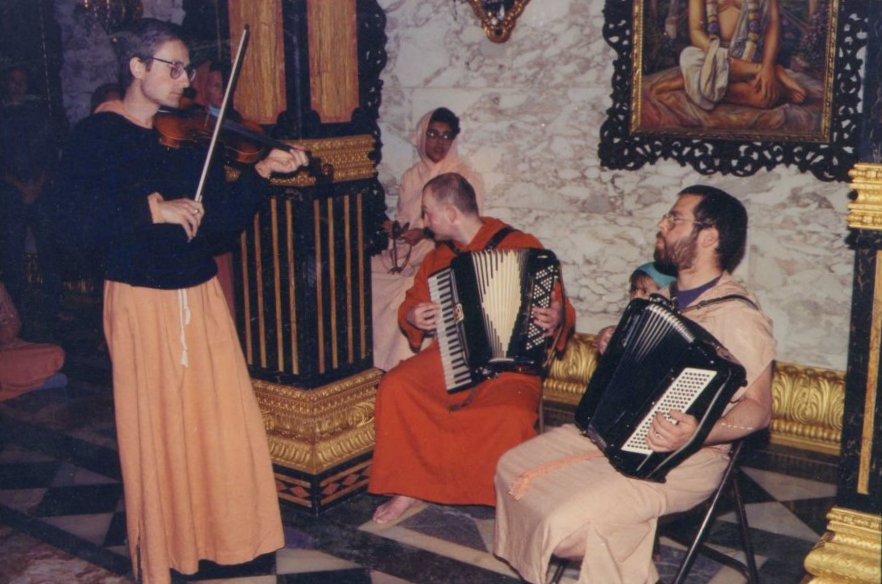
Hrishikesh, Dutiful Rama and Dhruva at the Palace (April 16, 1991).
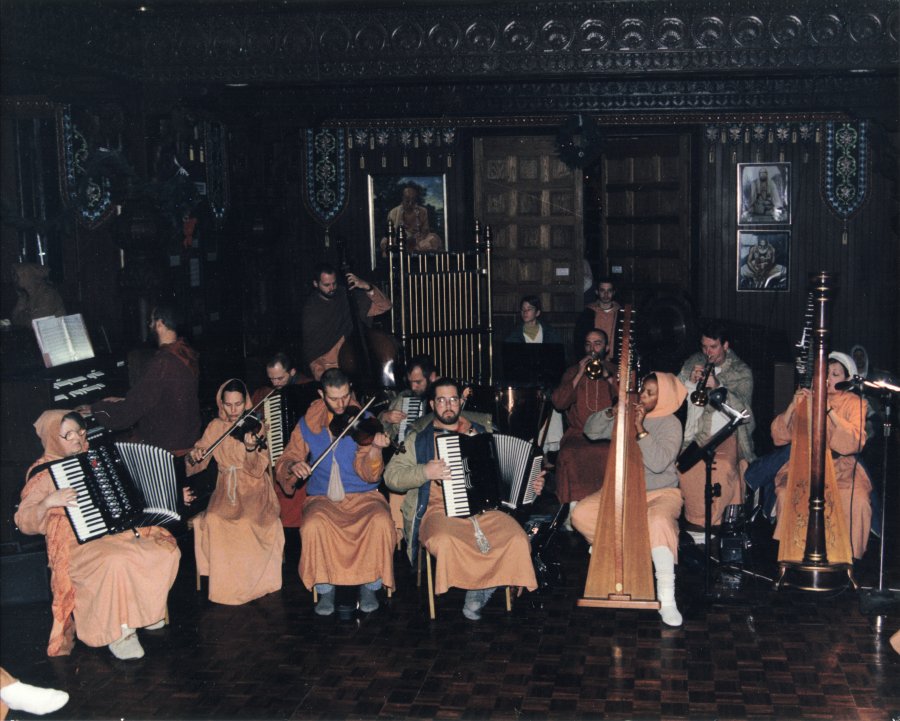
The City of God Temple Orchestra (c. 1990).
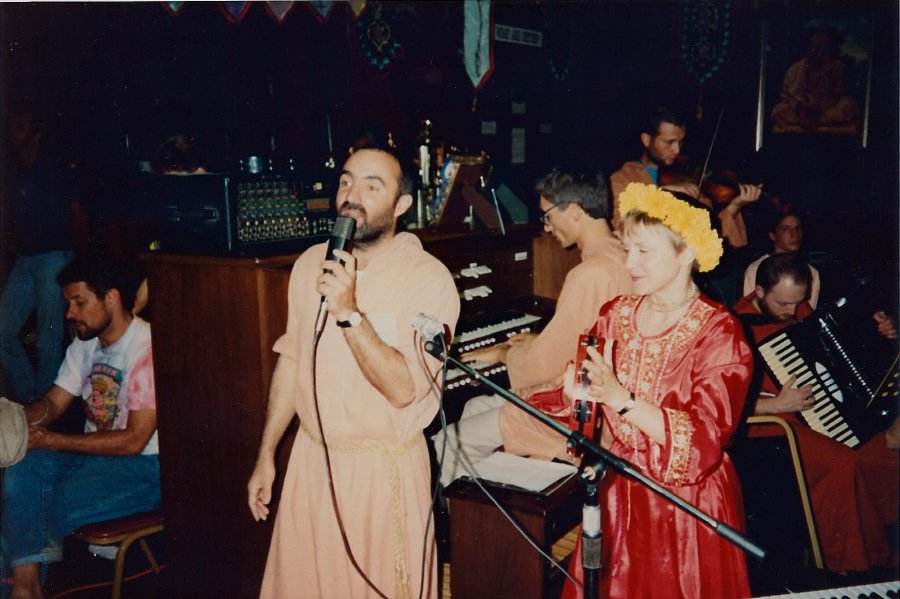
Cantors Adi Purusha Swami and Chaitanya devi dasi lead the singing, accompanied by the City of God Temple Orchestra (c. 1990).
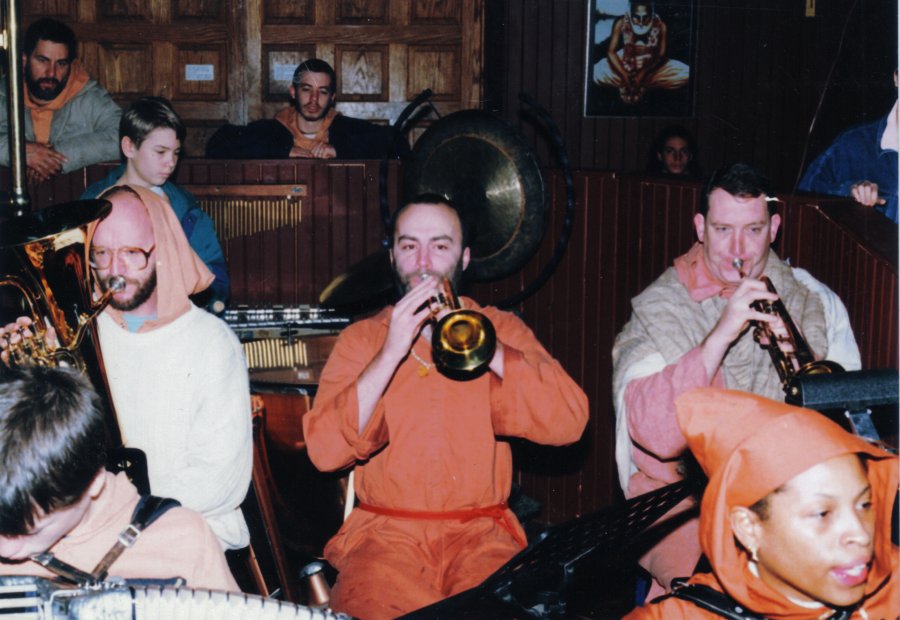
The brass section of the City of God Temple Orchestra: Gaura Shakti plays baritone horn, and Visvatomukha and Sudhana play trumpets. Also: Santa Kumar and Bhavisya play accordions, Hari Kirtan plays orchestra bells (c. 1990).
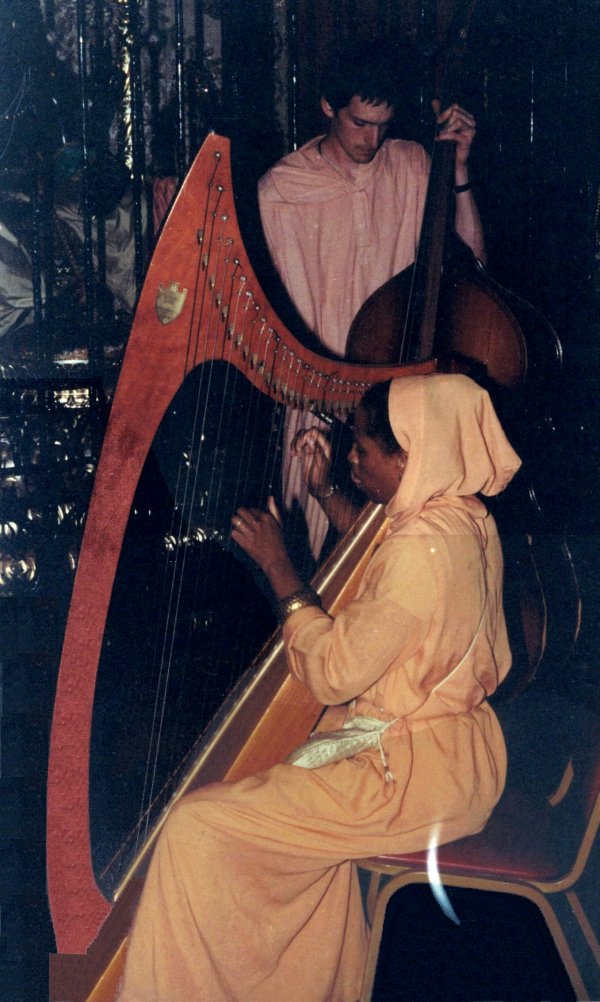
Bhavisya devi dasi plays harp and Dhirodatta plays double bass (c. 1990).
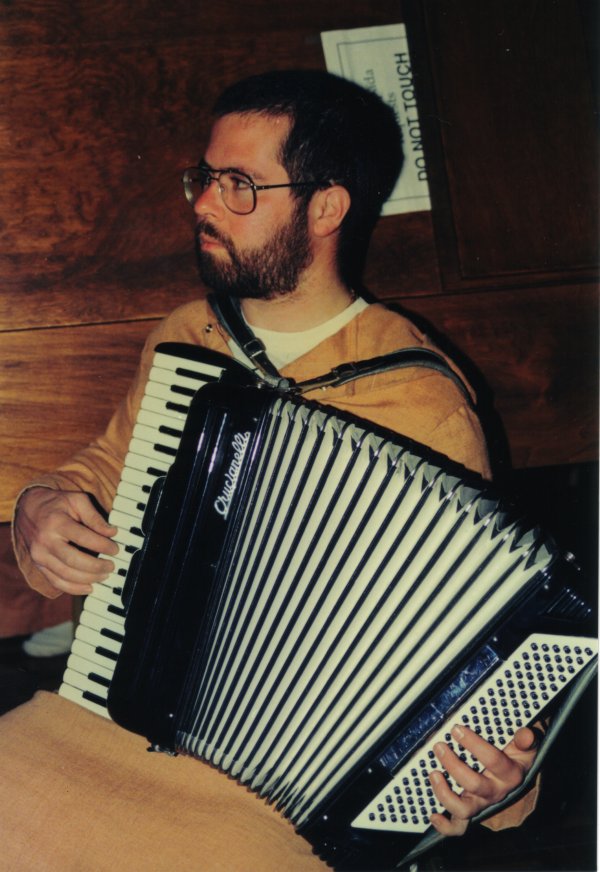
Dhruva plays accordion (c. 1990).

Bhakti Joy plays accordion (c. 1990).
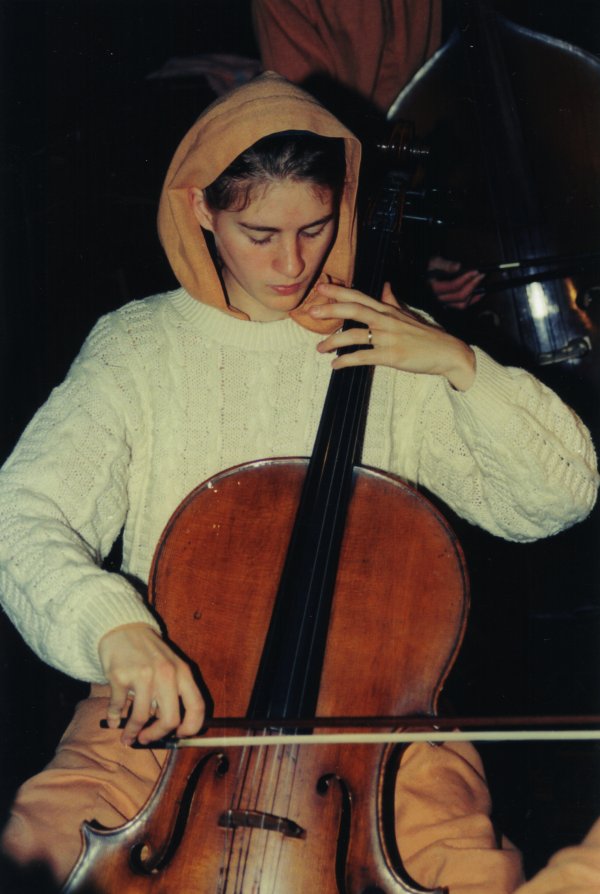
Sita Love plays cello (c. 1990).
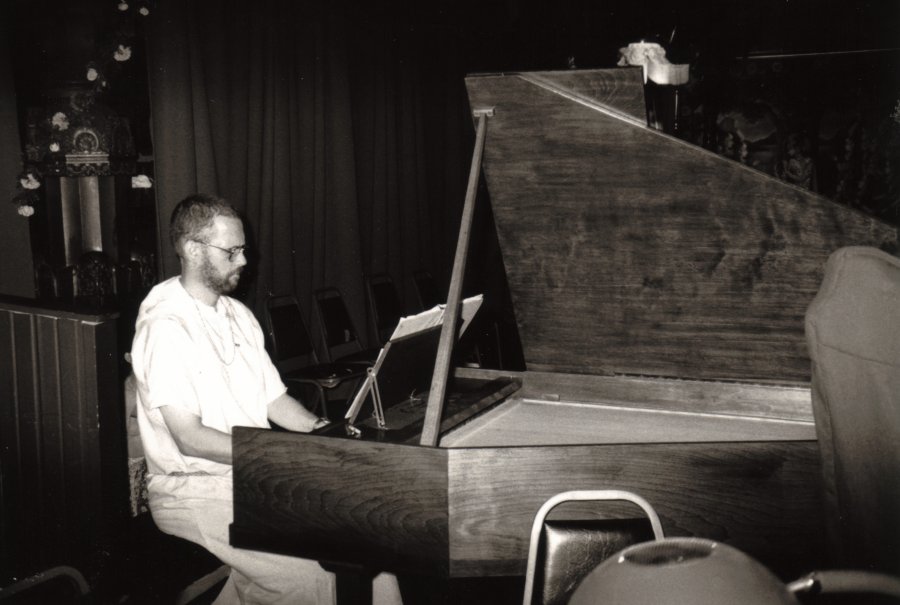
Radha Vrindaban Chandra Swami plays harpsichord (c. 1991).
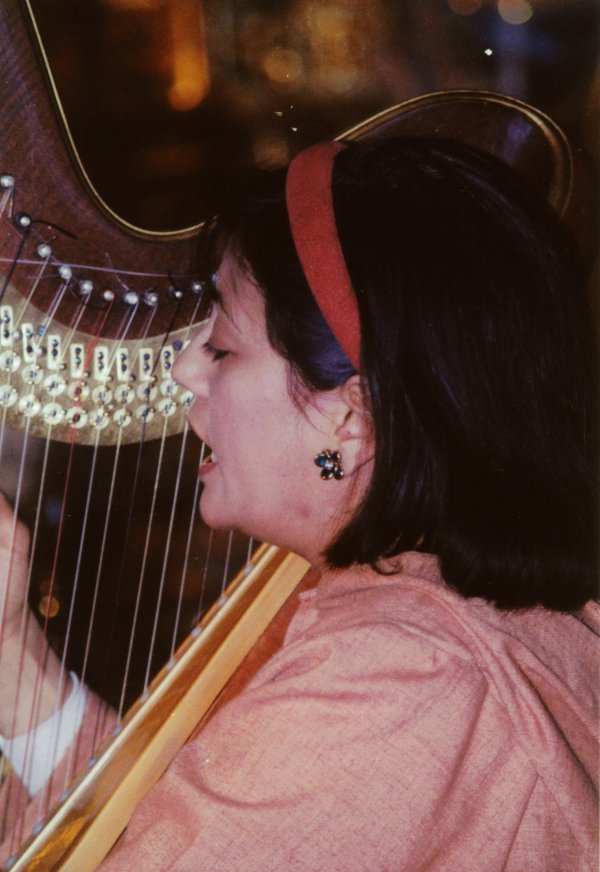
Brihan Naradiya Purana plays harp (c. 1990).
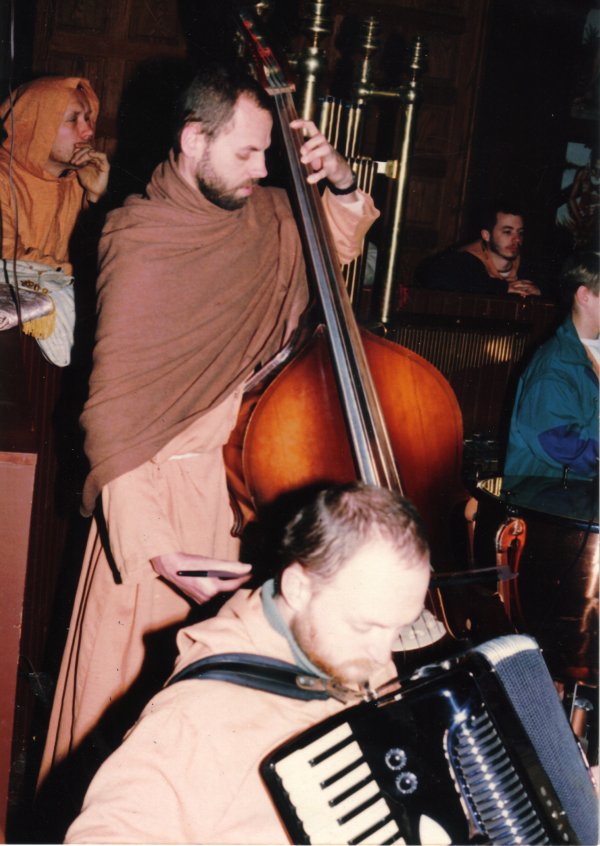
Hera Panchami plays double bass and Dutiful Rama plays accordion (c. 1990).
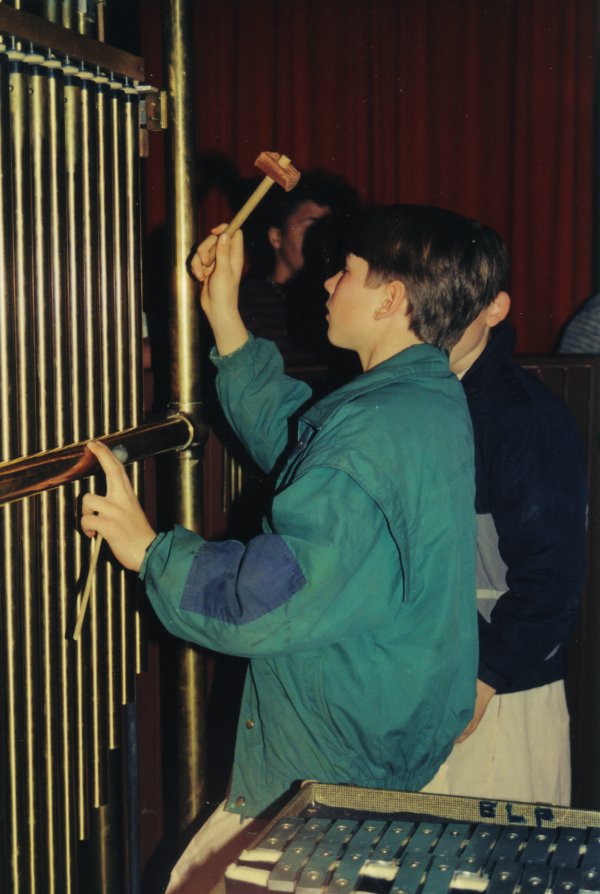
Hari Kirtan plays chimes (c. 1990).
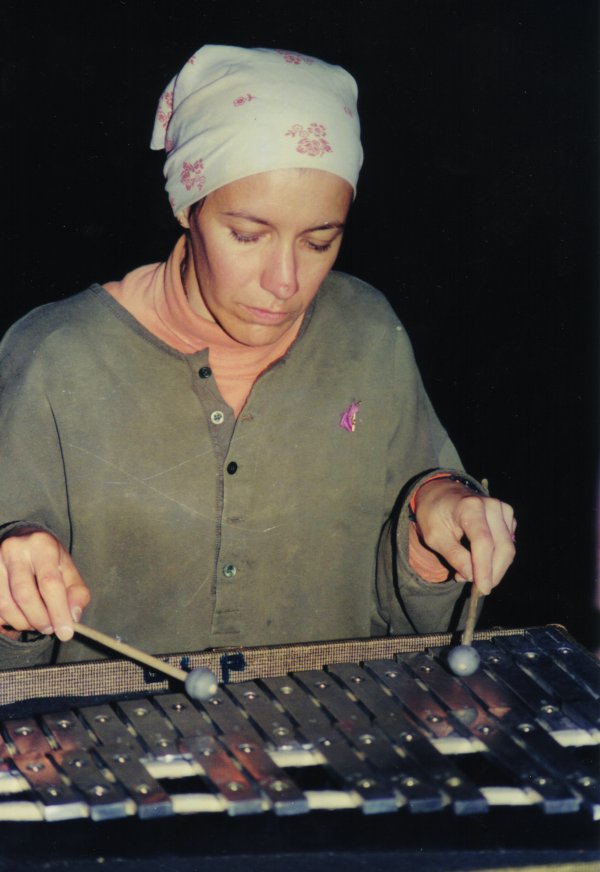
Gita Govinda plays orchestra bells (c. 1990).

As a rule, traditional Bengali-style kirtan was never prohibited, and was in fact prominently featured during Vaishnava festivals such as Janmastami when hundreds of Indian Hindu visitors packed the temple. Here Hrishikesh leads kirtan from the harmonium while Rupanuga plays mrdanga at the RVC temple (c. 1988). Umapati Swami (with danda) sits on the floor at the far right.
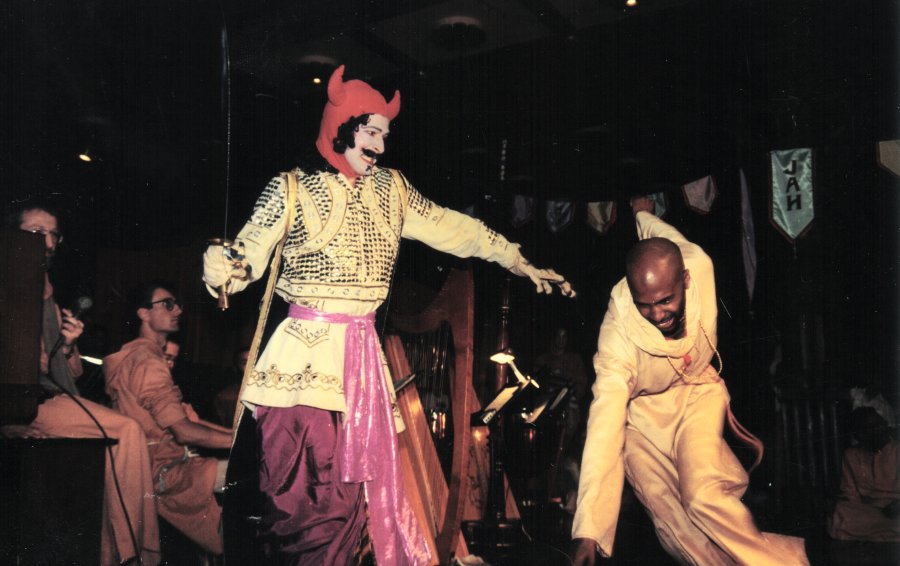
The Prince of Evil (played by Krishna Truthful) attacks our hero Devotee (played by Rupa Vilas) in the musical by Hrishikesh titled Devotee’s Journey to the City of God (October 6, 1990).

After enduring all hardships and remaining true to the straight and narrow path, Devotee finally reaches the City of God while the City of God residents—Sikhi Mahiti devi dasi, Chaitanya devi dasi and Ariel—joyfully welcome him (October 6, 1990).
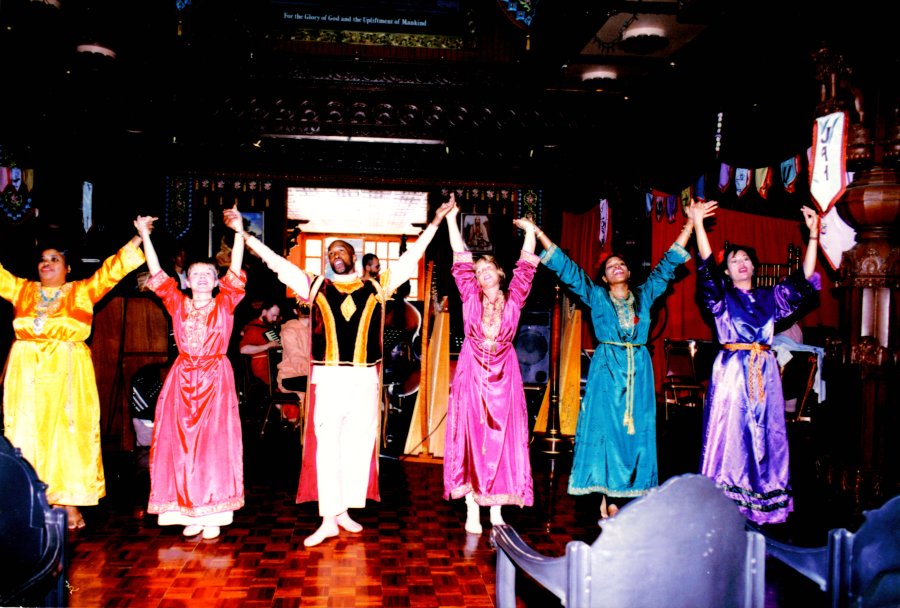
Curtain calls—Sikhi Mahiti devi dasi, Chaitanya devi dasi, Rupa Vilasa, Ariel, Bhavisya devi dasi and Brihan Naradiya Purana devi dasi (October 6, 1990).

Rupa Vilas plays Bhaktivedanta Swami Prabhupada in the second musical by Hrishikesh titled The Journey to America (November 14 1990).
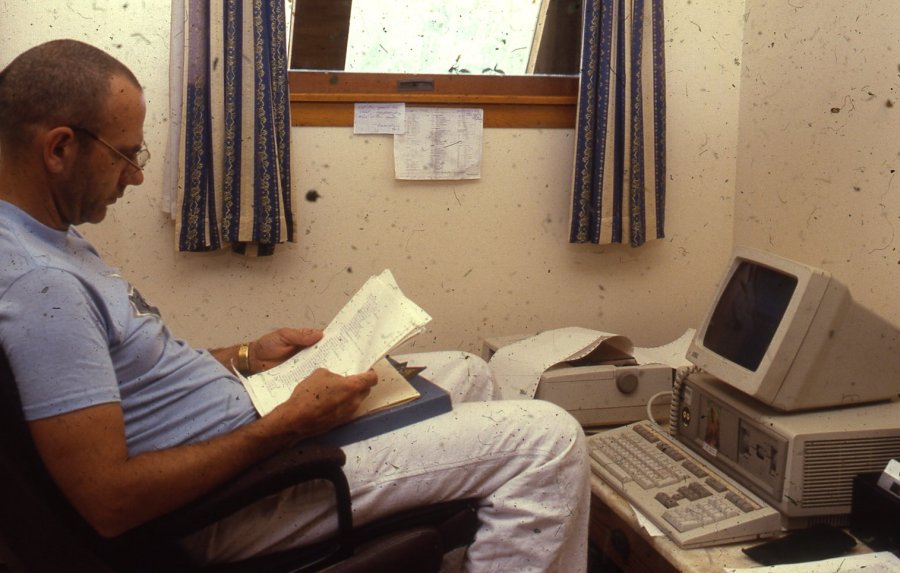
Hayagriva proofreading in his office (undated). Hayagriva wrote several excellent poetic English translations of Sanskrit and Bengali prayers. He also wrote or Krishna-ized several original hymns, such as Holy Father, Holy Mother and Hare Krishna über alles.
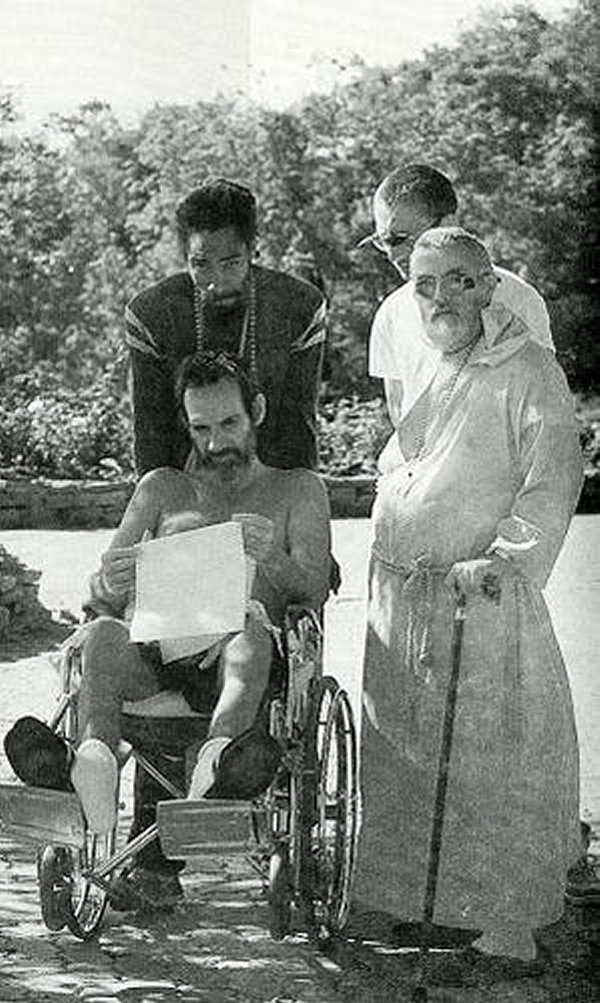
Hayagriva began wasting away from bone cancer, I think early in 1989. At this time he lived in the temple room at Bhaktipada’s house, as I recall. Whenever I came up to Bhaktipada’s house to see my spiritual master, a few times a week, I used to visit with Hayagriva as he lay on a hospital bed. In this photo, we see Hayagriva in wheelchair, Steve (his caretaker), Bhaktipada and myself. (c. May 1989)
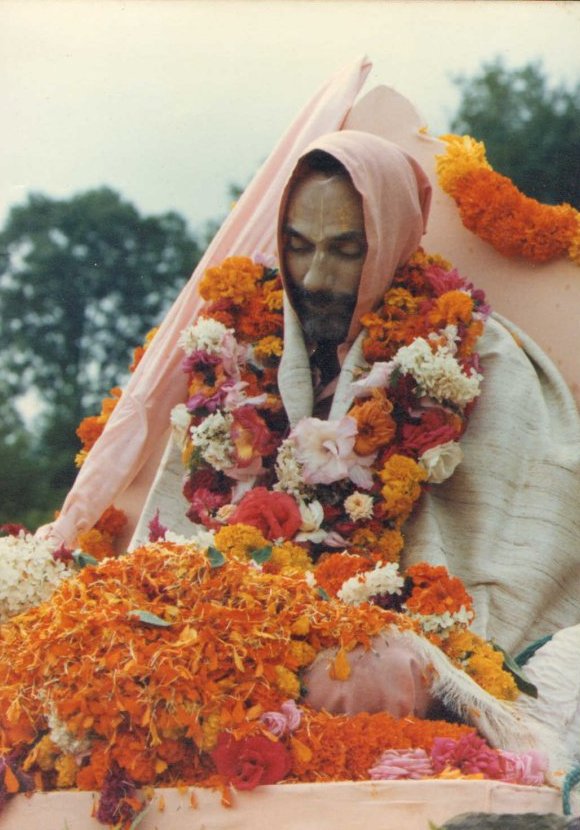
Hayagriva passed away on August 31, 1989, two days before his 50th birthday. His body was bathed, dressed in a robe, positioned in a lotus position, adorned with tilak, and garlanded with flower garlands, as befitting a “saintly sannyasi” and lover/dear friend of Kirtanananda Swami Bhaktipada.

Bhaktipada processes as Hayagriva’s body is carried from the RVC temple to his burial site near the aviary.
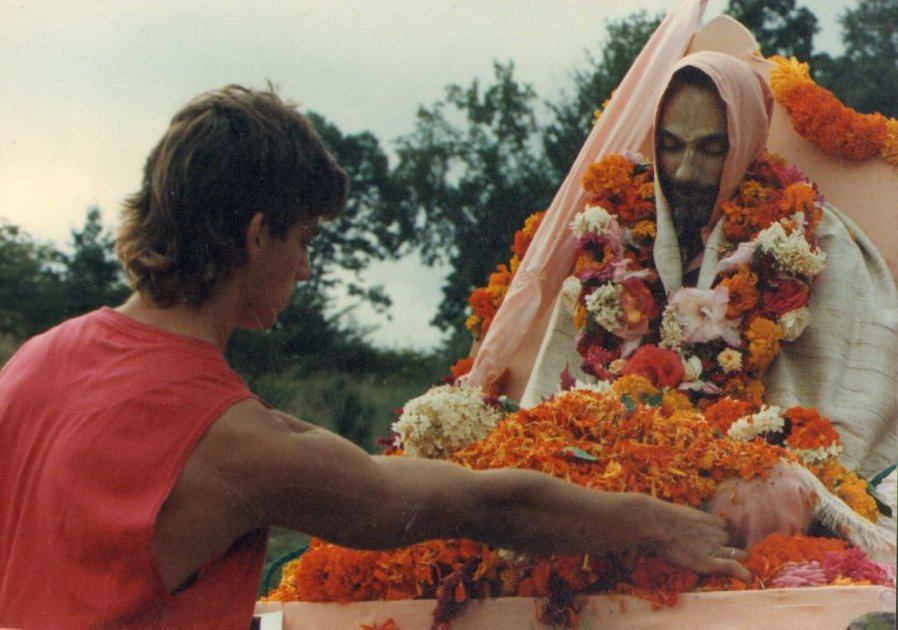
Hayagriva’s 19-year-old eldest son offers flowers to his father’s body at his funeral.
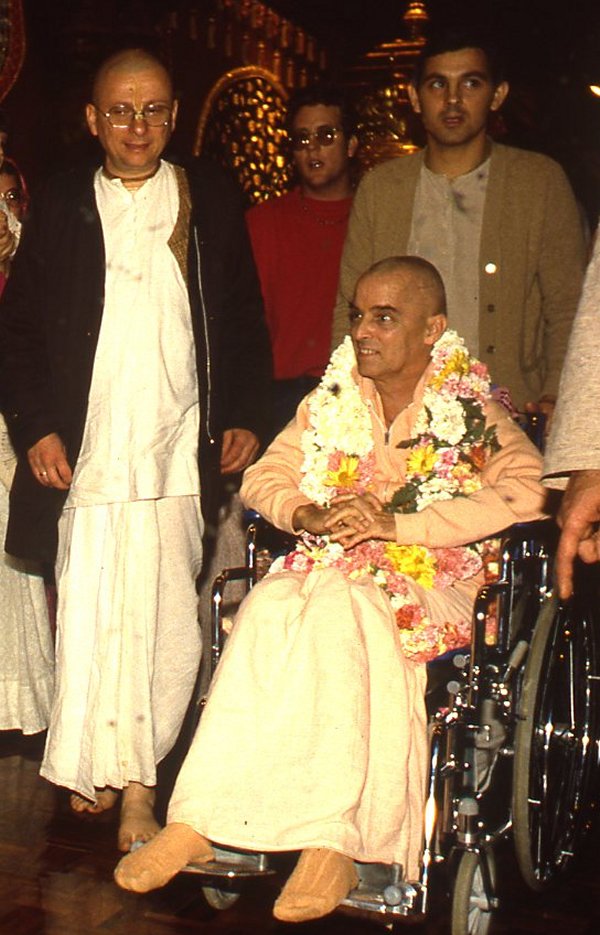
Umapati wrote several excellent poetic English translations of Sanskrit hymns. Here he and Kuladri take Bhaktipada to the RVC temple room soon after he was attacked by a deranged devotee in October 1985 (photo c. November 1985).
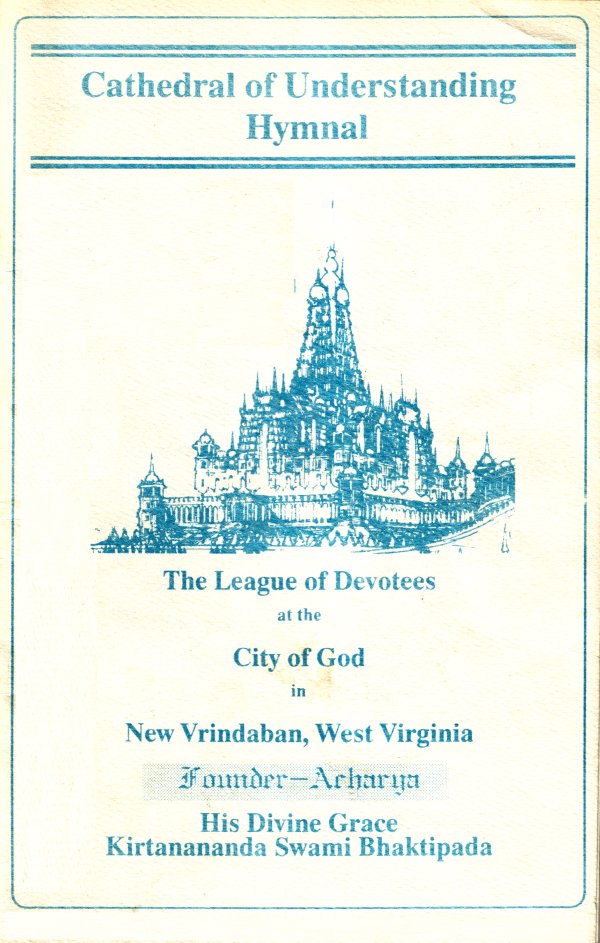
Cover of the “Cathedral of Understanding Hymnal.”
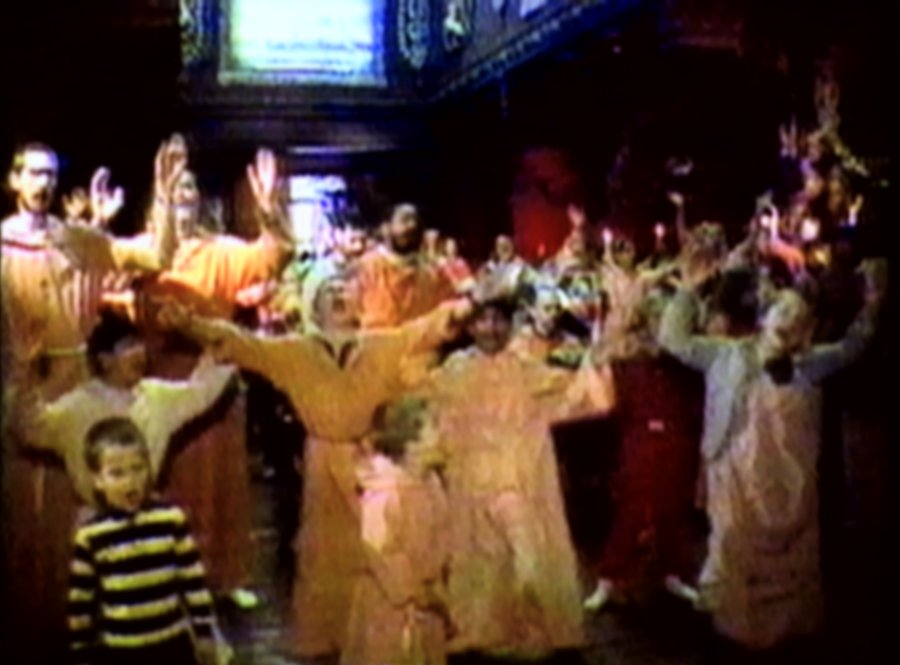
New Vrindaban residents chant and dance enthusiastically during the noon service to the accompaniment of organ and timpani.

Premarnava (on electric guitar) and Bhavisya (at the microphone) lead the Gospel Band, performing Krishna-ized gospel music at New Vrindaban festivals.
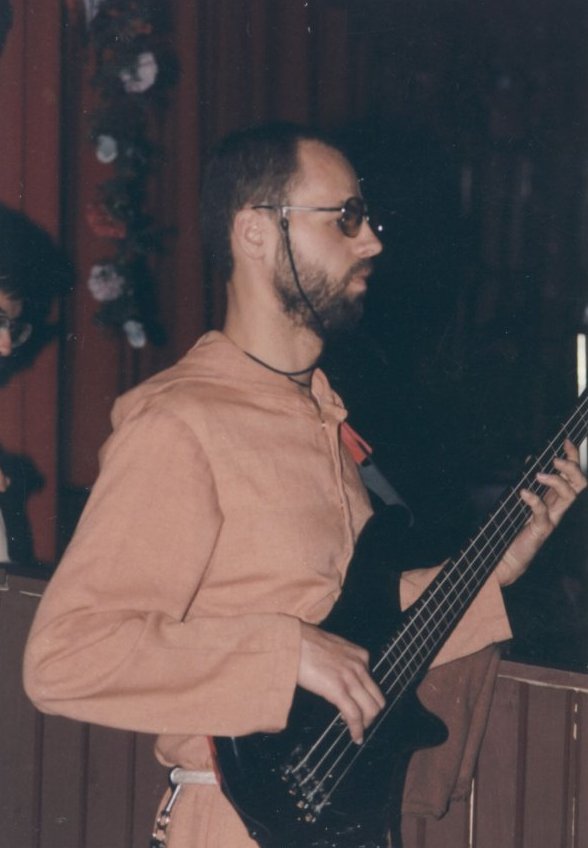
Herapanchami plays electric bass with the Gospel Band.
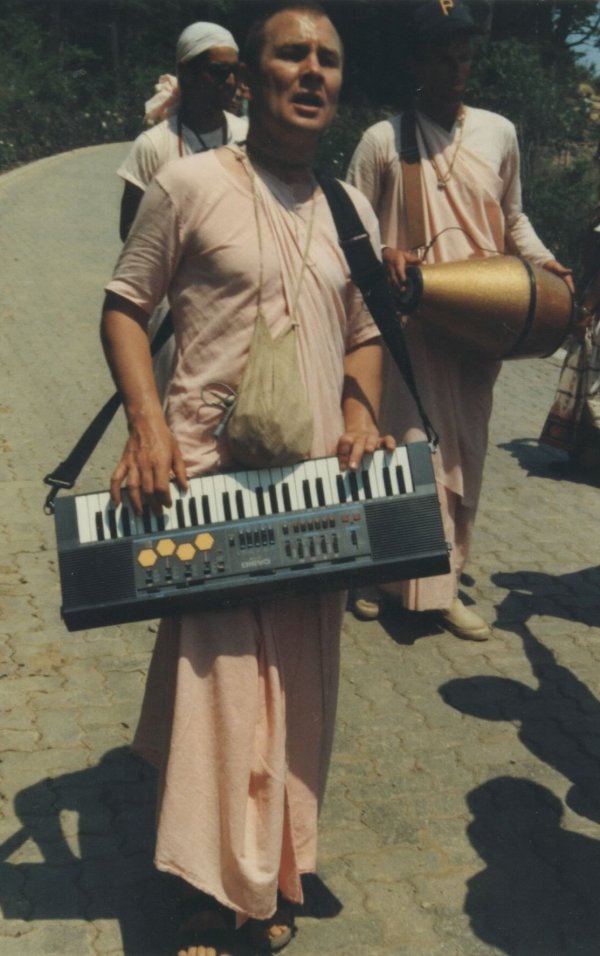
Chakravarti Swami enjoyed singing and playing the electronic keyboard. Here he leads a kirtan on the driveway at Bhaktipada’s new house. Chakravarti Swami is describe as a “saintly man” who leads “heavenly” kirtans in the Epilogue of Bhaktipada’s 1988 book Devotee’s Journey to the City of God.
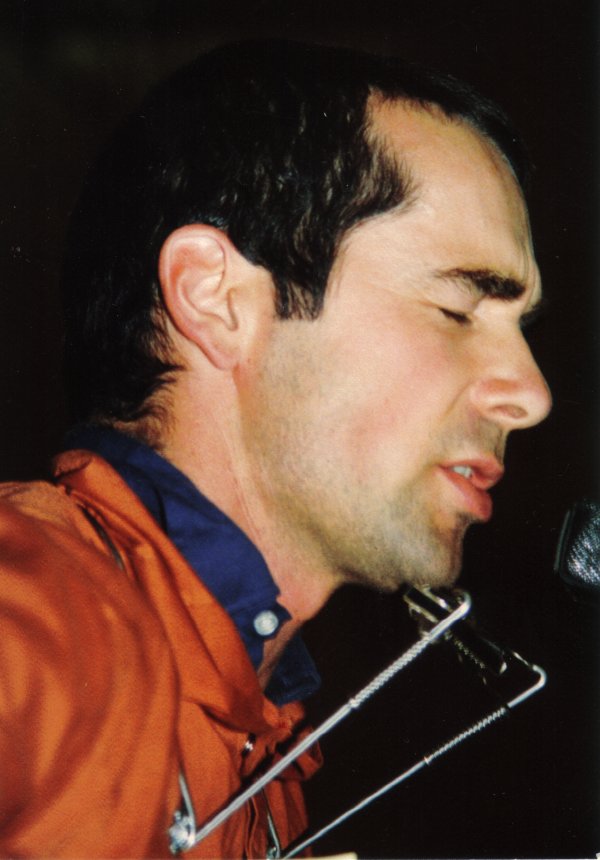
Guitarist/singer/song-writer Peaceful Swami (formerly Devananda Pandit from Toronto) often performed at festivals.
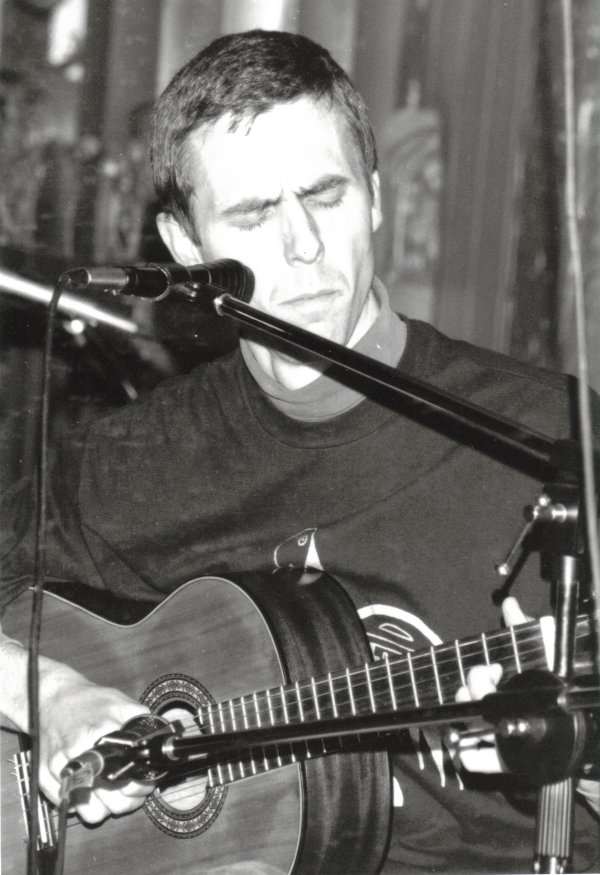
Guitarist/singer/song-writer Kripa Maya also performed at festivals. Years later he got a music degree from West Liberty State College and wrote, directed and produced a musical based on the Ramayana, which was performed in Wheeling.
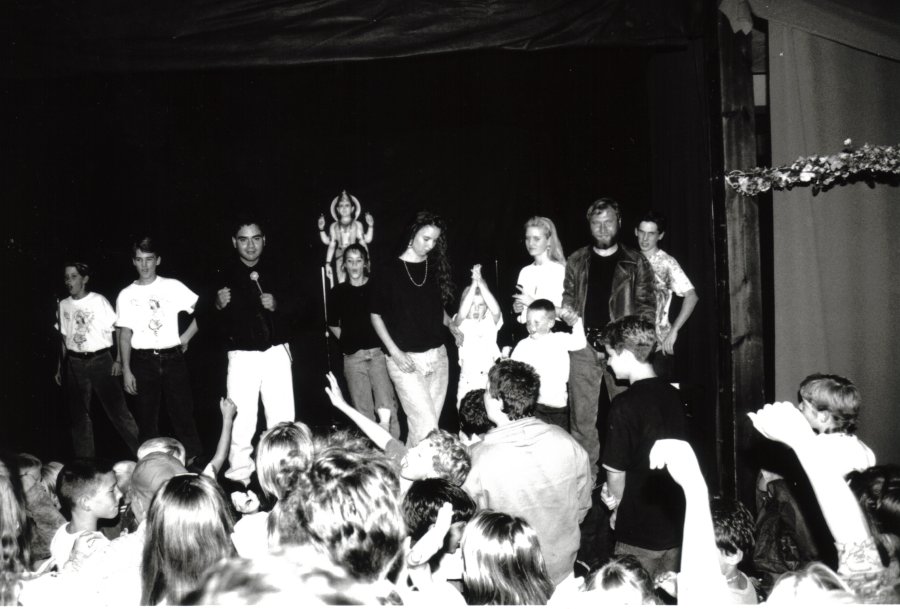
New Vrindaban’s rock band “Life Force” performs on an outdoor stage at a summer festival while a four-armed Vishnu deity watches from behind. Band founder, Chakravarti Swami (with beard), stands at right (November 2, 1992).
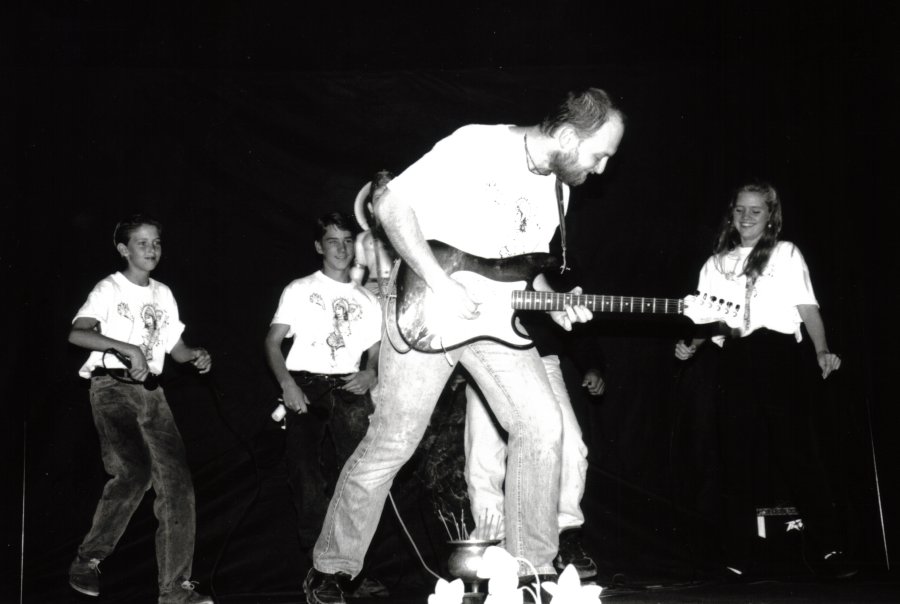
Dutiful Rama plays electric guitar in New Vrindaban’s rock band (November 2, 1992).

Bhaktipada said he wanted to root out all sources of passion and ignorance in New Vrindaban and replace them with goodness. He asked devotees to give up driving their cars in the community and ride bicycles or horses instead. He purchased a horse-drawn buggy which he used for a time (until he got in a bad accident) to ride around the community. Here he gives his horse a tasty treat (undated).

Bhaktipada first wore a Franciscan-style monk’s robe during his 50th birthday celebration on September 7, 1987. Soon many New Vrindaban residents began wearing the robes, such as Dhirodatta dasa (David Soliday) and his ashram of five gurukula boys.
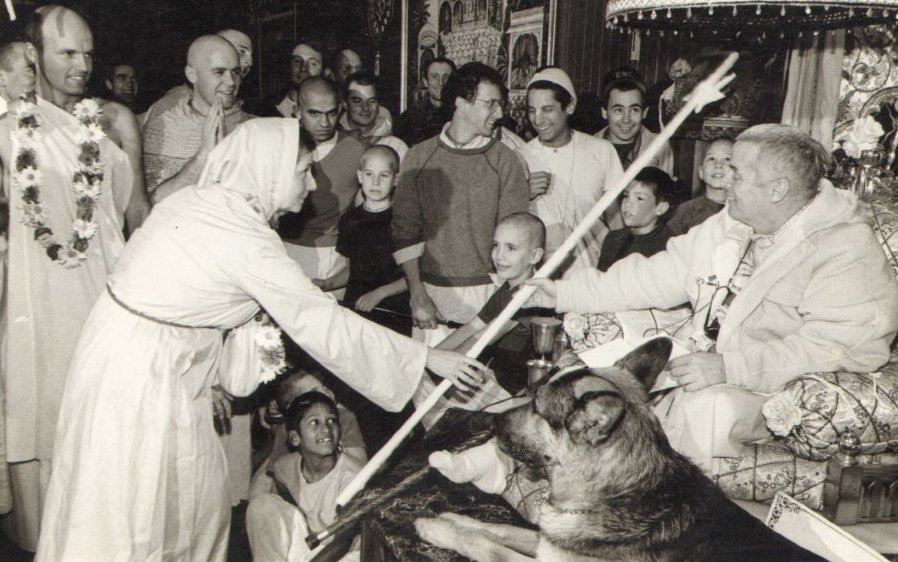
New Vrindaban’s first female sannyasi, Ishvara Swami (Ilavati devi dasi/Evelyne Sheffey), accepts her danda, while Gudakesh looks on (November 16, 1987).
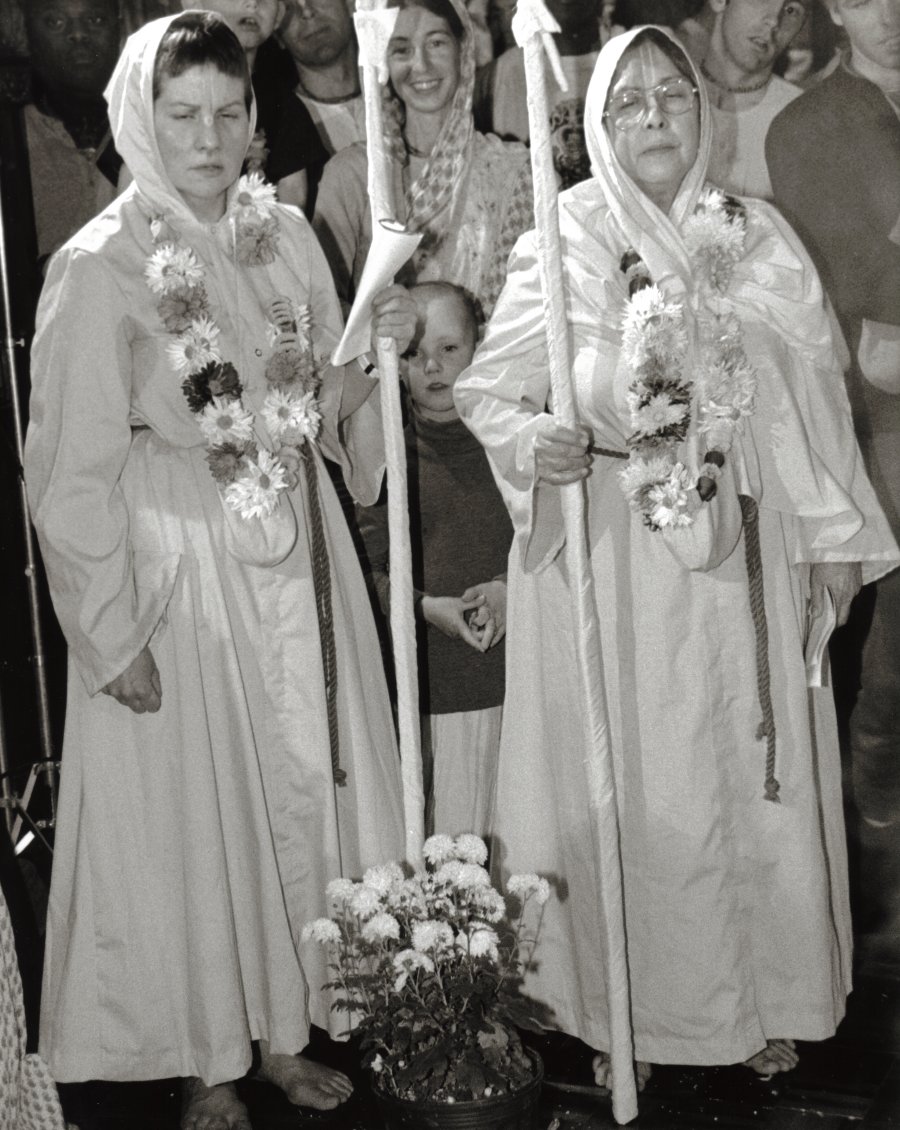
Ishvara Swami and Ananta Swami (Adhara devi dasi/Elba Noriega) in a solemn mood (November 16, 1987).
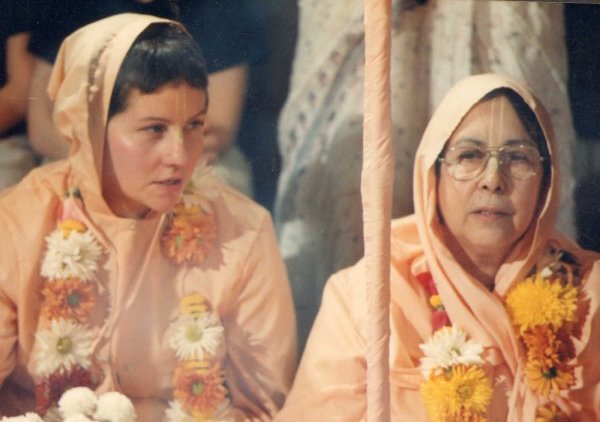
Ishvara Swami and Ananta Swami (November 16, 1987). During the next six years, Bhaktipada initiated about a dozen women into the renounced order.
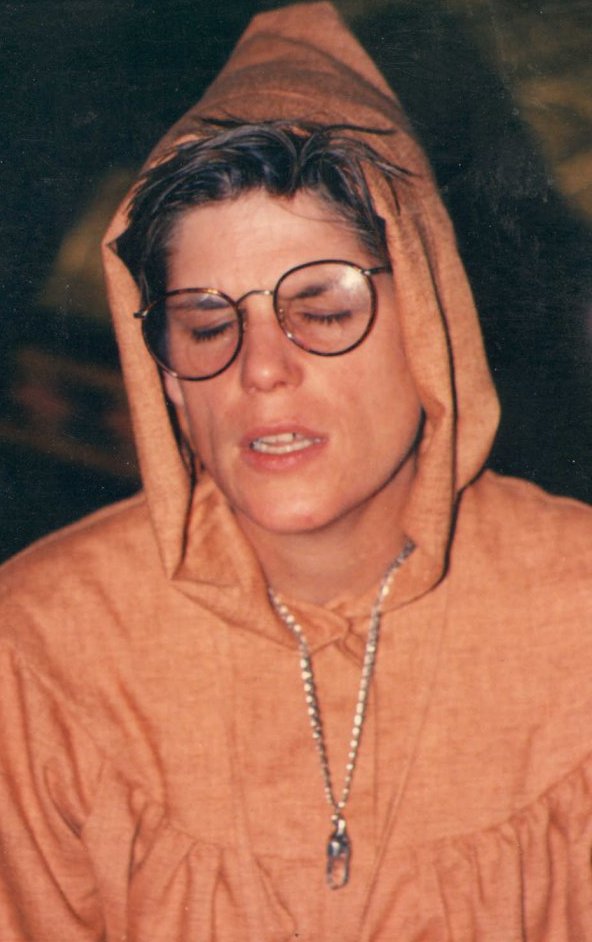
Malati Swami (Melanie Nagel) also accepted sannyasa from Bhaktipada (c. 1992). Later, after she renounced her sannyasa title, she became a GBC representative for New Vrindaban.

Artist’s painting of the proposed Great Temple of Understanding at New Vrindaban in South-Indian Dravidian style (c. 1985).
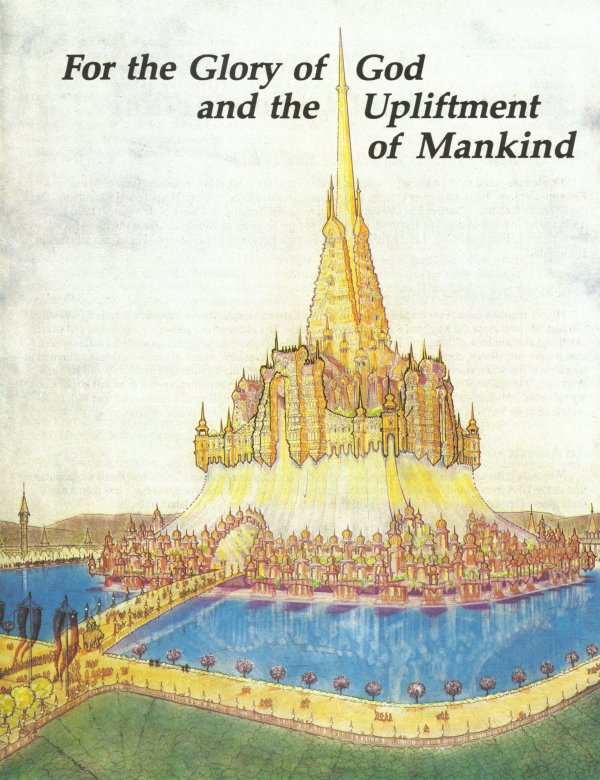
Artist’s rendition of the proposed Cathedral of Healing in mixed style (partly South-Indian, partly modernistic) with glass spire and glass base: temple, hospital and health spa—all under one roof (1988).
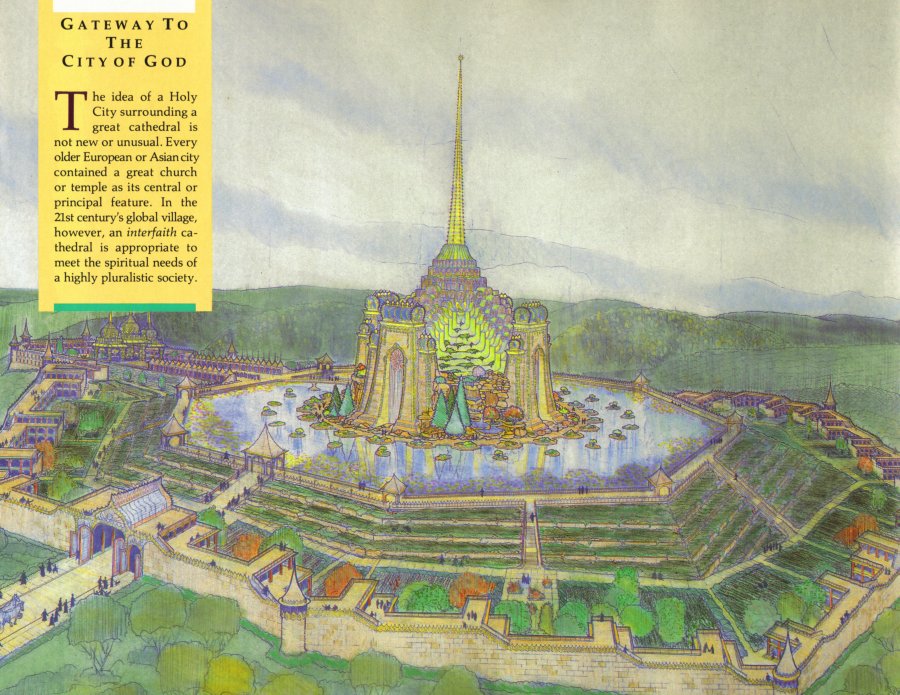
The temple design evolves further and incorporates organic and Native-American design elements: Artist’s rendition of the proposed Cathedral of the Holy Name (c. 1989).

Artist’s rendition of the proposed Cathedral of the Holy Name (c. 1990).
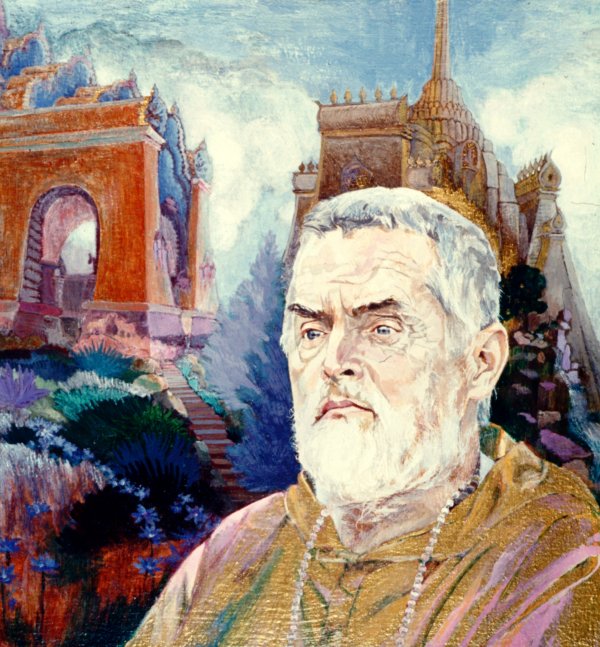
Painting of Bhaktipada and the proposed Cathedral of the Holy Name (c. 1990). I think the artist was Good Hope (Gennedy), a Bhaktipada disciple from the U.S.S.R.
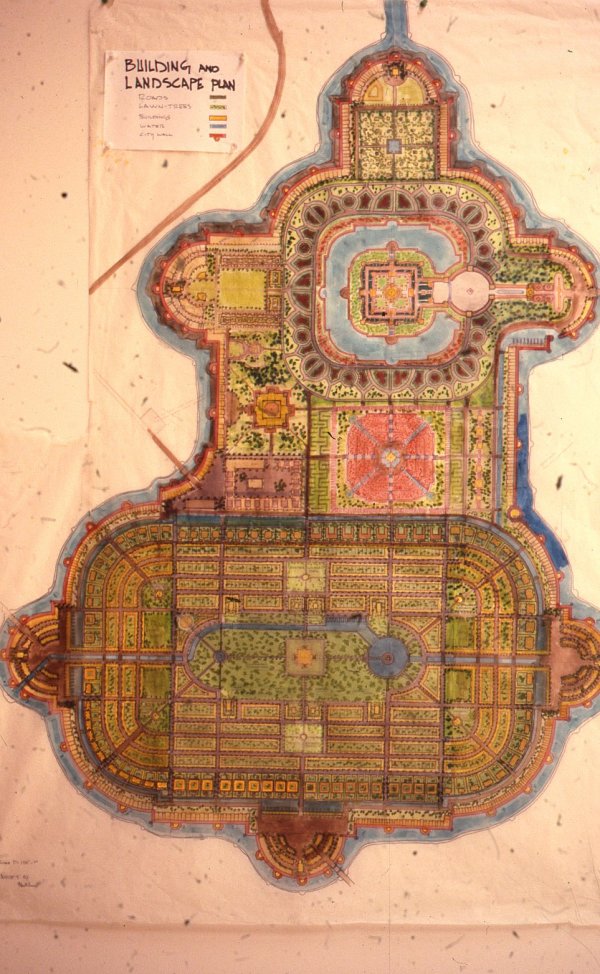
Plan for the proposed City of God at New Vrindaban (c. 1988).

Artist’s rendition of the proposed City of God at New Vrindaban (c. 1988).

Artist’s rendition of the proposed City of God at New Vrindaban (c. 1988).
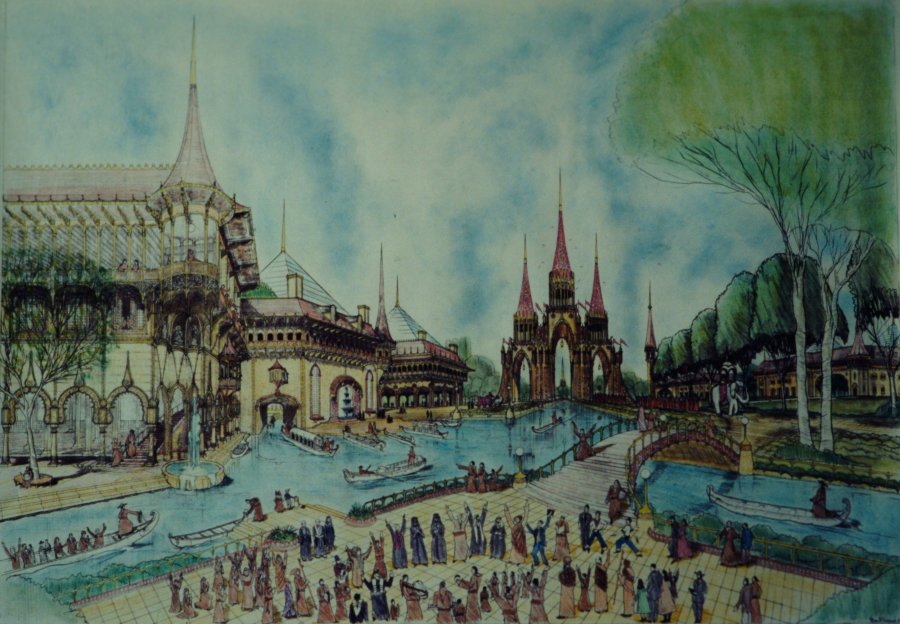
Artist’s rendition of the proposed City of God at New Vrindaban (c. 1988).
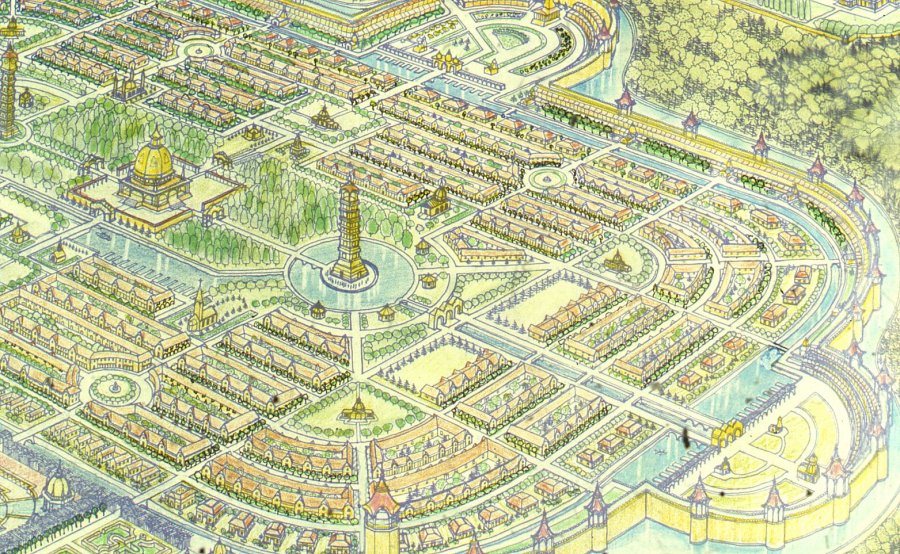
Artist’s rendition of the proposed City of God at New Vrindaban (c. 1988).
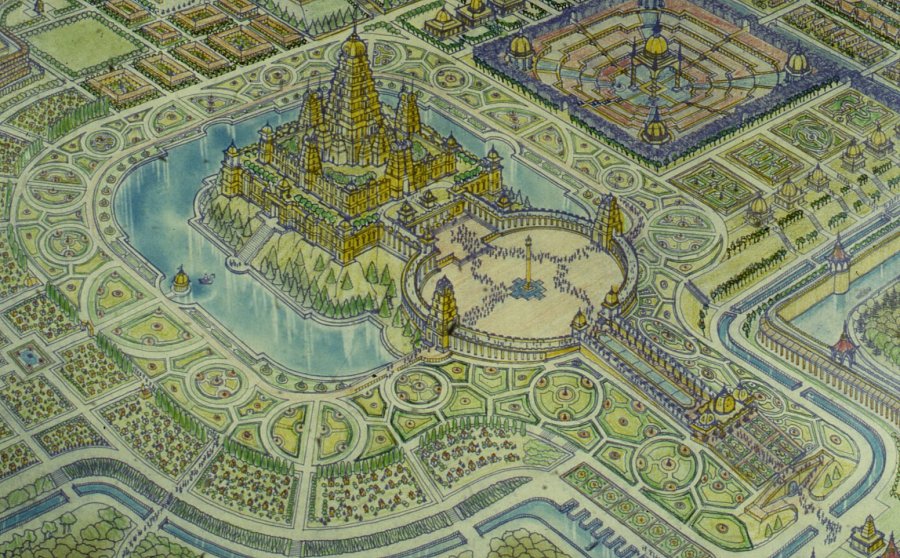
Artist’s rendition of the proposed City of God at New Vrindaban (c. 1988).
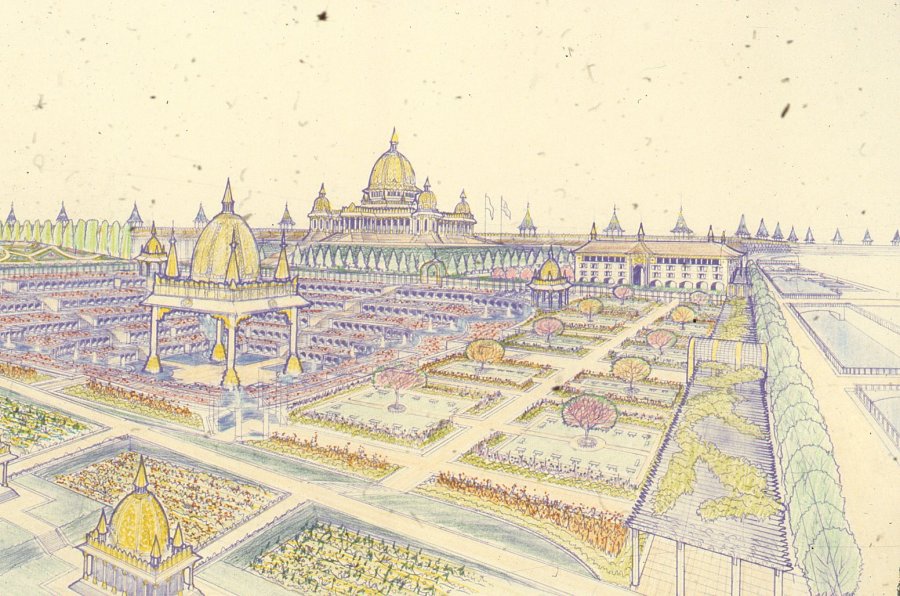
Artist’s rendition of the proposed City of God at New Vrindaban (c. 1988).
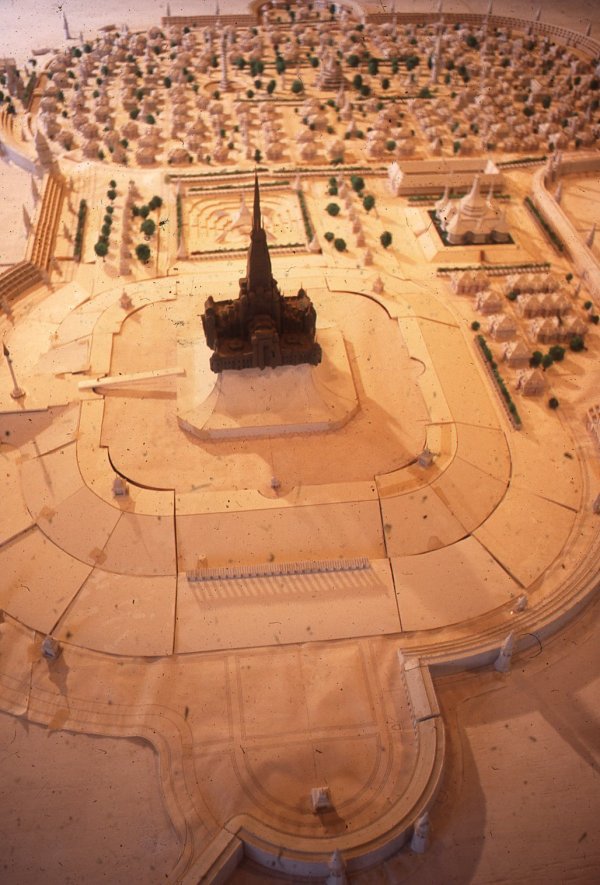
Model of the proposed City of God at New Vrindaban (April 25, 1988).
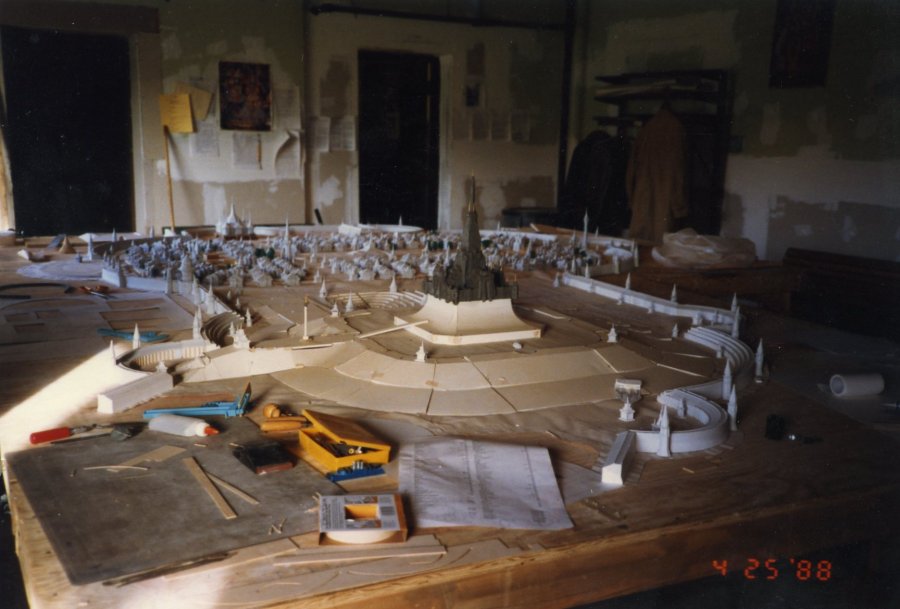
Model of the proposed City of God at New Vrindaban (April 25, 1988).

Model of the proposed City of God at New Vrindaban (April 25, 1988).
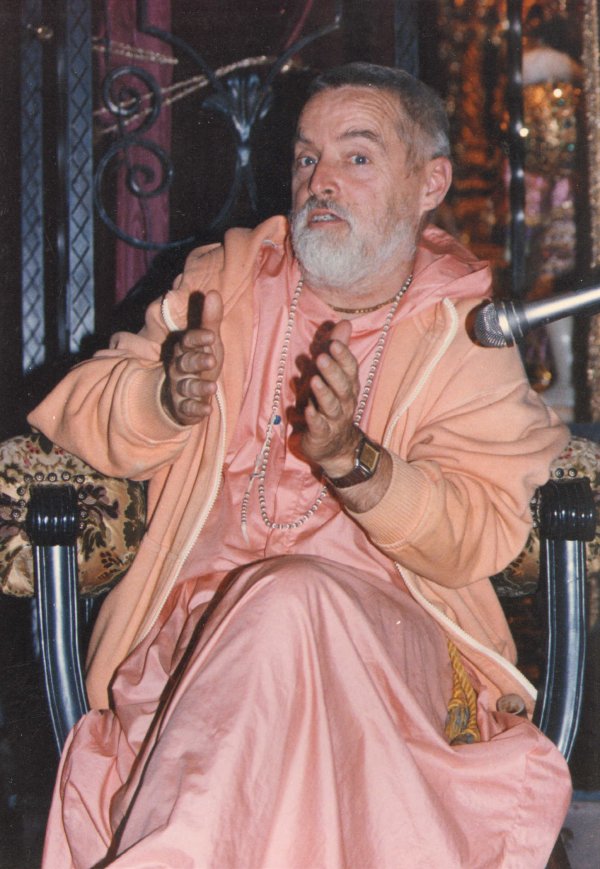
Bhaktipada preaches in the temple.
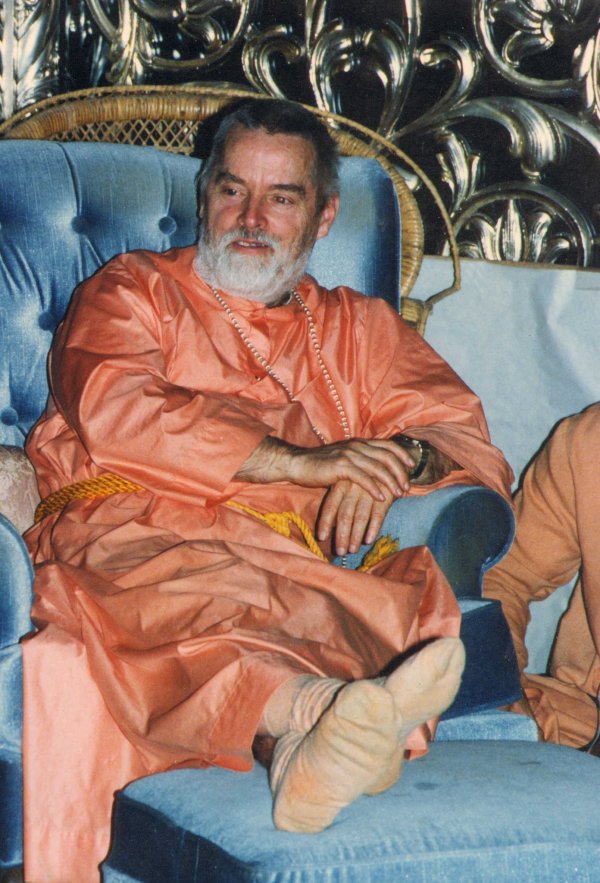
Bhaktipada relaxes and gives darshan to his disciples and followers in the temple room at his house following the evening service.

Paramahansa Krishna Swami served as the primary organizer of interfaith events at New Vrindaban and also as a spokesman for the community during the interfaith City of God era.
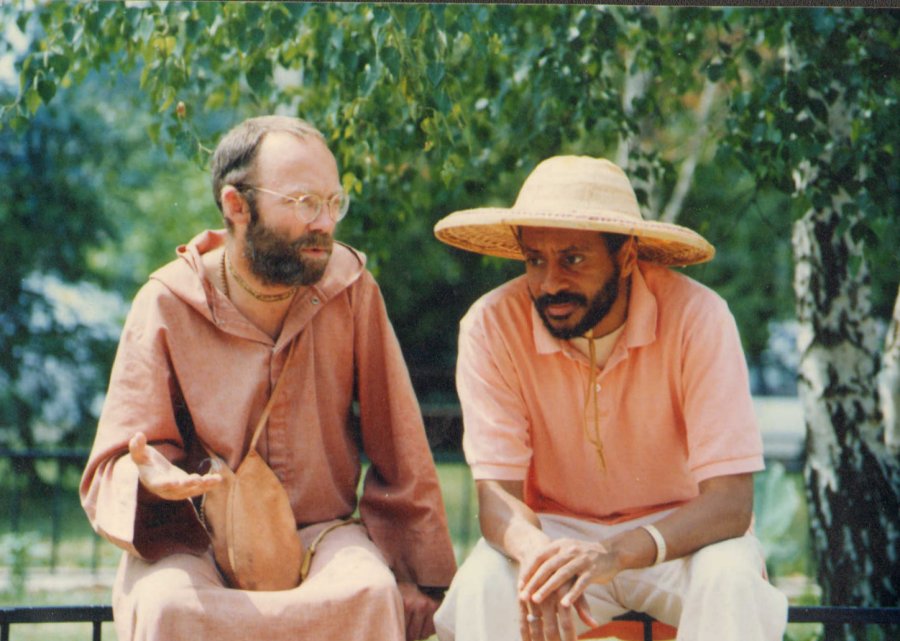
Two important men at New Vrindaban: Paramahansa Krishna Swami and temple president/sankirtan leader Devamrita Swami sit on the wrought-iron railing in front of the RVC temple and discuss important matters.

Rabbi Gelberman speaks to New Vrindaban residents (including Radhanath Swami and Ananta Swami) and visitors on the lawn near the New Vrindaban temple (undated).
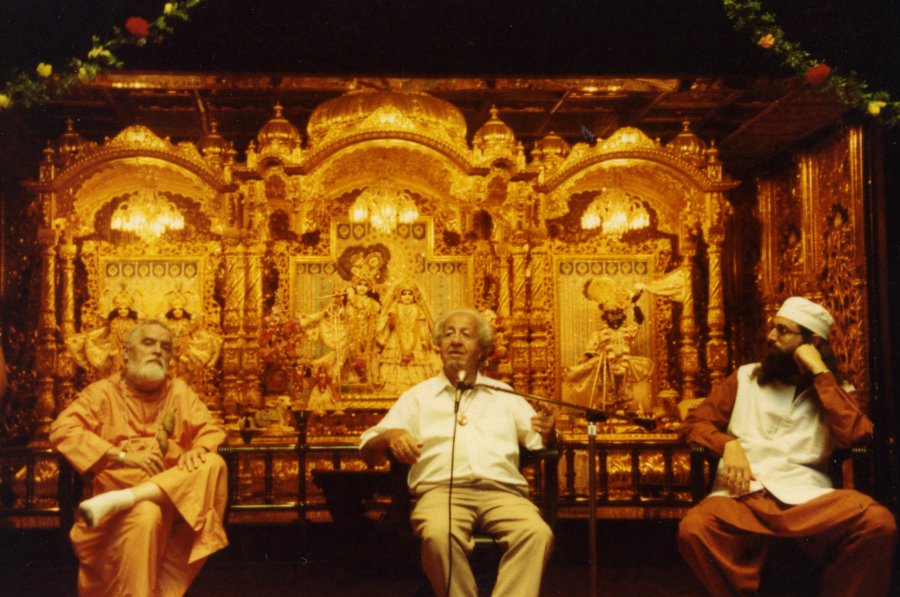
Bhaktipada with Rabbi Gelberman and Sheik Din at a New Vrindaban interfaith conference (undated).
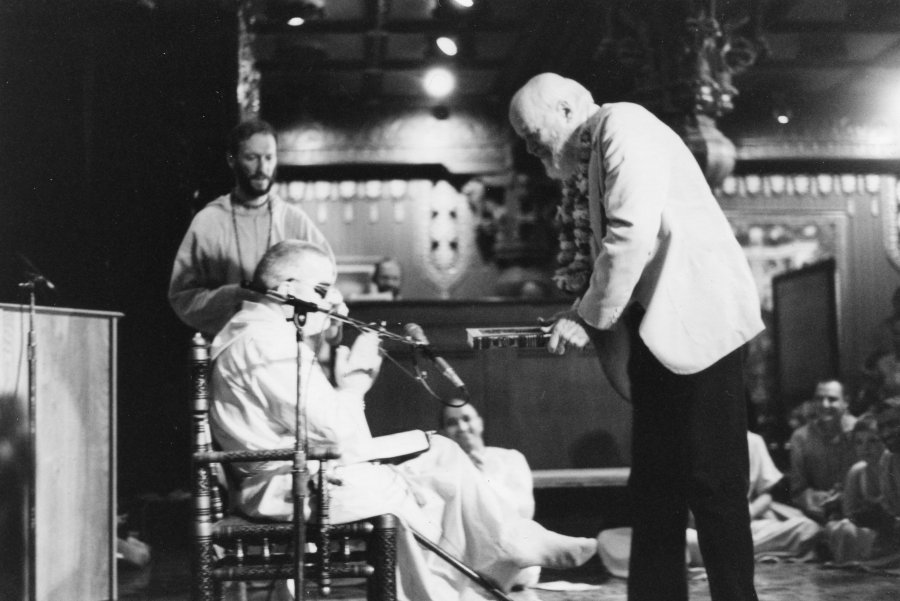
Brother Daniel Wright visits from the Padanaram Community in Indiana, while New Vrindaban publicity spokesman Gadadhar (Joel Chalson) observes. Brother Daniel is holding in his hands Bhaktipada’s book The Illustrated Ramayana, apparently a gift from Bhaktipada.

Grandmother Pa’Ris’Ha visits from her rural retreat “Friendship Village” near Summerfield, Ohio.
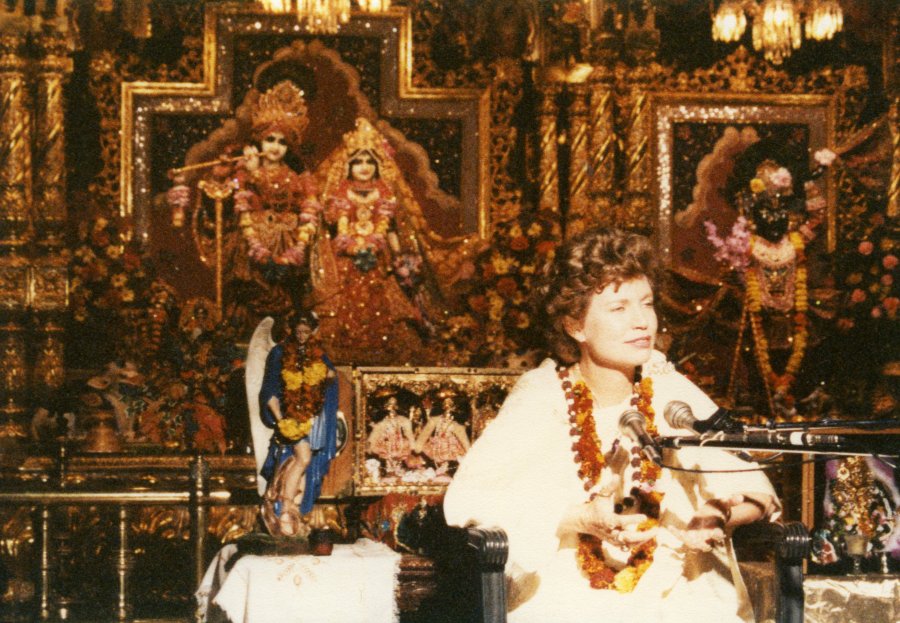
Elizabeth Clare Prophet, the founder of Church Universal and Triumphant at the Royal Teton Ranch outside of Yellowstone National Park, near Gardiner, Montana, also spoke at New Vrindaban. Bhaktipada and I especially liked her theory about styles of music and their relative effects on people according to the modes of nature.
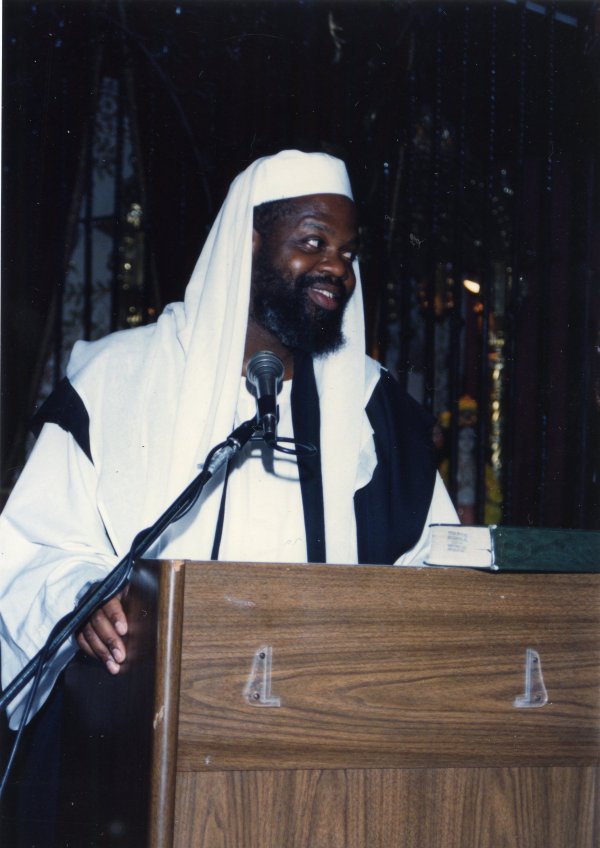
Imama Al-Hajj Talib ’Abdur-Rashid, the founding Amir of the Mosque of Islamic Brotherhood, Inc. visits New Vrindaban.

Lakota Chief Charles Chipps, with Dog Man and Fantuzzi at New Vrindaban.

Justin Wing and Laura Morningstar assemble the frame for a sacred Rock Lodge, while Murti Swami sits with two children (May 1991).
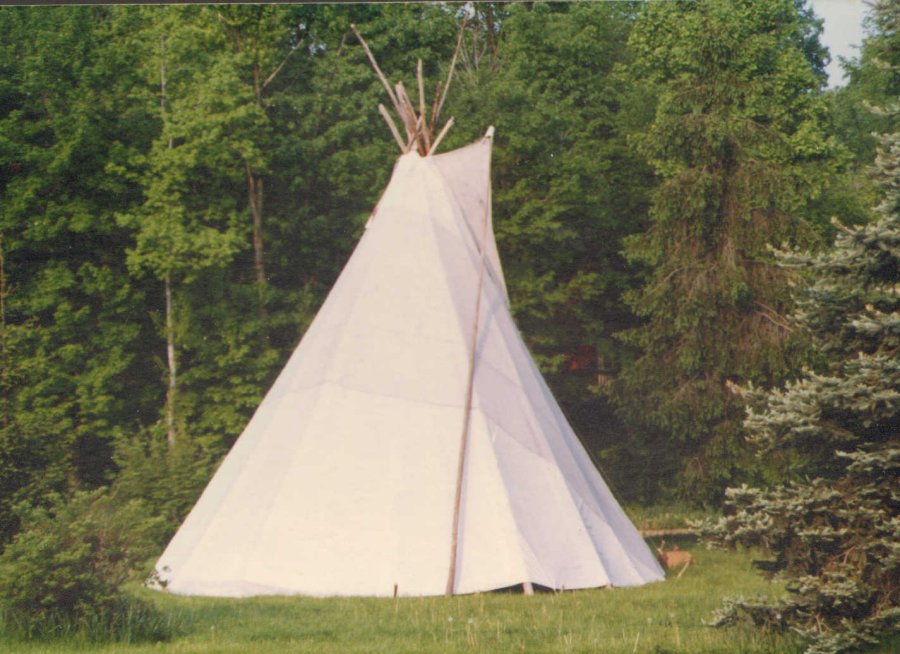
Native American teepee at New Vrindaban (May 1991).
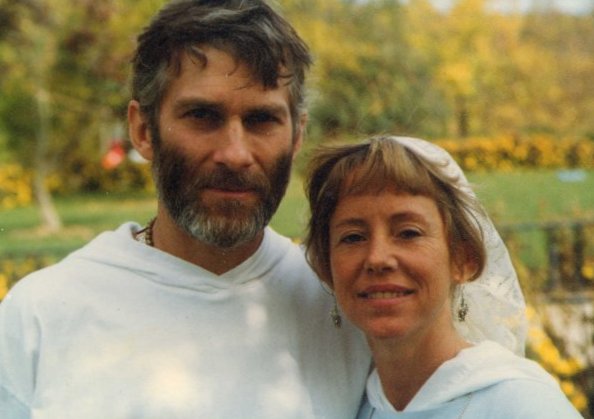
City of God Interfaith members Aravinda and Ariel Fawley.
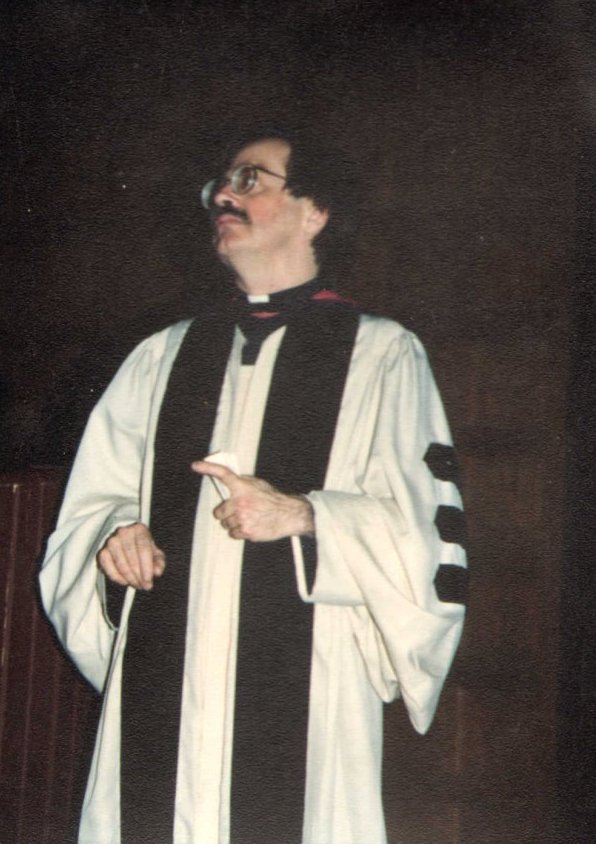
City of God Interfaith member and Unitarian Universalist Minister Rev. George David Exoo (February 1991).
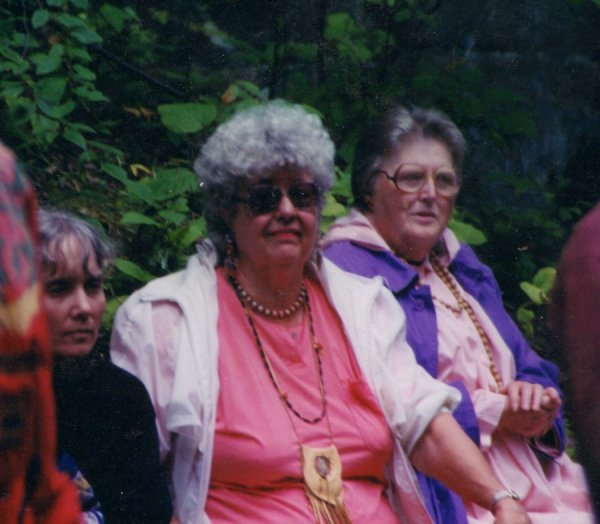
City of God Interfaith member Sister Piety (Mary Lou Sherwood) (center) with Krishna devotees Mahati dasi (Murti Swami’s former wife) and Bhakti Joy at Bhaktipada’s appearance day celebration at Silent Mountain (September 5, 1994).
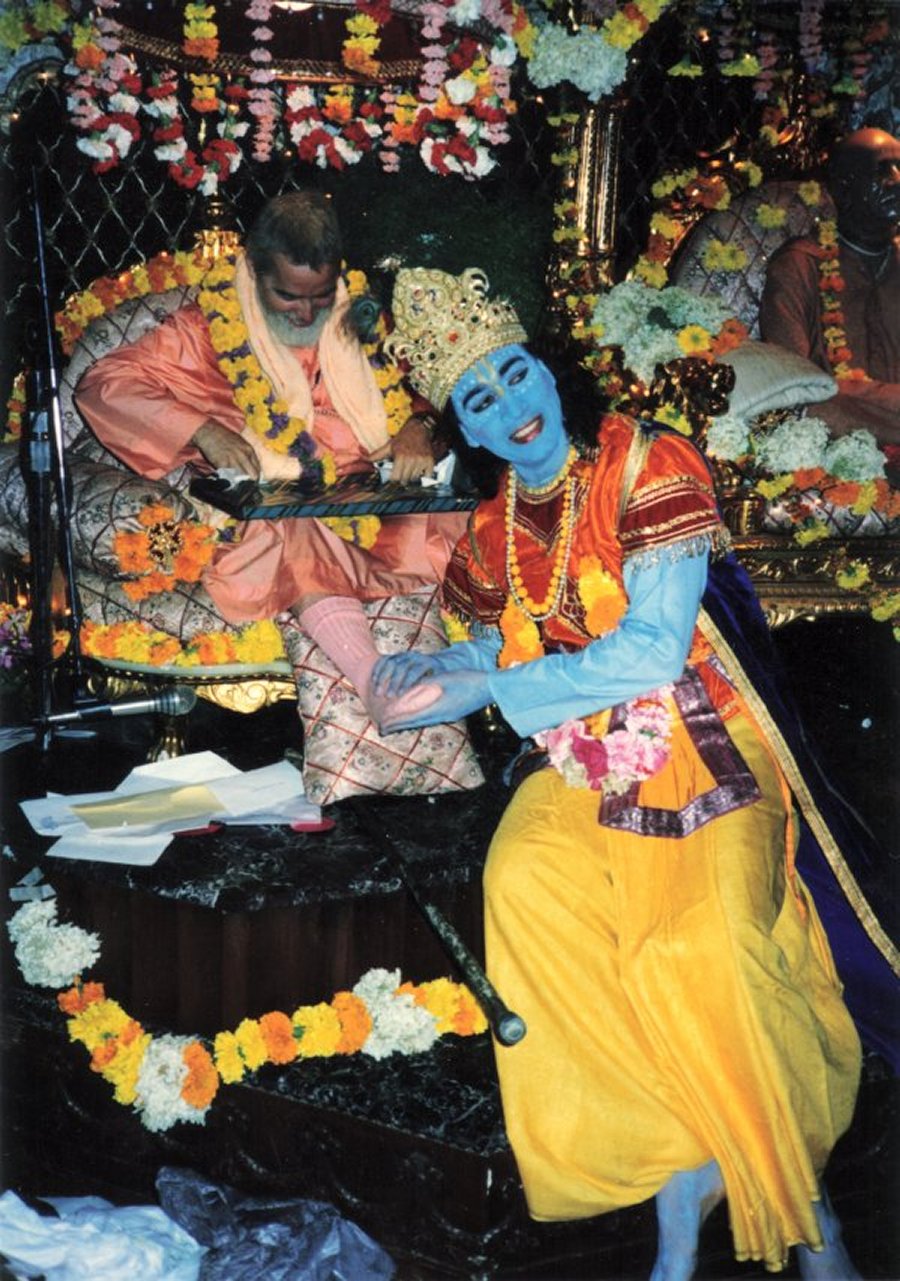
While Bhaktipada eagerly opens his birthday presents, his Indian disciple Pradyumna dresses as Lord Krishna and massages Bhaktipada’s feet during his 53rd birthday celebration (September 3, 1990).
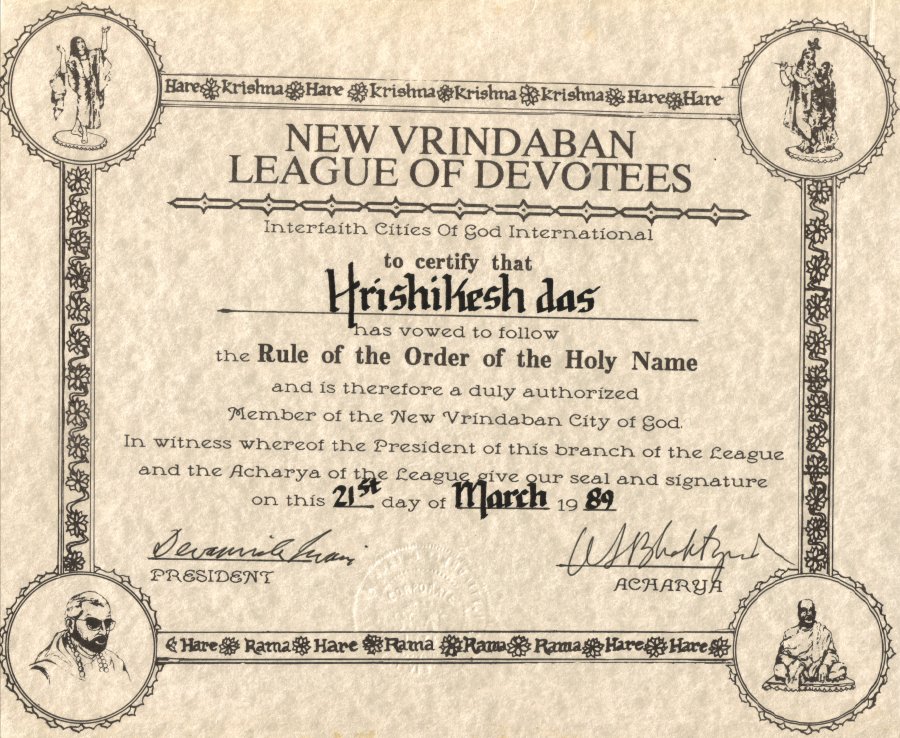
Hrishikesh’s official “New Vrindaban League of Devotees Interfaith Cities of God International” certificate in which he vows to follow The Rule of the Order of the Holy Name and is therefore duly authorized as a Member of the New Vrindaban City of God; signed by President Devamrita Swami and Acharya Kirtanananda Swami Bhaktipada (Gaura Purnima—March 21, 1989).
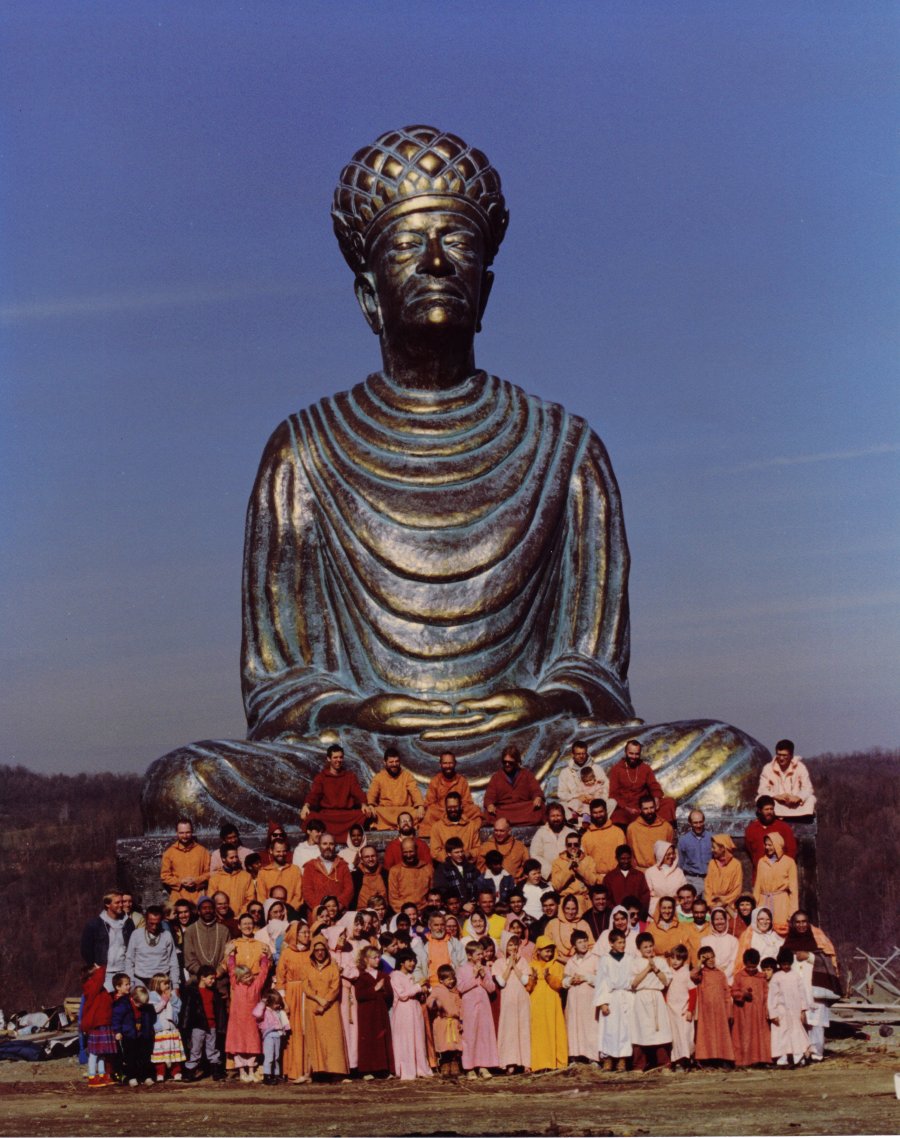
The dedication of the giant statue of Bhaktivedanta Swami Prabhupada, with Bhaktipada front and center, surrounded by his disciples and followers, on the 13th anniversary of Prabhupada’s disappearance (November 14, 1990).
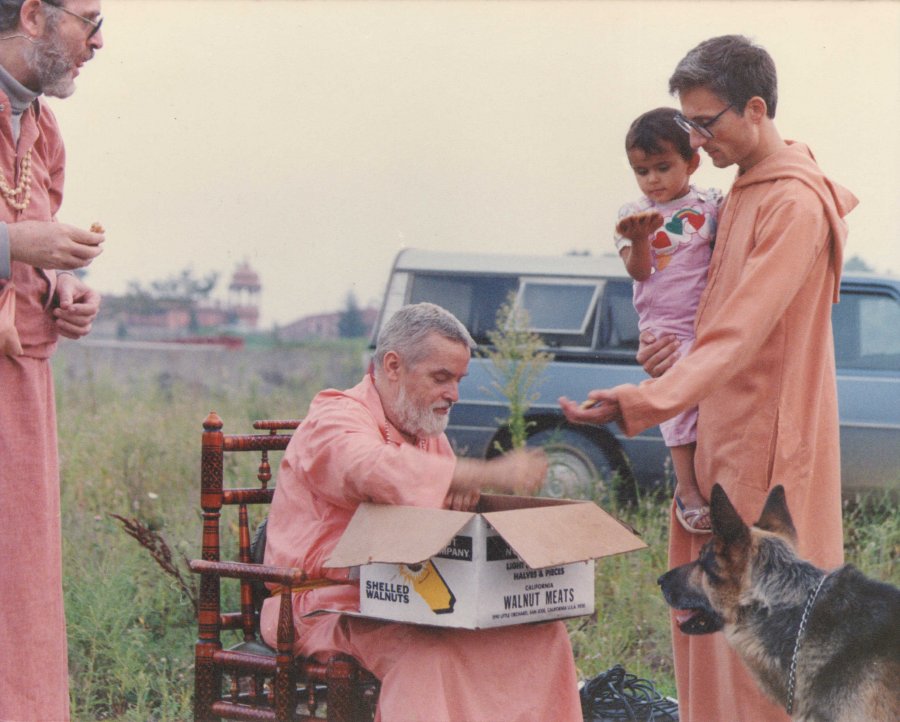
Each evening during the summer of 1990, after work was finished on the giant statue of Bhaktivedanta Swami Prabhupada behind the Palace, Bhaktipada passed out cookies to the workers. Here Hrishikesh accepts a cookie from Bhaktipada. His two-year-old daughter already has a cookie in her hand. It appears Murti Swami is munching on a cookie, and Gudakesh patiently waits his turn (September, 1990). In the background is Hrishikesh’s pickup truck, and the wall and chatra of Prabhupada’s Palace.

Hrishikesh and Shyama dasi were married on June 4, 1986. I believe Bhaktipada arranged this marriage in part because he wanted to unite the east and the west by getting his American and Indian disciples married to each other. Pradyumna from India and Lilavati from the United States were also married about the same time and serve as another example of an international interracial arranged marriage.
| Back to: Gold, Guns and God |